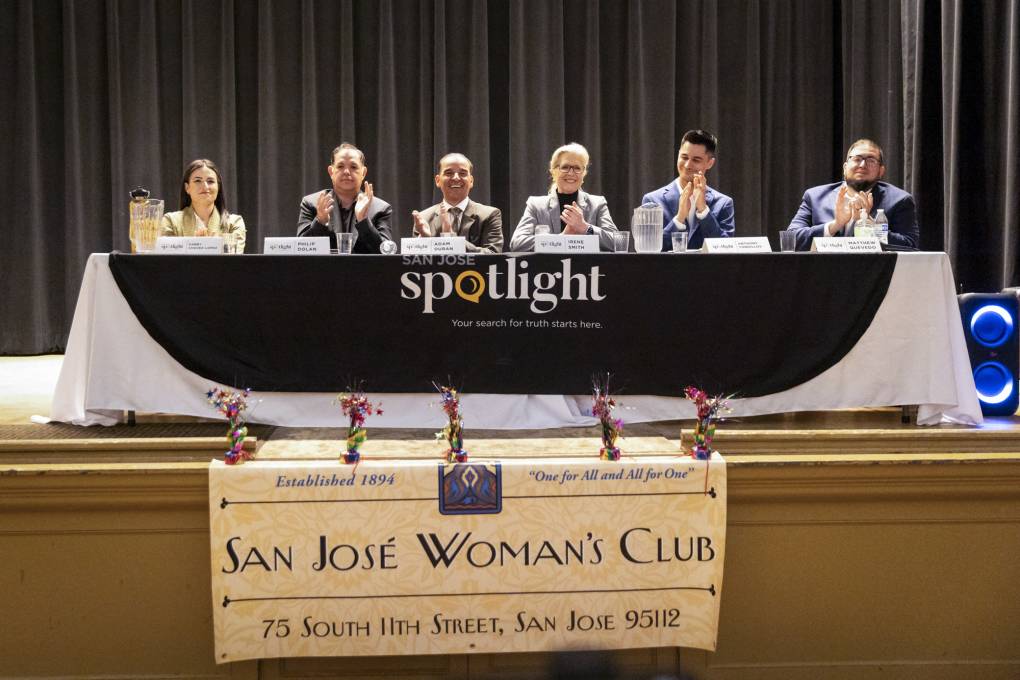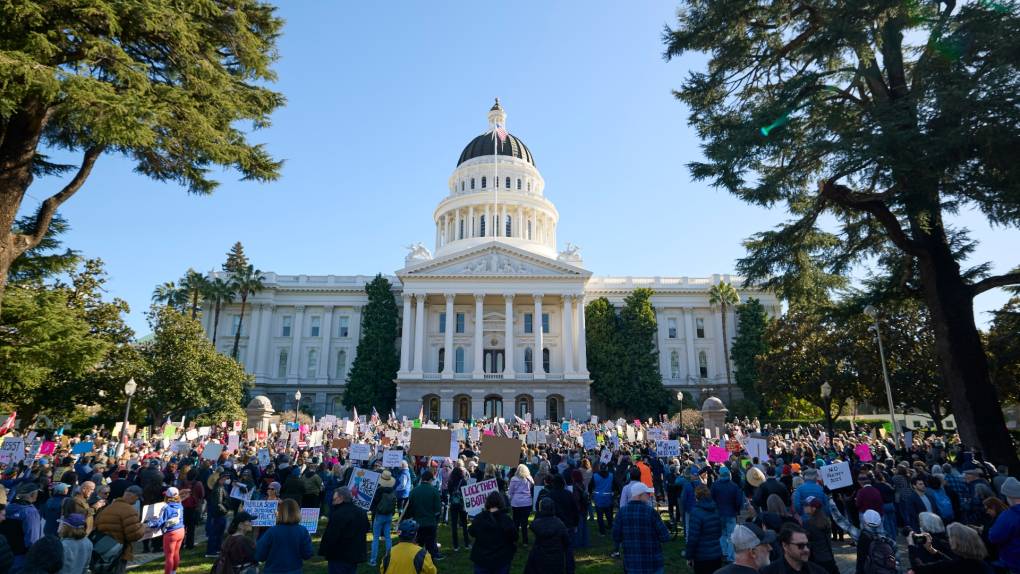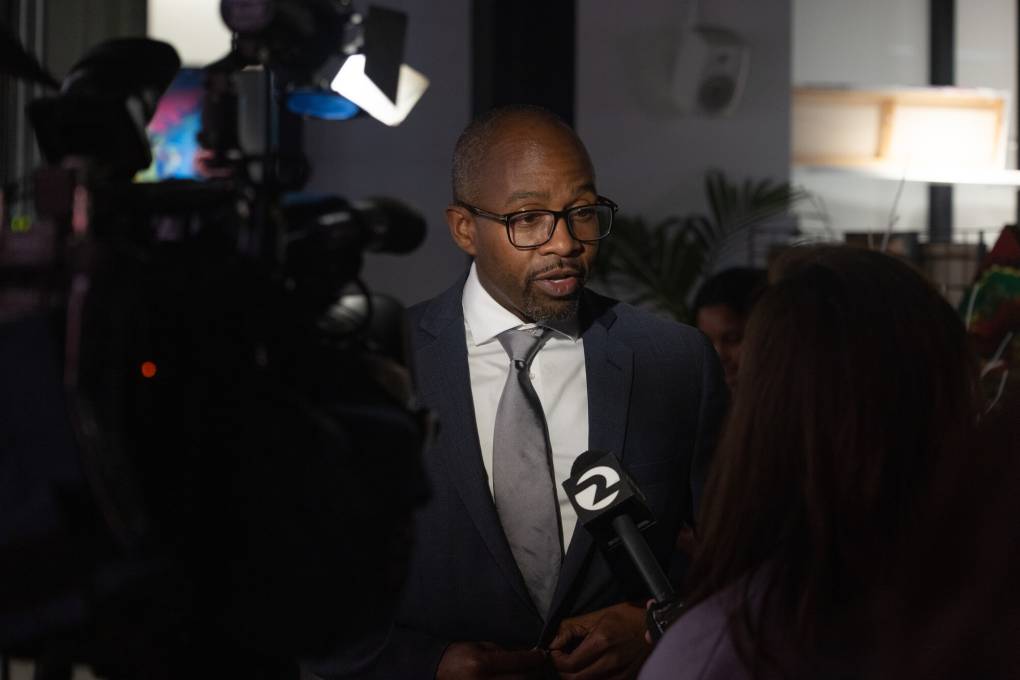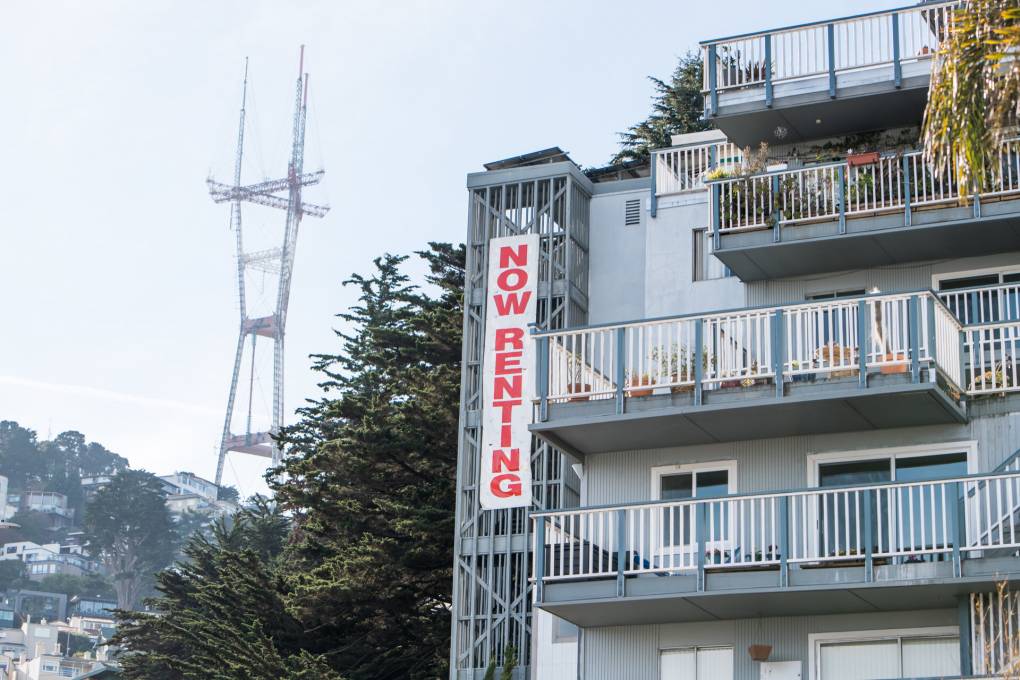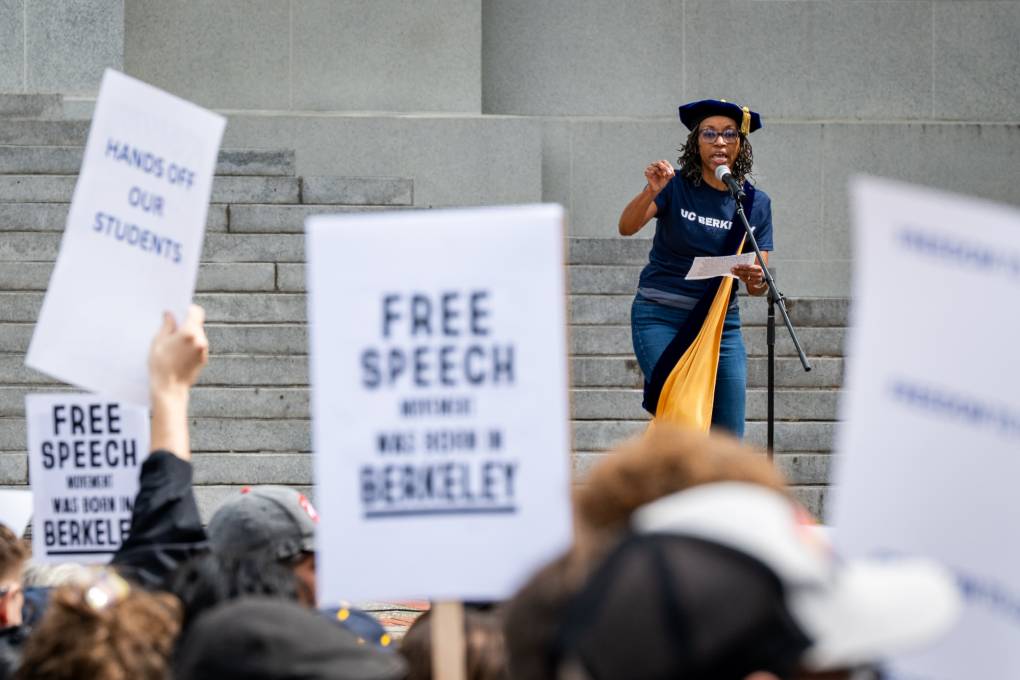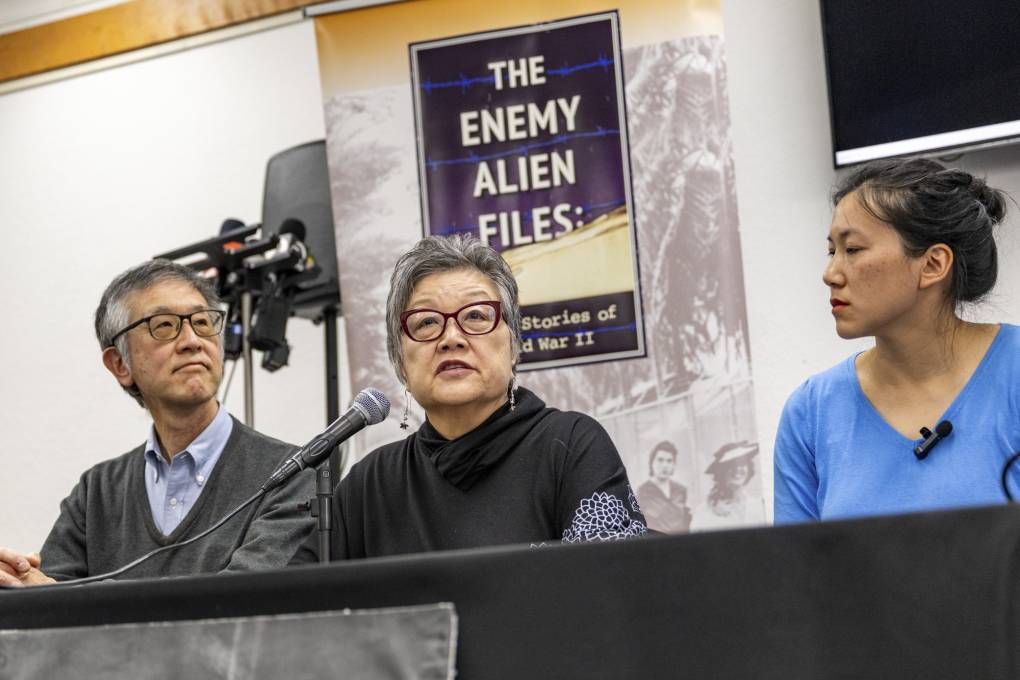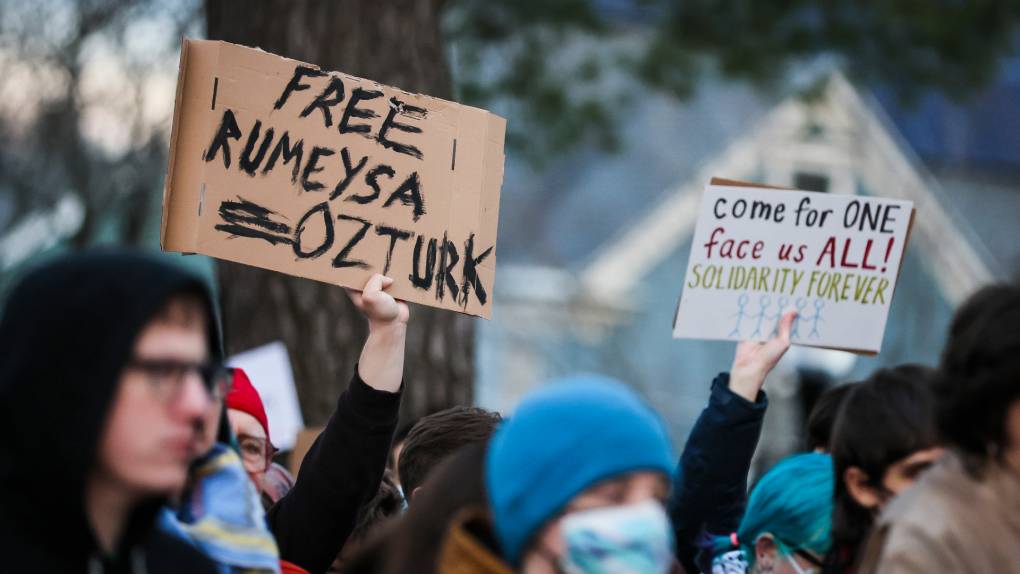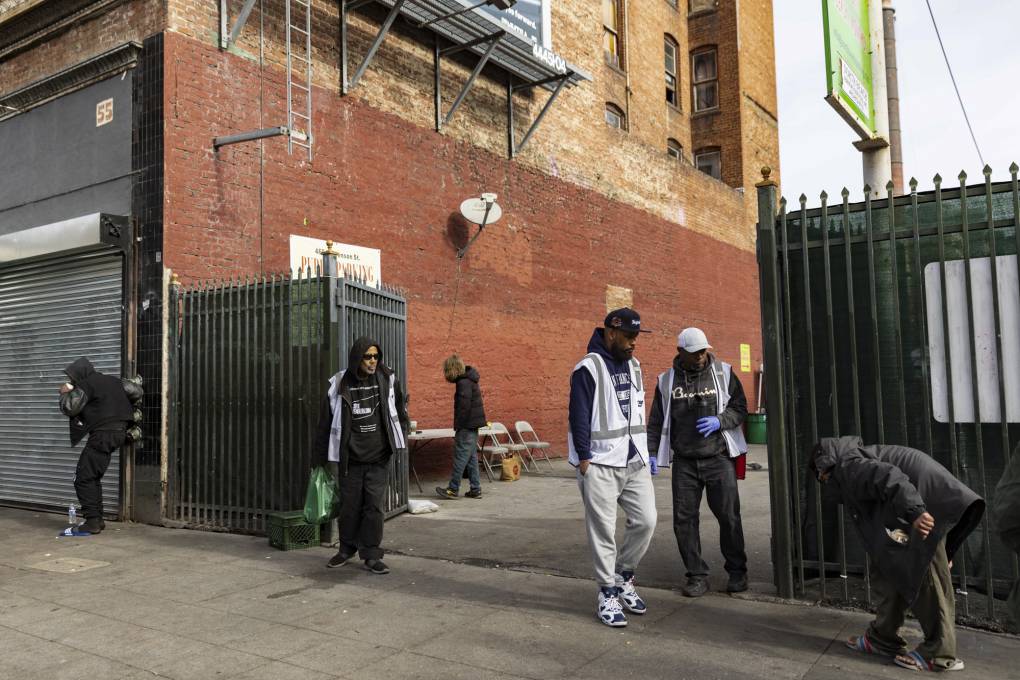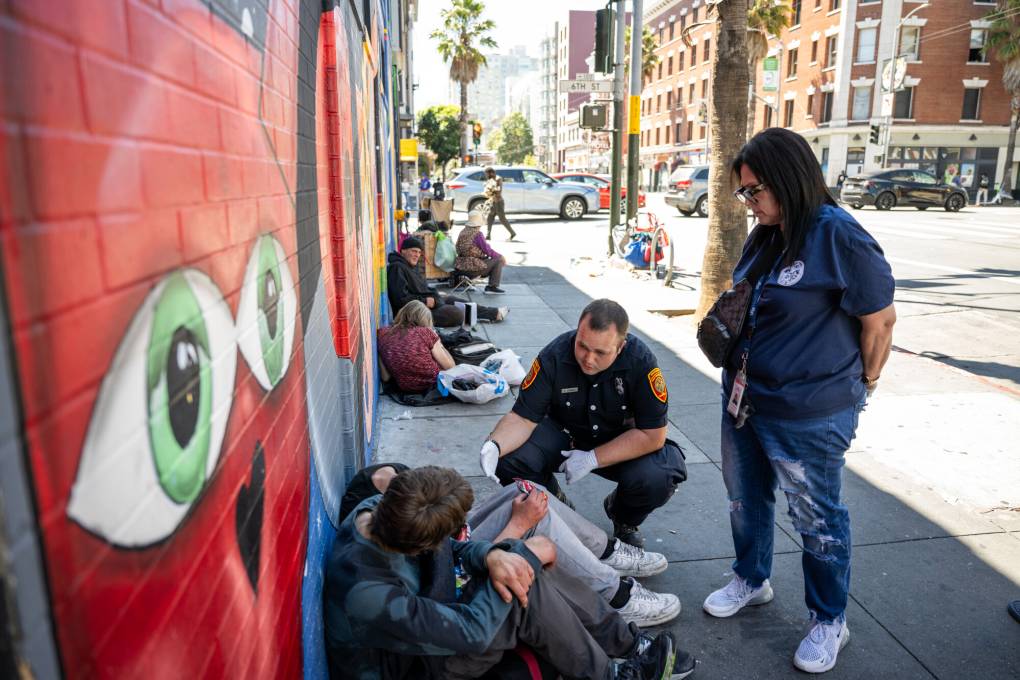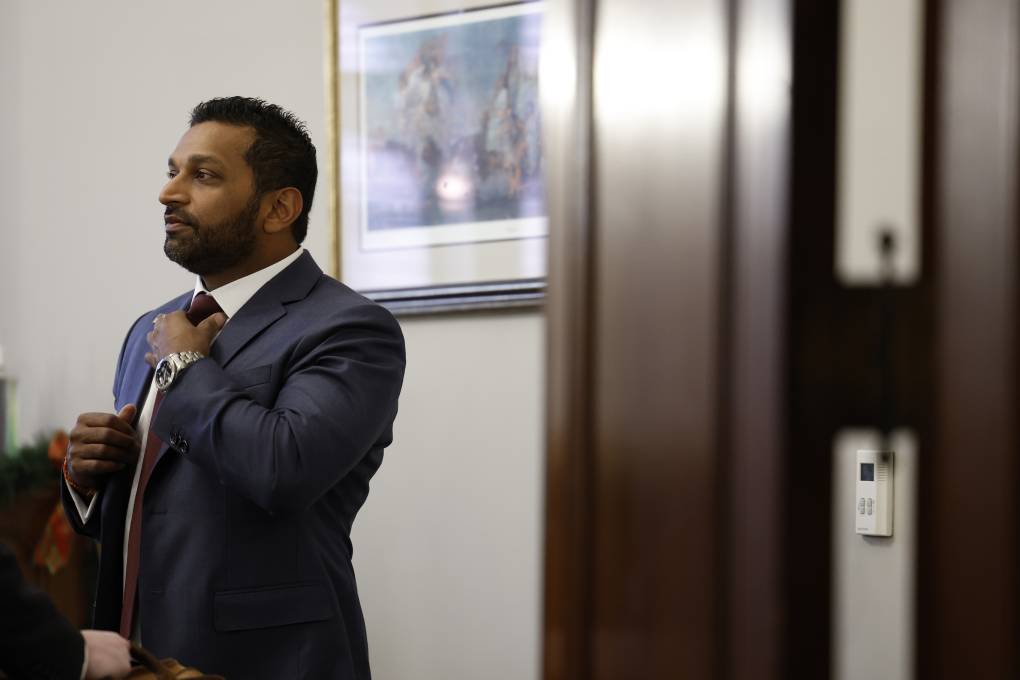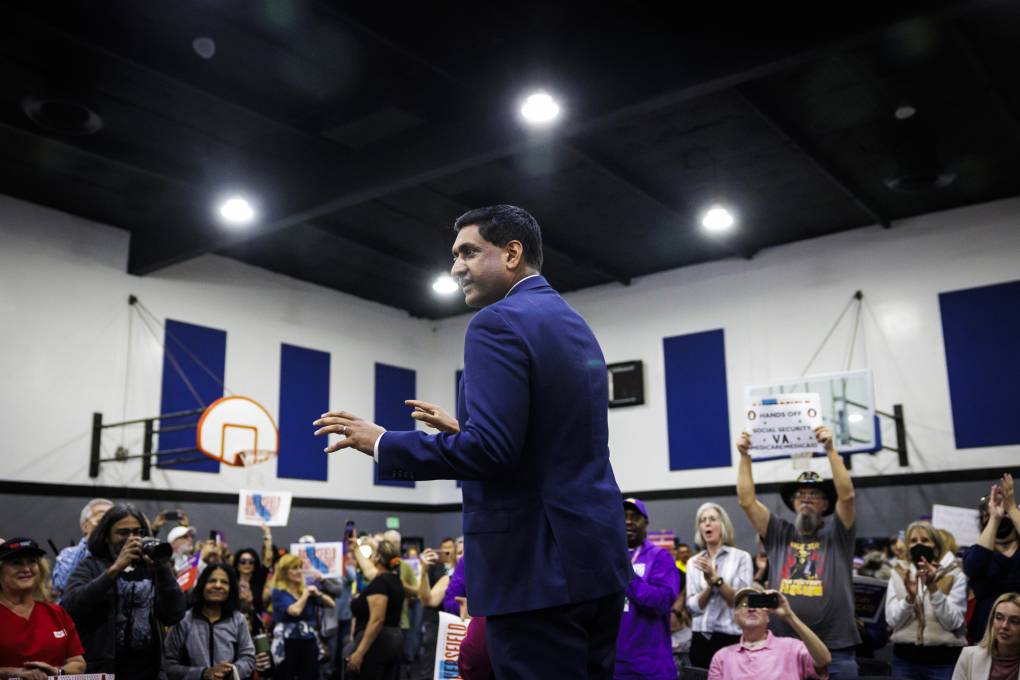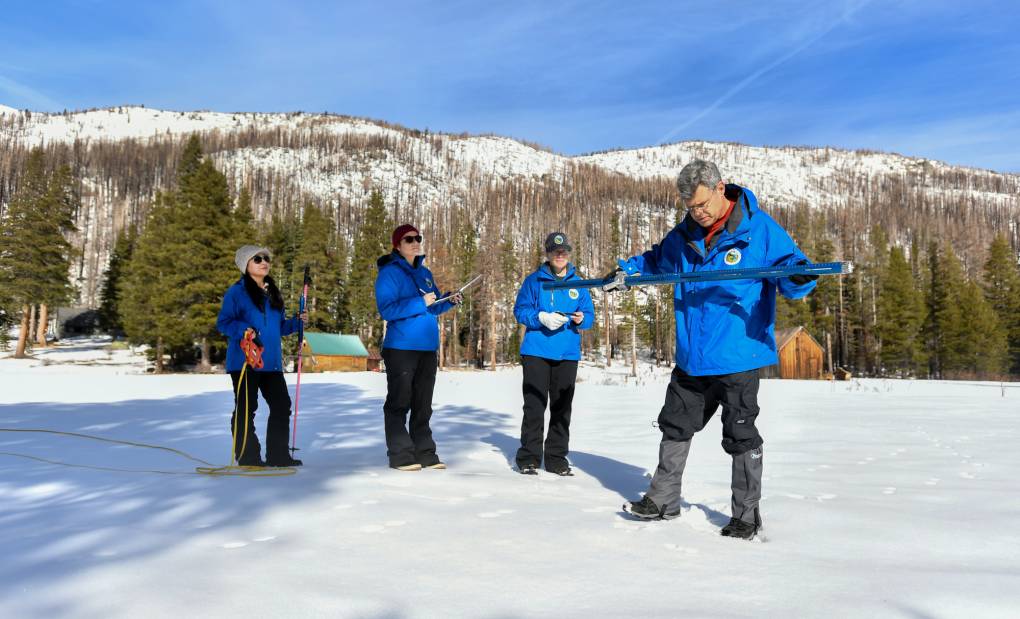Want to Visit Europe Soon? You May Need to Apply for New Travel Authorization 3:00 AM (last hour)

Updated at 1:30 p.m. April 3
United States citizens visiting the United Kingdom and Europe haven’t previously needed a visa waiver or travel authorization to enter these countries.
But that’s all changed starting this year, as the U.K. now requires an electronic travel authorization (ETA) for visitors from countries including the U.S., Canada, Australia and New Zealand. And if you have a UK trip planned any time soon, you might consider applying for this authorization soon, as the cost of an ETA application will rise by 60% on Wednesday. (Jump straight to how to apply for an ETA to visit the U.K.)
The European Union also plans to introduce its own visa waiver document called an ETIAS for visitors, including U.S. citizens. The ETA and the ETIAS processes are separate, as the U.K. officially left the European Union in 2020.
But if you were planning to visit Europe this year, you’ll be glad to know there’s one less thing to arrange, at least: While the EU had originally planned to implement ETIAS in mid-2025, the system has now been delayed until late 2026.
The good news is that the online process for obtaining permission to travel to these areas should be fairly simple — and speedy. So, if you’re hoping to visit Europe this year or in 2026, keep reading for everything you need to know about obtaining the right travel authorization before your visit.
- Jump straight to: What permissions will U.S. citizens need to visit Europe?
New travel rules for U.S. citizens visiting the UK in 2025
What will change in 2025 about travel to the U.K.?
If you’re a U.S. citizen visiting the U.K., you’ll now need to apply online for an Electronic Travel Authorization (ETA) for any travel to (and through) that country.
This new requirement, which came into effect on Jan. 8 this year, includes any children who are traveling and also applies to travelers who are just transiting through the U.K.
After applying, you’ll receive an email confirmation. This authorization will be digitally linked to the passport you applied with and will last for two years — during which time “you can travel to the U.K. as many times as you want,” according to the U.K. government website.
Dual citizens who have British or Irish citizenship do not need to apply for an ETA and should enter the UK using their British or Irish passport as proof of their exemption.
As of April 2, European visitors to the UK also need to apply for an ETA.

How do I apply for an ETA?
The U.K. Home Office recommends that you apply for your ETA before booking your travel to the U.K. If you already have a trip planned, you might consider applying for your ETA early anyway: the cost of an ETA application will go up by 60% on Wednesday.
U.S. citizens can apply for an ETA via:
The U.K. government strongly recommends applying via the app and has a detailed guide to applying for an ETA this way. However, if you’re applying for someone else who is not with you in person during the application — for example, one of your travel party — they advise applying online rather than using the app.
To apply, you’ll need to upload a photo of your passport and, for travelers age 10 and over, your face. You’ll then be asked several questions and pay the cost of the application, which is currently £10 (around $12.50) and will rise to £16 (around $21) on Wednesday.
Beware of any third-party website seeking to charge you more for processing your ETA application.
How long will getting an ETA take?
The U.K. government says that the ETA app “enables most applicants to receive a decision in hours” and that applicants will “usually get a decision within 3 working days, but you may get a quicker decision.”
However, the Home Office warns that it may “occasionally” take longer than three working days. So make sure you apply for your ETA well ahead of your departure date.
What if my ETA application is unsuccessful?
The U.K. Home Office says that if your ETA application is “rejected,” you’ll be informed of the reason and can apply again.
But if your ETA application is “refused,” you won’t be able to apply again, and you can’t appeal the decision. Instead, you’ll have to apply for a visa to visit the U.K.
New travel rules for U.S. citizens visiting Europe in 2026
What do I need to know about visiting Europe as a U.S. citizen in the next few years?
In 2024, European Union officials announced that U.S. citizens visiting 30 European countries would soon need to apply online for travel authorization through the European Travel Information and Authorization System (ETIAS).
ETIAS was originally scheduled to come into effect sometime in mid-2025. But the latest headline for would-be travelers to know: In March, the EU announced that ETIAS had been postponed until “the last quarter of 2026.”
There is no firm 2026 date for ETIAS travel authorizations coming into effect, and applications aren’t open. The EU says that officials will announce a specific opening date “several months prior” to the system’s launch, and that “no action is required from travelers at this point.”
When ETIAS does launch, this new requirement will include any children who are traveling and will also apply to travelers who are transiting through these countries. You’ll apply for ETIAS online, after which you’ll receive an email confirming your ETIAS travel authorization has been successful. This authorization will then be digitally linked to the passport you applied with and will last for three years or until your passport expires — whichever comes first.
Remember, the ETA and the ETIAS processes are separate, as the U.K. officially left the European Union in 2020, so even if you have a valid ETA to visit the UK, you’ll still need an ETIAS to enter Europe when the system is implemented.

Which European countries will U.S. citizens need ETIAS travel authorization to visit in 2026?
The full list of countries that U.S. citizens will need ETIAS travel authorization to visit in late 2026: France, Italy, Spain, Germany, Portugal, Iceland, Croatia, Austria, Belgium, Bulgaria, Cyprus, Czech Republic, Denmark, Estonia, Finland, Greece, Hungary, Latvia, Liechtenstein, Lithuania, Luxembourg, Malta, Netherlands, Norway, Poland, Romania, Slovakia, Slovenia, Sweden and Switzerland.
U.S. citizens who also have European Union (EU) nationality will not need to apply for ETIAS travel authorization. See who else will be exempt from ETIAS travel authorization.
How will I apply for ETIAS travel authorization when it comes into effect?
When applications open in 2026, you’ll apply online on the EU’s website. Applications will cost €7 (around $7–$8), but those costs are waived for minors. Read more about the types of information you’ll be asked to provide in your application.
One important thing if you’re planning to visit Europe in late 2026: To receive ETIAS travel authorization, your U.S. passport will need to be valid for more than three months after you’d be leaving Europe. Also, your passport can’t be older than 10 years. So, if you were looking for a reason to renew your U.S. passport, 2025 or 2026 might be a good time.
When applications open, beware of any third-party website seeking to charge you more for processing your ETIAS travel authorization application.
How long will getting ETIAS travel authorization take?
The EU says that most ETIAS travel authorization applications “will be processed within minutes and at the latest within 96 hours” — but warns that “some applicants may be asked to provide additional information or documentation or to participate in an interview with national authorities, which may take up to additional 30 days.”
For this reason, “we strongly advise you to obtain the ETIAS travel authorization before you buy your tickets and book your hotels,” officials say. So, if you’re hoping to visit Europe in 2025, it’s worth keeping an eye on the EU’s official ETIAS website for updates.
What if my ETIAS travel authorization application is unsuccessful?
The EU lists several reasons your ETIAS travel authorization could be denied, including if you’re “considered to pose a security, illegal immigration or high epidemic risk.”
If you’re denied, you’ll be told the reason by email, which will also provide information about your options to appeal the decision.
A Generation of Black Men Is Being Lost to Overdoses in San Francisco 2:00 AM (2 hours ago)

In San Francisco, Black men born between 1951 and 1970 accounted for 12% of overdose deaths between January 2020 and October 2024, despite representing less than 1% of the city’s population. The disparity in San Francisco is greater than any other major city.
Today, we hear from Richard Beal, director of recovery services at the Tenderloin Housing Clinic, about his personal story of addiction and recovery, and later talk with The San Francisco Standard’s David Sjostedt about what’s behind this trend of Black overdose deaths in the city.
Links:
Some members of the KQED podcast team are represented by The Screen Actors Guild, American Federation of Television and Radio Artists. San Francisco Northern California Local.
Mayoral Candidate Loren Taylor on Why He’s the Best Choice to Lead Oakland 3 Apr 3:24 PM (12 hours ago)
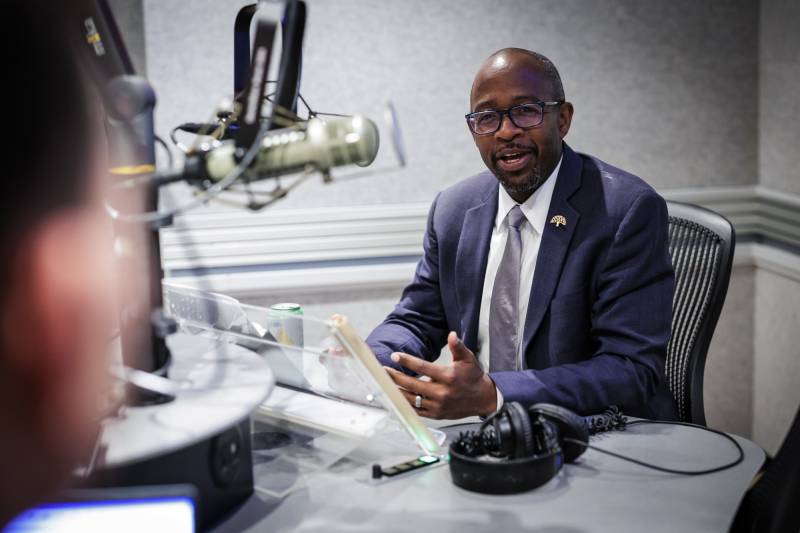
Oakland voters will elect a new mayor on April 15th to finish out recalled mayor Sheng Thao’s term.
One of the leading candidates is former city councilmember Loren Taylor. Taylor narrowly lost to Thao three years ago and faces former Congresswoman Barbara Lee in the special election. Scott and Guy are joined in studio by Taylor to hear why he thinks he has what it takes to lead Oakland at a time when the city is facing some tough challenges, including serious budget problems and concerns over public safety.
Accused FCI Dublin Officer May Take the Stand in East Bay Prison Sex Abuse Trial 3 Apr 2:59 PM (13 hours ago)
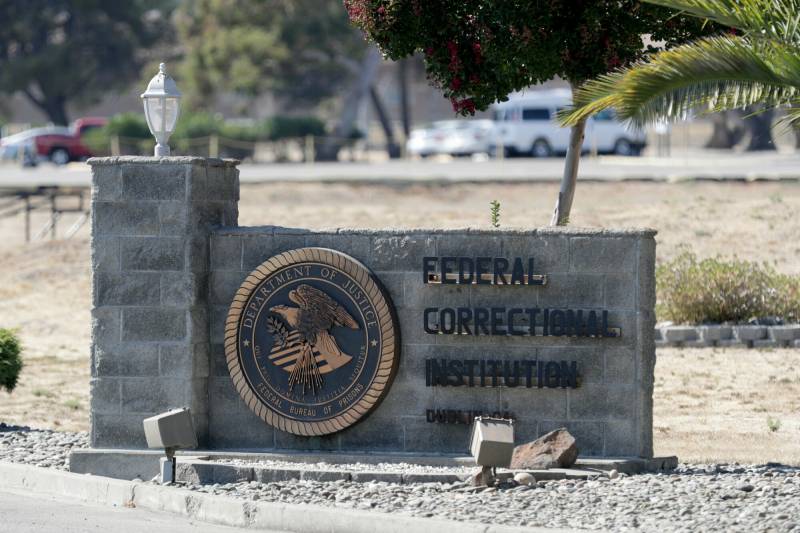
In an unexpected move by the defense, the former FCI Dublin officer on trial for sexually abusing five women at the shuttered East Bay prison may take the stand next week.
Attorneys for Darrell Wayne Smith, the last of eight officials at the former women’s prison being tried for sexual misconduct, told the judge on Thursday that Smith might testify to the allegations levied against him by five women formerly incarcerated at FCI Dublin. He was initially not expected to testify.
Smith is accused of abusing the women during his time as a correctional counselor and later as an officer at FCI Dublin. They allege that between 2017 and 2021, he stuck his fingers into their buttocks and vaginas, and forced them to show their breasts. One incarcerated woman said she was ordered to have sex with him in a supply closet.
The case against the former officer was part of a sprawling federal probe into the prison that revealed a culture of abuse, retaliation and cover-ups and has already led to the convictions of seven former officials, including the prison’s warden.
The defense was expected to wrap up the testimony with its final witness — former Special Investigative Services technician Ed Canales — on Thursday, following a weeklong hiatus due to his schedule. During his testimony, Canales described a different culture of retaliation to the jury: with Smith as the victim.
Canales, who has also been the president of the union representing most prison workers at Dublin for eight years, told the jury that he believed Smith was mistreated by upper management after reporting another employee who allegedly shared personal information about guards, like their social security numbers and medical reports, with her daughter.

“It was pure retaliation,” he said. “I’ve never seen an attack on an individual as I have Mr. Smith.”
Canales said that Smith recorded the employee discussing the information with the child, who was not a Federal Bureau of Prisons employee, and reported the conversation as a violation of privacy. In response, the woman opened her own case against Smith, alleging that she felt threatened by the recording.
During the investigation, Canales said Smith was required to work in what employees called the “mop closet” — a small room near the front doors of the prison where a guard would answer phones.
“We call it a chilling effect,” Canales said. The mop closet, where a “phone monitor” worked, was “in the front entrance where everyone could see. There was rat feces, mold, there was no heating, no air conditioning.
“In my opinion, it was retaliation. He was in there for weeks.”
Smith worked a total of 38 days as a phone monitor between Nov. 2017 and March 2018 before returning to his usual gig as a correctional officer in one of the prison’s housing units.
Canales said that the case was dropped after the union requested a review of the case against Smith by the U.S. Special Counsel. He said the human resources manager subsequently resigned.
The defense also pointed to the length of an investigation into an alleged inappropriate relationship Smith had with an incarcerated woman — which ultimately led to his demotion from correctional counselor to officer, a less prestigious and lower paid job — in 2017.
The case spanned six years, and Smith was ultimately given a six-day suspension in 2021.
“The six-year investigation, putting him in the mop closet, all these other frivolous stuff they did to him [and] the accidental displacement of his [Family and Medical Leave Act] paperwork” when Smith said he submitted requests for time off to go to the doctor all pointed to mistreatment,” Canales said.
The prosecution argued that Smith’s ability to work in the housing units, which were desirable shifts, was proof that he was trusted and not retaliated against.
Assistant U.S. Attorney Andrew Paulson presented logs of Smith’s shifts that showed he worked in housing units immediately before and after his stint in the “mop closet” and throughout the inappropriate relationship investigation.
He said Smith wasn’t forced to work less coveted roles, like the control and mail rooms or in the lobby, and was allowed normal privileges at the time.
If Smith opts not to take the stand, closing statements are expected as soon as Monday. If he does, though, the case could stretch much longer since both the defense and prosecution will need time to prepare. The defense has to decide by 1 p.m. on Friday.
Smith faces a possible life sentence if convicted.
SF’s Single-Family Home Neighborhoods Could See More Apartments, 65-Story Towers Near Downtown 3 Apr 1:15 PM (15 hours ago)
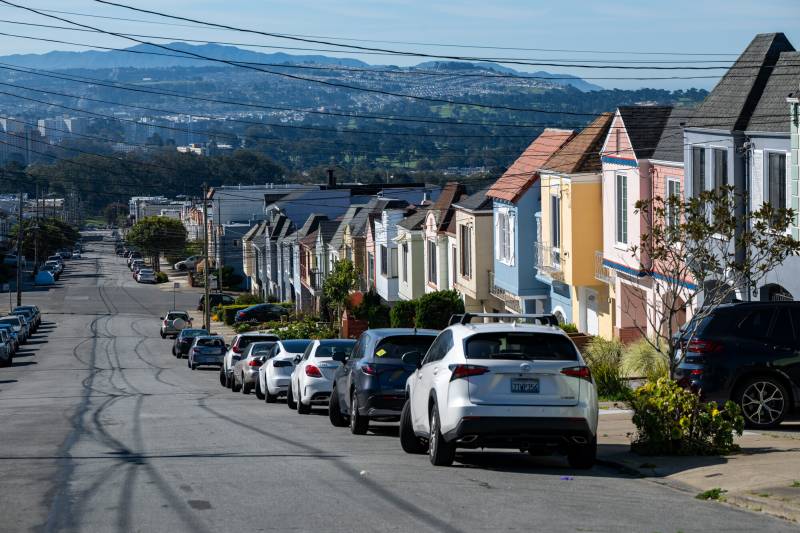
San Francisco officials want to make way for more housing. Where to put it? In quiet neighborhoods on the west side, historically known for single-family homes.
On Thursday, the city’s planning department will release details of a preliminary proposal to allow mid-rise apartment buildings, up to eight stories tall, along major streets in the Richmond and Sunset districts, along with some other neighborhoods in the northwestern part of the city. It’s also proposing to allow buildings up to 65 stories tall along certain major corridors.
The department will host an informational hearing about the plan, which will be livestreamed, on April 10.
For decades, city officials concentrated housing development on the southeast side of San Francisco, including the Mission District, South of Market and the Dogpatch, which allow for taller buildings. Meanwhile, large swaths of the Sunset, Richmond, Marina and Pacific Heights neighborhoods currently only allow for buildings up to four stories tall.
As San Francisco faces pressure from the state to plan for more than 82,000 new apartments by 2031, city officials are considering opening these northern and western neighborhoods to apartments six to eight stories tall along major streets, with some large boulevards, such as Geary Boulevard and Van Ness Avenue, going up to 65 stories tall near the city’s downtown.

Supervisor Stephen Sherrill, who represents several of the neighborhoods proposed to be rezoned, said the changes could help bring activity back to once-lively areas of the city.
“Post-pandemic, San Francisco has not rebounded in the way that other cities have, and we have an opportunity to really thoughtfully increase vibrancy in certain areas of the city,” Sherrill said. “By doing that with residents, we can be really effective in planning for the long-term future of the city that stays true with San Francisco.”
According to the city’s Principal Planner, Lisa Chen, the decision to add more apartments to the west side is thanks to a state mandate requiring the city to direct new development to well-resourced neighborhoods. People living in the northern and western neighborhoods have some of the highest incomes, home values, employment rates and better educational attainment rates than their eastern counterparts.
Chen said that if the city were to plan for housing in those areas, the people eventually living there would have access to better resources, such as public transit, parks, high-performing public schools, retail, and community facilities.
“The reality is that we have already rezoned many parts of the southern and eastern neighborhoods,” Chen said. “While we can continue to look for more opportunities to add housing in those areas, the state is requiring that the emphasis of this rezoning and the majority of units be placed in the well-resourced neighborhoods.”
This can be done sensitively, said San Francisco Board of Supervisors President Rafael Mandelman, by focusing development along major corridors in the western and northern parts of the city.
“I think people are going to continue to want to work here and live here,” he said. “I think we do need to try as best we can to accommodate that. And I think we can do it without destroying what we love about San Francisco. I think we can balance those things.”
However, the plan is receiving mixed reactions from residents, some who want more activity in their suburban-style neighborhoods and others who worry it could displace vulnerable renters and small businesses if the properties they occupy are redeveloped.

“I can see people being forced out of their homes, rent-controlled apartments and buildings being destroyed and luxury market-rate housing being built in its place,” said Don Misumi, a member of tenants’ rights group Richmond District Rising. “There’s not really much doubt in my mind unless things start to change and I see some concrete proposals that are going to provide tenant protections, that are going to provide protections for small businesses.”
San Francisco’s planning department has already approved roughly 58,100 new apartments, largely to be built in the eastern part of the city, that are awaiting construction. However, to reach the state’s goal of planning for more than 82,000 new units, the department is proposing that some of the remaining homes be built in the north and west sides.
The city’s preliminary map proposes to rezone commercial corridors, including 19th Avenue, Geary Boulevard and Clement Street. The bulk of the proposed rezoning would stretch from Russian Hill to Parkside and could allow for taller buildings — up to 65 stories on certain commercial corridors — creating opportunities for thousands of new homes. The plan also includes increasing height limits in other neighborhoods throughout the city, including along Market Street in the Castro.
After multiple informational hearings where residents can offer comments and voice concerns, the proposal will go to the planning commission, where it could be amended or changed. It will ultimately have to go before the Board of Supervisors before the end of January 2026, when the city faces a state-mandated deadline to approve a rezoning plan.
If it misses that deadline, it could lose state funding for affordable housing and public transportation, risk lawsuits, fines and be subject to the builder’s remedy, a mechanism that allows developers to circumvent local building rules if the city is out of compliance with state housing law.
“The process for our rezoning is a bit of a fait accompli — we already agreed to this,” said Jane Natoli, San Francisco Organizing Director for the pro-housing lobbying group, YIMBY Action. “All we’re trying to do is honor the commitments we told the state we were going to do, at the end of the day, to build the housing we need for San Franciscans.”
From sand dunes to suburban homes
San Francisco’s decision to rezone the western part of the city marks a break from the area’s historically low-density character. Western neighborhoods were some of the last parts of the city to be developed.
During the mid-to-late 1800s, the Inner Sunset and Richmond districts were home to a handful of dairies, ranches, a chicken farm — even a dynamite factory — while the Outer Sunset stretched out in a yawning sprawl of sand dunes.
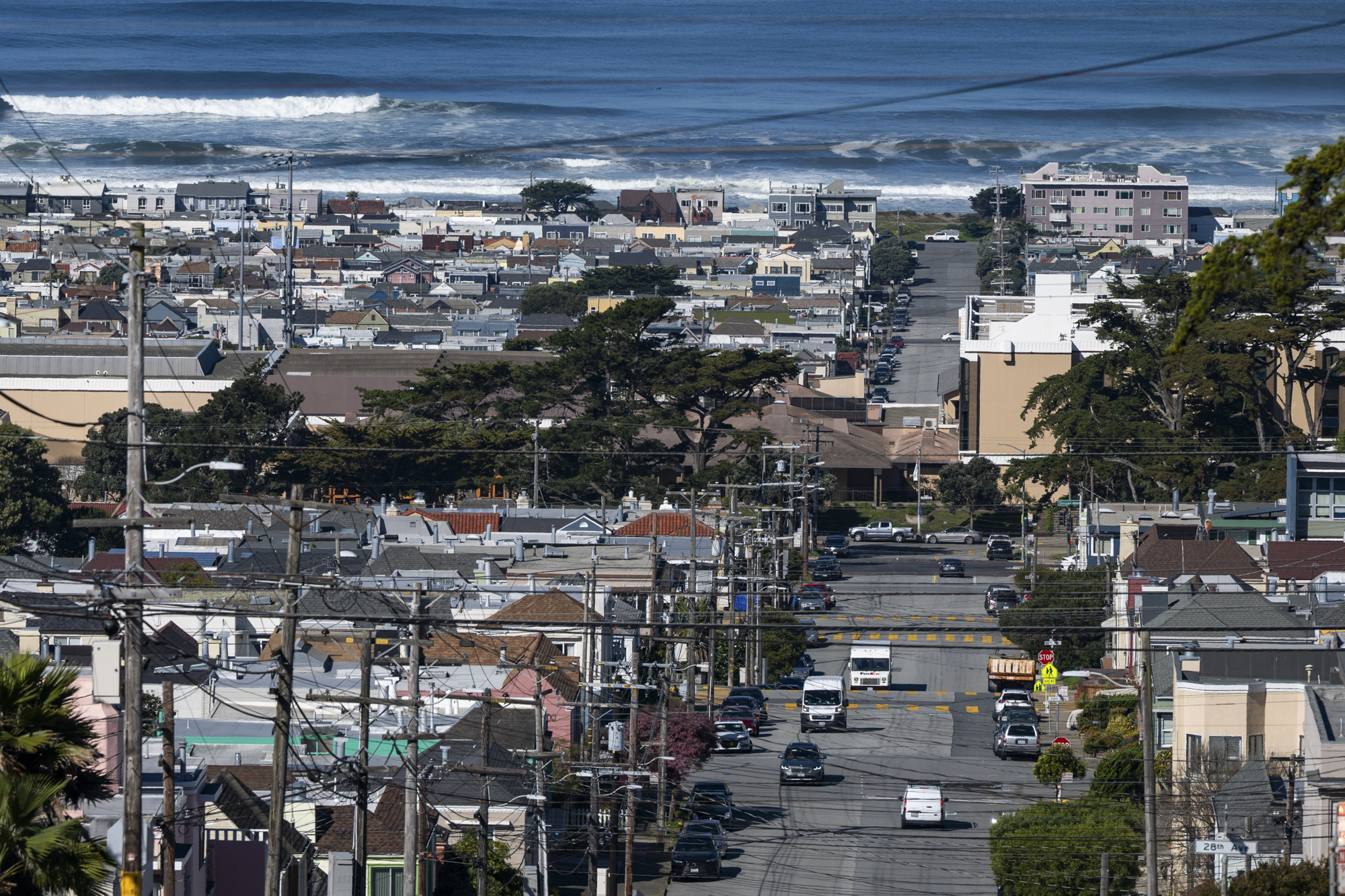
In the aftermath of the devastating 1906 earthquake, refugee camps sprang up on the city’s underdeveloped western side. Woody LaBounty’s great-grandparents even met at one of those camps in the Richmond area, he said. The lifelong Richmond resident and president of the preservationist organization San Francisco Heritage said tract houses soon began popping up atop sand dunes to replace the temporary camps.
After World War II, most of the Sunset and Richmond districts had been developed into suburban-style neighborhoods with single-family homes, LaBounty said.
“You have a yard for your family to play in, you have multiple bedrooms, you’ve got your own sort of little plot — your little estate,” he said, “even if it’s a 25-by-100-foot lot in the Sunset District.”
It’s for that same reason why many westside residents enjoy this part of town today. Paola Soto said she moved to the Outer Sunset five years ago so she and her husband could raise their daughter in a rented single-family home.
“We just loved the neighborhood and how family-oriented it is,” she said. “It doesn’t feel like part of the city, but you’re still in the city.”
But Soto said there aren’t many amenities or small businesses to patronize on her block. She welcomes the rezoning if it could bring more business activity to her neighborhood but said taller buildings could mean losing “this kind of neighborhood vibe” that she likes.
Picking and choosing
While residents like Soto are hoping the rezoning could bring new small businesses to the Sunset and Richmond, existing business owners are concerned they will be forced out. Yoland Porrata, an esthetician and board member of nonprofit Small Business Forward, owns a skincare studio in the Lower Haight.
Right now, she is trying to work with the city to establish new protections against displacement for small business owners, even if they do not own the building.
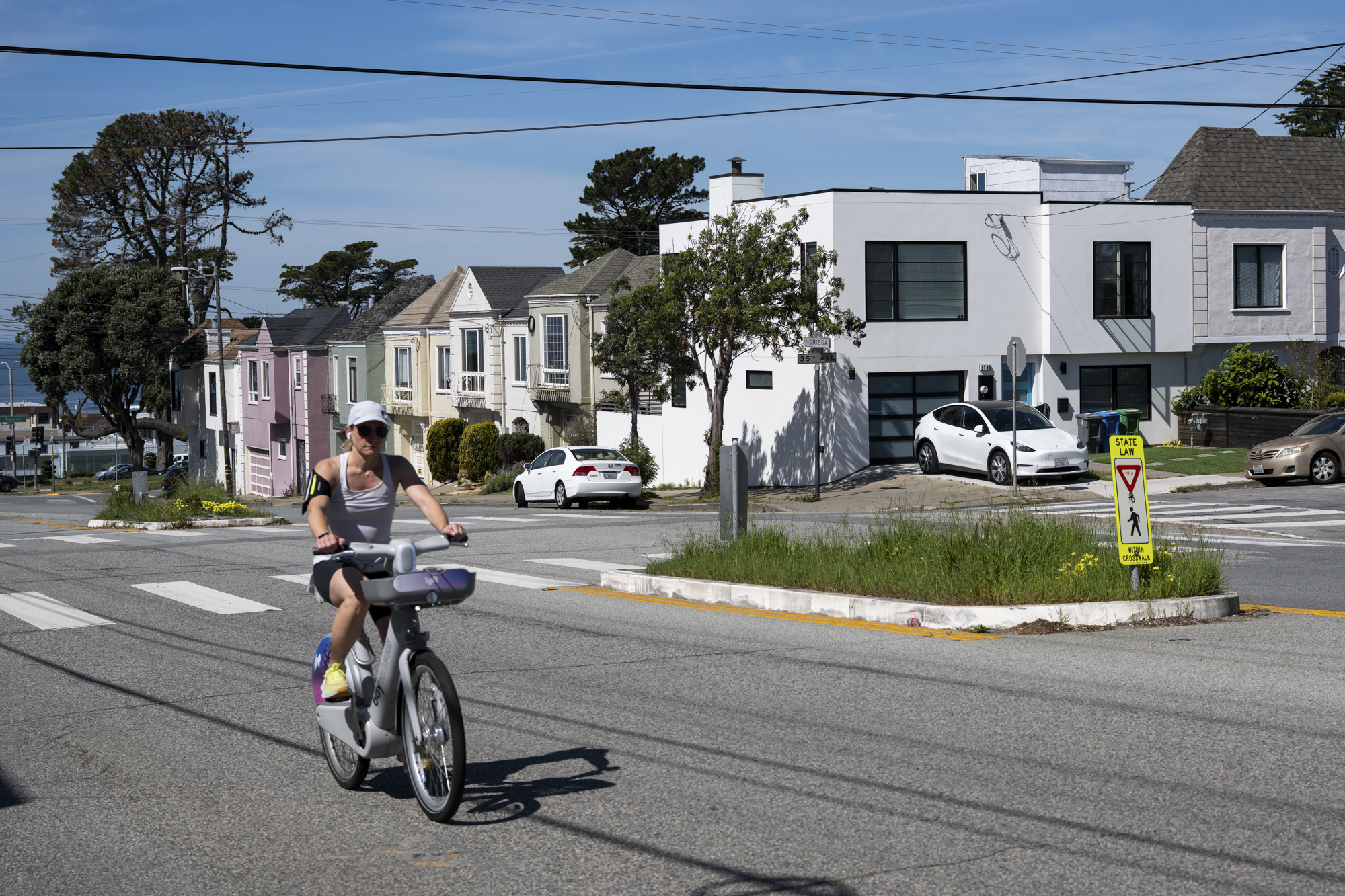
“Do we have a right to return?” she asked. “We already have super vulnerable commercial leases that are not nice and tidy in the way that some of the residential leases are.”
Along with small business owners, tenants’ rights groups are equally concerned about the city’s plan. San Francisco offers a bevy of tenant protections, but local groups worry the rezoning might encourage landlords to pressure renters to move out or evict them unlawfully.
Dyan Ruiz, a member of Race & Equity In All Planning Coalition, said her organization wants to make sure developers are following the city’s laws and that it can make sure tenants aren’t displaced.
“We want to increase the accountability and enforcement of existing laws and making sure that there aren’t gaps and loopholes that tenants are falling through,” she said.
LaBounty hopes the city can strike some kind of balance — allowing more housing while still retaining the neighborhoods’ quiet charm. Pointing out the coffee shop across the street from where he lives, he said he doesn’t want to see it go.
“You got a cafe, a dry cleaner and a bakery right in a row — everybody loves them, you know? Maybe don’t upzone those,” he said. “It feels to me like you could do some picking and choosing, and the neighborhood could totally help you with it too.”
Tercer cheque de estímulo: Cómo reclamar este dinero si nunca lo recibió en 2021 3 Apr 1:00 PM (15 hours ago)

Para algunos de nosotros, el 2021 se siente como si fuera ayer, en lugar de hace cuatro años. En el segundo año de la pandemia, millones de personas recibieron su vacuna contra el COVID-19 y el gobierno federal aprobó el Plan de Rescate Estadounidense, que incluía una tercera ronda de cheques de estímulo: mil 400 dólares para la mayoría de los contribuyentes en EE. UU., junto con mil 400 dólares adicionales para cada uno de sus dependientes.
El gobierno federal comenzó a distribuir estos cheques de estímulo en marzo de 2021, y para recibir estos fondos, un hogar tendría que haber presentado su declaración de impuestos en 2020 o 2019. Esto se debe a que el gobierno federal analizó las declaraciones de impuestos para determinar cuántas personas vivían en ese hogar y, por lo tanto, cuál debería ser el monto de su pago. Por ejemplo, si usted y su cónyuge presentaron una declaración conjunta e incluyeron a dos hijos como dependientes, su hogar habría recibido un cheque de estímulo de 5 mil 600 dólares (lo que equivale a mil 400 dólares multiplicado por cuatro) en 2021.
Si un hogar no presentó su declaración de impuestos de 2019 o 2020 en el momento en que el Servicio de Rentas Internas (o IRS por sus siglas en inglés) estaba emitiendo los cheques de estímulo, no recibió ese dinero. Sin embargo, el IRS creó el Crédito de recuperación de reembolso para que esas mismas personas puedan reclamar estos fondos, con el requisito siendo que presenten sus impuestos de 2021 si aún no lo habían hecho.
Sin embargo, la fecha límite para presentar los impuestos de 2021 y reclamar este dinero del Crédito de Recuperación de Descuento se acerca rápidamente: el 15 de abril. El IRS estima que, a partir del 11 de marzo, más de 116 mil californianos tienen reembolsos no reclamados correspondientes al año tributario 2021, lo que representa millones de dólares en fondos no reclamados.
“Hemos hablado con muchas personas que no han presentado la declaración y no sabían que esto seguía siendo una opción”, dijo Amy Spivey, profesora de la Facultad de Derecho en la Universidad de California en San Francisco. “Así que si no ha presentado la declaración de 2021 y aún no ha recibido los mil 400 dólares, presente la declaración antes del 15 de abril para conservar su derecho a recibir ese reembolso”.
Siga leyendo para saber qué debe hacer para presentar su declaración de impuestos de 2021 si aún no lo ha hecho y cómo podría ayudarle a obtener el Crédito de Recuperación de Reembolso. Tenga en cuenta que la situación fiscal de cada persona es diferente y que siempre es una buena idea buscar asesoramiento profesional si tiene dudas. Vea dónde encontrar servicios de preparación de impuestos gratuitos o de bajo costo cerca de usted (enlace sólo en inglés).
¿Cómo es posible que un crédito tributario de 2021 siga disponible en 2025?
La fecha límite original para presentar la declaración de impuestos de 2021 fue el 18 de abril de 2022. Sin embargo, todavía existe una prórroga para quienes aún no han cumplido con esta responsabilidad de cada contribuyente.
Esta última prórroga es el 15 de abril, 2025. Esto es posible porque las normas del IRS dan a los contribuyentes tres años para presentar sus impuestos a partir de la fecha de vencimiento original para reclamar cualquier reembolso o crédito de ese año.
Ese período de prórroga de tres años para presentar la declaración “expira el 15 de abril de 2025”, dijo Spivey. “Así que, siempre que se haya enviado por correo antes del 15 de abril de 2025 … habrá conservado su derecho a reclamar ese crédito”.
¿Quién califica para el Crédito de recuperación de reembolso en 2025?
Según el IRS, usted es elegible para el Crédito de recuperación de reembolso si:
- Usted era ciudadano estadounidense o extranjero residente en EE. UU. durante el año fiscal 2021
- Usted no fue reclamado como dependiente de otro contribuyente en 2021
- Tiene un número de Seguro Social (o SSN por sus siglas en inglés) válido o presenta la declaración de forma conjunta con un cónyuge que lo tiene, o declara a un dependiente que tiene un SSN válido o un número de identificación fiscal de adopción.
Incluso si no tuvo ingresos en 2021 o recibió prestaciones por desempleo durante la mayor parte de ese año, puede seguir teniendo derecho a este crédito, pero tendrá que presentar la declaración de impuestos de 2021.
Sin embargo, hay algunas cosas que le descalificarían para recibir el crédito, entre ellas:
- Residencia: Actualmente es un extranjero no residente sin un SSN (y presenta sus impuestos utilizando un Número de Identificación Personal del Contribuyente, o ITIN)
- Límites de ingresos: si es soltero y su ingreso bruto ajustado (o AGI por sus siglas en inglés) en 2021 fue superior a 80 mil dólares, no recibirá el crédito. El límite de AGI para las parejas casadas que presentan una declaración conjunta es de 160 mil dólares, y para aquellos que presentan una declaración como cabeza de familia, el limite es de 112 quinientos dólares.

¿Tendré que pagar una multa si presento mis impuestos de 2021 en 2025?
Eso depende. El IRS solo le cobrará una multa por presentar tarde si sus declaraciones de 2021 muestran que les debe dinero.
Pero si le deben un reembolso, dijo Spivey de UC Law, “no se le cobra una multa por la presentación tardía de las declaraciones de impuestos”.
“Por ejemplo, si no debe ningún impuesto, simplemente está reclamando su cheque de estímulo y va a recibir un reembolso de mil 400 dólares, entonces no habría ninguna multa asociada a eso”, añadió.
Sin embargo, supongamos que sí debe dinero al IRS en sus impuestos. Por ejemplo, supongamos que usted trabajó en 2021 y pidió a su empleador que no dedujera los impuestos federales de su nómina mensual. Debido a esta decisión, se espera que usted pague un porcentaje de esos ingresos de 2021 al presentar sus impuestos de ese año, y si usted está presentando esos impuestos ahora, todavía le debe al IRS ese porcentaje en 2025.
“[Una multa por presentar tarde] sería un porcentaje de cuánto se debía en la parte inferior de su reembolso”, dijo Spivey. Pero ella dijo que “todavía podría valer la pena” presentar su declaración de impuestos de 2021 antes del 15 de abril, incluso si debe dinero “porque todavía obtendrá crédito por esos mil 400 dólares … para reducir cuánto debe en esa declaración de impuestos.”
Otra cosa a tener en cuenta: el IRS advierte que los contribuyentes que soliciten su devolución de impuestos de 2021 podrían no recibirla si aún no han presentado sus declaraciones de impuestos de 2022 y 2023. Pero si hacer trámites con el IRS parece difícil o intimidante, Spivey recuerda a la gente que no está sola en este proceso, y que si el papeleo le resulta complicado o le han denegado el Crédito de recuperación de reembolso incluso después de presentar sus impuestos de 2021, puede ponerse en contacto con un centro de asesoramiento fiscal gratuito.
“Si hay algún problema”, dijo, “una clínica de contribuyentes de bajos ingresos podría ayudarle a obtener esos fondos”.
Este artículo fue traducido por la periodista María Peña y esa traducción fue editada por el periodista Carlos Cabrera-Lomelí.
Rural California Relies on the Trump Administration for Jobs. Now They’re Bracing for Cuts 3 Apr 11:41 AM (16 hours ago)
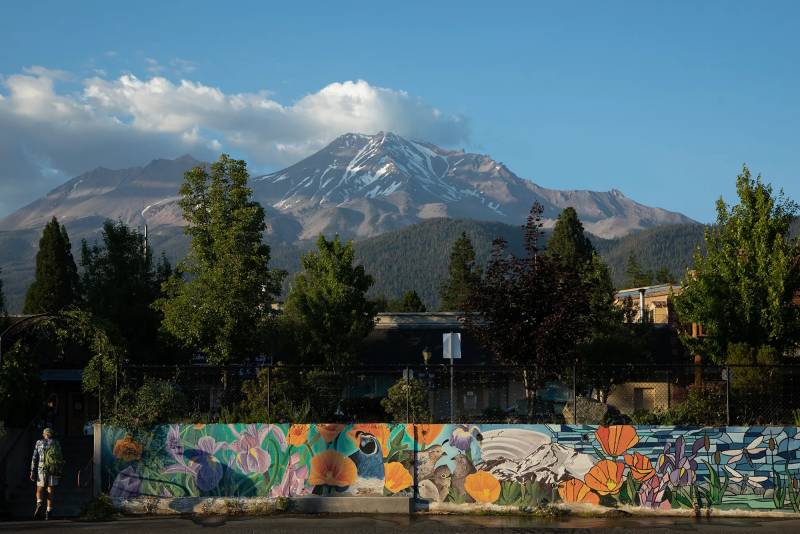
This story was originally published by CalMatters. Sign up for their newsletters.
Far from the halls of power in Washington, the forested hamlet of Mount Shasta has long tied its economic fate to a functioning federal government.
Yet even in a county where President Donald Trump’s cuts could hit the region’s economy hard, some are welcoming them. Nearly 60% of voters there supported the president.
The past two months have been a whirlwind for rural towns across California like Mount Shasta, population 3,200, where federal lands abound and outdoor recreation drives the local economy. Probationary federal workers were abruptly fired, then reinstated under court order, as further reductions in force loom. Local organizations scrambled when the federal government froze some grant funds for wildfire preparation, trail maintenance and other work, then some saw the money trickle in again but with no guarantee it’ll continue.
The Sierra Club and other nonprofits are suing the Trump administration to reverse Forest Service firings.
Business owners and officials in forest towns, overwhelmingly dependent on recreation and tourism, are anxious about whether there will be enough federal workers to keep trails open, campgrounds clean and visitors coming.
Some forest towns, like Mammoth Lakes in the eastern Sierra Nevada, are trying to backfill some anticipated federal losses with their own dollars. But that would be a tough undertaking for many others.
“We are a poor, rural county,” said Siskiyou County Supervisor Ed Valenzuela, who represents Mount Shasta. “Federal funding, it’s not like that money is going to be replicated anywhere else.”
Rural California relies on federal funding
He has cause for concern. The namesake mountain towers above the small town, drawing in thousands of visitors to climb and ski. In surrounding Siskiyou County, over 60% of the land is owned and managed by the U.S. Forest Service. As much as 6% of the county workforce is employed by the federal government, according to Census data.
It’s second only to neighboring Lassen County. Both are among the most Trump-supporting counties in the state. In Siskiyou County, nearly 60% voted for the president in November.
Estimates from state labor agencies show other small, forested counties in Northern California and the Sierra Nevada also have high shares of federal employment. By contrast, though federal agencies employ far more people at offices in urban counties, they’re only responsible for 1–2% of the workforces there.
“Things are magnified in a small community,” said Tonya Dowse, executive director of the Siskiyou Economic Development Council, a nonprofit that receives several federal grants to help small businesses, farmers and towns including Mount Shasta. “Small reductions are felt to a greater extent.”
Federal land makes up the majority of many rural counties, which are already dealing with the likely loss of millions of federal dollars that prop up their school systems and public works departments. Rural hospitals are generally more reliant on the massive low-income health program Medicaid. Their populations are older and poorer, making the Social Security Administration and federally funded safety net programs critical.

Federal officials have not been forthcoming about exactly how many workers have been fired and reinstated in recent weeks, and locals say they’re unsure themselves. The Forest Service in February cut at least 3,400 probationary employees nationwide. The Washington Post reported last week that the administration plans new cuts of between 8% to 50% across federal agencies.
A spokesperson for the Forest Service, who would not provide a name, would say only that probationary employees who were fired in February were placed in March under a “phased plan for return-to-duty.” Thomas Stokesberry, a spokesperson for the Shasta-Trinity National Forest, directed a separate request for a breakdown of staffing cuts to the regional Forest Service press office, which did not respond.
In Mount Shasta, everyone seems to know someone who is affected. John Redmond, a bar owner who is also the mayor, said his regulars who work at the local Forest Service district office haven’t been spending as much since they were fired or heard of cuts. Timothy Keating, a longtime mountain guide, said he depends on a fully staffed Forest Service to approve his operating permits.
Down the street, an outdoor goods store manager named Michelle is also worried about economic fallout. She wouldn’t give her last name out of fear of drawing attention to her husband, a federal employee who she said was anxious about losing his job in the next round of reductions in force.
“A lot of federal workers make up our middle class,” she said. “This can really hurt our local tax base and spending levels.”
Trump’s cuts will hit a divided county
Yet others welcome cuts, even if they’ll hit the local economy.
While the town of Mount Shasta is liberal, its streets of Subarus, crystal shops and bed-and-breakfasts welcoming out-of-town mountaineers give way quickly to vast stretches of the county where ranchers and loggers have long clashed with environmentalists and chafed at state and federal regulations.
Longtime resentment over Forest Service management and the decline of the timber industry have split the county.
Many in Mount Shasta cheered when then-President Joe Biden, in his last days in office in January, designated a new national monument on Forest Service lands outside the town, increasing federal protections there. Other Siskiyou County residents, including Supervisor W. Jess Harris, celebrated when Trump indicated last month he may revoke the designation.
Harris acknowledges the county relies on the federal government for both services and jobs — but he said it doesn’t have to be that way. He hopes federal cuts will reduce grants to environmental nonprofits that he says have hampered private industry.
Regulations like those that restrict logging to protect the spotted owl, listed as a threatened species, have “effectively damaged all of our natural resource industries,” he said. “Our area’s just a prime example of what happens when you kill the industry and become reliant on the government jobs.”
Dan Dorsey, chair of the local Republican Party, said he welcomes reducing federal spending and doesn’t believe the cuts will be drastic.
“I think the idea is to sit back and wait and see where the cuts are going to be made, and do we actually need those programs anymore?” he said. “We have too many -ologists all over the place.”
Other local politicians are caught in the middle.
Assemblywoman Heather Hadwick, a Republican from Alturas, represents 11 rural counties across Northern California, including Siskiyou. She said she’s worried about the economic ripple effects of job losses in small towns, and about funding delays in local wildfire mitigation projects, when now is the season to make those preparations.
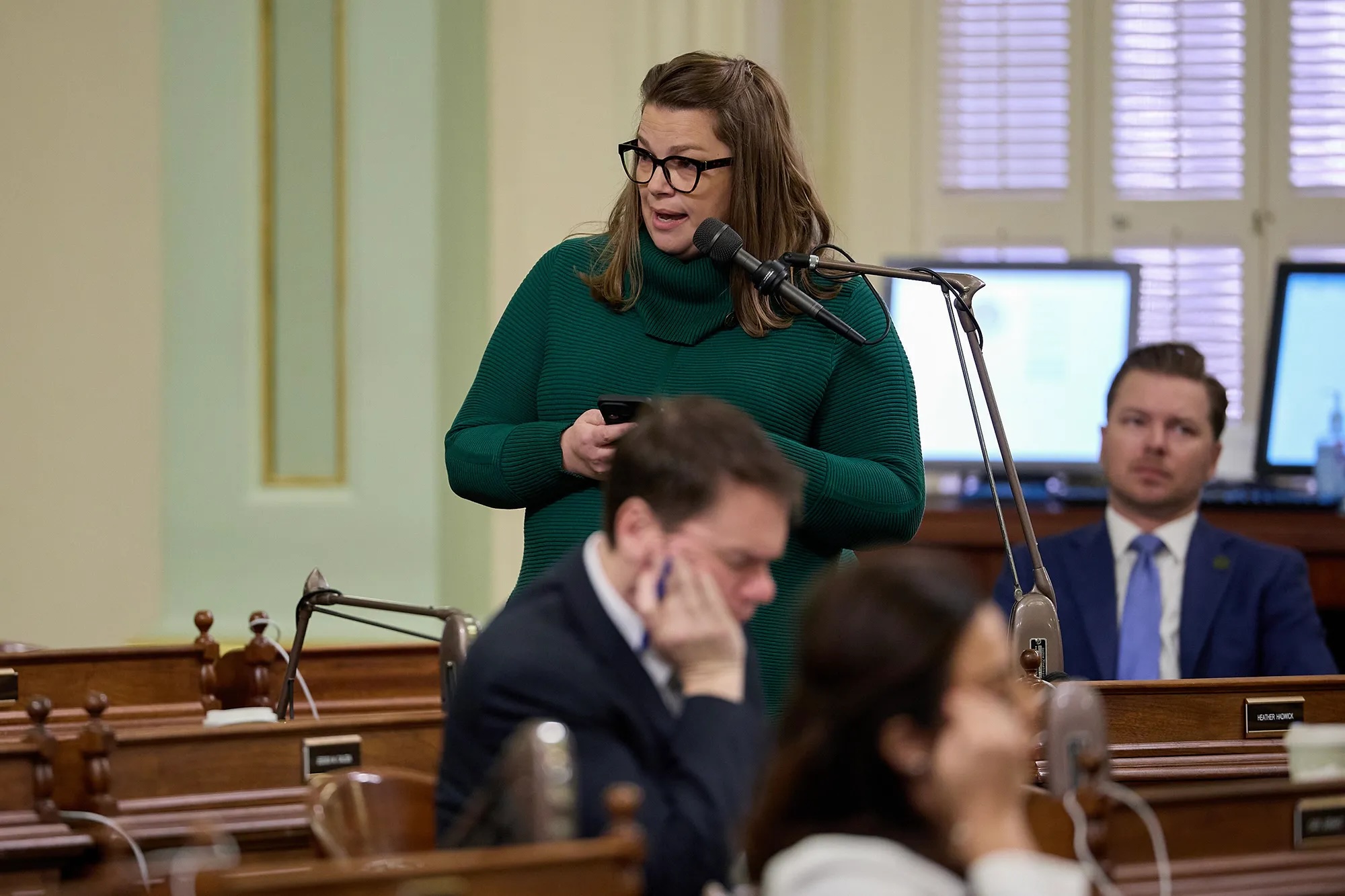
It’s personal, too. Hadwick’s husband manages a local office of the U.S. Department of Agriculture and she’s seen firsthand how “his people are stressed.” But her district, which she said already holds deep distrust of the government, voted for cuts and spending reviews.
“I think it’s going to be uncomfortable for a while and it’s going to hurt, I know some of those programs that I care about deeply are going to be affected,” she said. “My district is very conservative, and I am very conservative … I’m going to trust in my president and trust what he’s doing is best.”
With both federal uncertainty and local polarization, some are hesitant to speak publicly against the cuts. The leader of one nonprofit in Siskiyou County detailed to CalMatters how the group had a Forest Service grant temporarily frozen, delaying the hiring of contractors. But after meeting with the rest of the organization the leader asked to withdraw their comments, stressing the need to remain “apolitical.”
Other forest towns are preparing
In bluer parts of California, some forest towns are trying to mount a small resistance. Council members in Truckee, near Lake Tahoe, last month passed a resolution denouncing possible federal cuts, citing the impact they would have on the region’s ability to prevent wildfires and accommodate tourists visiting the Tahoe National Forest.
Similar resolutions have passed in a handful of local fire protection districts and in the eastern Sierra Nevada town of Mammoth Lakes.
The town, population 7,200, balloons to nearly quadruple its size on the weekends, from skiers in winter to backpackers, climbers and tourists in spring, summer and fall. It needs the visitors: Nearly three-quarters of Mammoth Lakes’ revenue comes from a bed tax on hotels and Airbnbs, Mayor Chris Bubser said.
Bubser said the city has already hired a new staff member to pick up trash and help maintain local campgrounds in case there aren’t enough Forest Service personnel to do so this summer.
And in March, the Mammoth Lakes Town Council agreed to provide $700,000 in bridge funding for a forest-thinning and wildfire resilience project run by a local nonprofit that spans 58,000 acres of mostly national forest land surrounding the town. The project relies on about $17 million in different federal grants, some of which is frozen, she said. But Bubser said she didn’t want the project to get delayed, risking having contractors leave town if they can’t be hired in time.
“How, as a small-town government, are we supposed to plan and execute when the earth is moving beneath us?” she said. “We have to be prepared for any situation. We’re all alone out here.”
This article was originally published on CalMatters and was republished under the Creative Commons Attribution-NonCommercial-NoDerivatives license.
Why Medi-Cal And GOP Budget Could Cut Into Republican Gains In California 3 Apr 9:33 AM (18 hours ago)

Here are the morning’s top stories on Thursday, April 3, 2025…
- In last year’s presidential election, Donald Trump improved on his 2020 performance all across California. Voters in every congressional district in the state shifted toward Trump. But the areas moving most toward Republicans also have a lot to lose from the party’s budget plan in Washington.
- Lawmakers are introducing a bill to strengthen existing statewide tenant protections. Not surprisingly, some property owners are not happy.
- San Joaquin Valley has the lowest ratio of doctors to patients in the entire state. A new bill co-authored by Democratic representative Jim Costa of Fresno is aiming to change that.
Here’s How Cuts To Medicaid Could Blunt Republican Gains In California
In 2021, Bakersfield resident Elizabeth Ramirez’s mother broke three bones in a fall, leaving Ramirez with a new set of responsibilities: cooking and cleaning for her mom, bathing her and driving her to appointments. “So I was caregiving for her on top of my kids,” Ramirez said. “It was just a lot.” After a few years of juggling, Ramirez became a registered care provider for her mother through the state’s In-Home Supportive Services, a program provided through Medi-Cal. “So the work I put into making sure she’s safe and healthy, I get paid for it now,” Ramirez said. “It’s such a good support system that keeps people from drowning.”
No congressional seat in California relies more on Medi-Cal than the 22nd District, which follows Interstate 5 and Highway 99 as they stretch southeast from Avenal and Delano, through almond and pistachio orchards, to Bakersfield. Two-thirds of residents are enrolled in Medi-Cal, the state’s Medicaid program, which provides health care to low-income residents, people with disabilities and those living in nursing homes or need of a personal caregiver.
The 22nd District is also experiencing an intense political shift. Back in 2020, voters here supported Joe Biden over Donald Trump in the presidential election by a 55%-42% margin. In November, Trump won the 22nd District, 52%-46% over Kamala Harris. The 19-point shift between 2020 and 2024 was the largest in California, securing incumbent Rep. David Valadao a comfortable victory that helped the GOP maintain control of the House of Representatives.
Across California, Trump made his largest gains in districts like the 22nd — inland, working class, majority-Latino and, according to a KQED analysis, heavily reliant on Medi-Cal. Now, Republicans in Congress are moving ahead with plans to slash the health care program. House Republicans passed a budget resolution in February that set a goal of $2 trillion in spending cuts. It was the first step toward passing a budget that party leaders hope will include over $4.5 trillion in new spending and tax cuts. Top Republicans ruled out reductions to Social Security, Medicare and defense, leaving Medicaid as the most expensive program on the chopping block. And that could impact Congressional seats held by vulnerable Republicans.
California Lawmakers Push to Lower Rent Cap, Expand Protections
A few months before the 2020 pandemic hit, lawmakers approved sweeping statewide protections against evictions and rent increases. Now, a group of legislators wants that law to go further.
On Wednesday, Assemblymember Ash Kalra, D-San José, announced a new bill, AB 1157, dubbed the “Affordable Rent Act,” that would expand the 2019 Tenant Protection Act to more renters, lower the amount rent can increase each year and make those changes permanent by removing a 2030 sunset date. “For many, the rent just keeps rising by the maximum allowed by state law,” Kalra said at a press conference unveiling the bill. “Areas that were once considered affordable are no longer affordable to the average working-class tenant. Rent is an issue in every corner of this state.”
The bill is one of a handful of proposed legislation aimed at strengthening tenants’ rights. As renters continue to make up almost half of the state’s population and are more likely than residents of most other states to spend almost a third of their income on housing costs, tenants’ rights groups say the Affordable Rent Act could help protect millions of renters from displacement. But several real estate and property owner groups are concerned it could make the rental market less attractive for a landlord to enter or stay in and they say it undermines the compromise they struck with tenants’ groups in AB 1482, the Tenant Protection Act.
Bill From California Lawmakers Would Address Doctor Shortages In Rural Areas
San Joaquin Valley has the lowest ratio of doctors to patients in the entire state. A new bill co-authored by Democratic Congressman Jim Costa of Fresno is aiming to change that.
The legislation would bring federal grant funding to the Valley and other underserved areas to create new doctor training programs and expand existing ones.
“The shortage of doctors in the San Joaquin Valley and across rural America has been a serious issue for far too long, and we must continue to address it,” said Congressman Costa. “My legislation will help build a medical school in the Valley and strengthen our healthcare system. Training and retaining local doctors are key to tackling this crisis and ensuring people access to quality healthcare.”
The legislation is still in committee and would need approval from both chambers of Congress before becoming a law.
California Schools Chief Tony Thurmond Has a $200,000 Salary — and a Side Gig 3 Apr 7:30 AM (20 hours ago)
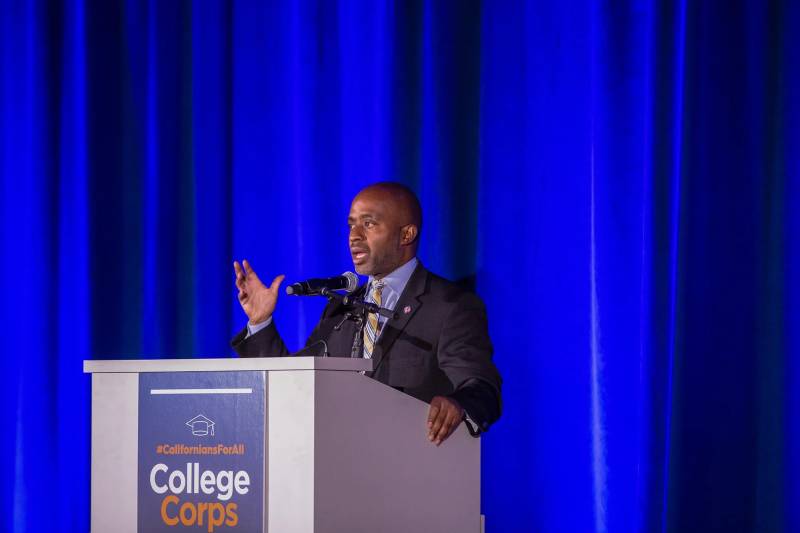
This story was originally published by CalMatters. Sign up for their newsletters.
State Superintendent of Public Instruction Tony Thurmond has regularly taken side jobs running Bay Area nonprofits during his tenure as California’s elected schools chief, earning tens of thousands of dollars to supplement his income, financial disclosures show.
Thurmond has reported working part-time for four different nonprofits since he was elected superintendent of public instruction in 2018 — most recently as director of the Berkeley Food Pantry, for which he earned between $10,001 and $100,000 last year, according to his statement of economic interests.
The arrangement is not illegal under California law, but it is highly unusual for someone holding statewide elected office. Ten other people have served as statewide constitutional officers during Thurmond’s six years as superintendent of public instruction. None of them reported compensation from an outside job that they worked during their time in office, though several had considerable investments or other secondary income streams.
And on at least two occasions, Thurmond solicited a major contribution for a nonprofit that was paying him from a person or company with business before the state — including once last year using a connection that he made through the superintendent of public instruction’s office.
Thurmond, who is running for governor in 2026, told CalMatters in an interview that he needed the additional income to support his children and several other family members with illnesses whom he is caring for. He said the annual salary for the superintendent of public instruction — which was $203,343 last year and increased to $210,460 in December — is lower than that in some other states and local school districts.
“I have needs that are beyond what the salary is able to provide,” he said. “Even as an elected official with a good job, I have needs. I have two children I’m responsible for, including paying for their education and housing costs.”
Thurmond said the side jobs had no impact on his work as superintendent of public instruction, a nonpartisan office that oversees the California Department of Education and leads the State Board of Education. He said none of the money he raised for the nonprofits paid for his own salary.
“There’s no conflict there. I’m not getting any personal benefit or political benefit,” he said. “I fail to see what conflict of interest there could be.”
‘Isn’t being an elected official a full-time job?’
Thurmond began his career in social services and nonprofit management, and he continued to serve as the senior director of community and government relations for the Oakland-based anti-poverty organization Lincoln Families after he was elected to the state Assembly in 2014. State legislators received a $97,197 salary and a $168 daily allowance while in session at that time.
Since entering the superintendent of public instruction’s office in 2019, he has cumulatively reported earning between $33,506 and $331,000 from outside work on financial disclosure forms, which only provide a range for income. In addition to his work with the Berkeley Food Pantry, this includes stints as interim part-time managing director of homeless services for the socially conscious San Francisco performing arts company Anne Bluethenthal and Dancers; as interim executive director of Worksafe, an Oakland-based organization that advocates for worker health and safety; and as development manager for the San Francisco Study Center, which provides technical assistance to nonprofits.
Nothing in state law prevents public officials from also holding private employment, though they are prohibited from making governmental decisions that would affect their own financial interests.
But Sean McMorris of California Common Cause, a nonprofit that advocates for governance in the public interest, said it’s so rare among statewide elected officials because it raises other ethical questions about how politicians are splitting their time and whether they merely have been hired for access to their political contacts.
“When are you doing it on the side? Isn’t being an elected official a full-time job? So how do you parse that out?” said McMorris, who is transparency, ethics, and accountability program manager for California Common Cause. “That’s why they get paid a salary.”
Thurmond said his outside work was no different than when he was a part-time local elected official — he served on the Richmond City Council and the West Contra Costa Unified School District board before he ran for the Assembly — and had to work a full-time job to support himself. He said he had chosen to take outside work in the nonprofit sector, rather than at a private company, “because I want to still feel like I’m making a difference.”
“Maybe one day the voters will choose to remunerate elected officials at a higher level,” he said, adding, “I’m not complaining. People are working two or three jobs to make ends meet.”
His job with the Berkeley Food Pantry began in November 2023 and ran through June 2024, Thurmond said. He said he earned $40 per hour working between 10 and 15 hours per week, totaling about $25,000.
“It’s almost always something that I did on weekends and evenings,” he said. “I’ve given the superintendent job full-time and more, every week and every day.”
Thurmond said he had not taken any additional outside jobs since he stopped working for the Berkeley Food Pantry last June.
“At the end of the day, I think they wanted somebody who was able to help them in a full-time way,” he said. “It’s hard to find the balance of something that can be supplemental and part-time and on the side.”
The Berkeley Food Pantry did not respond to messages asking to discuss Thurmond’s employment with the organization.
Only one other statewide elected official has reported a side job on their statement of economic interests in the past six years, according to a CalMatters review.
Attorney General Rob Bonta earned between $1,001 and $10,000 working as an adjunct professor at Oakland’s Mills College in 2021. Spokesperson Bethany Lesser said Bonta taught a class before he was appointed attorney general in March 2021, when he was still a member of the Assembly.
Nevertheless, some of California’s constitutional officers do earn substantial supplemental incomes.
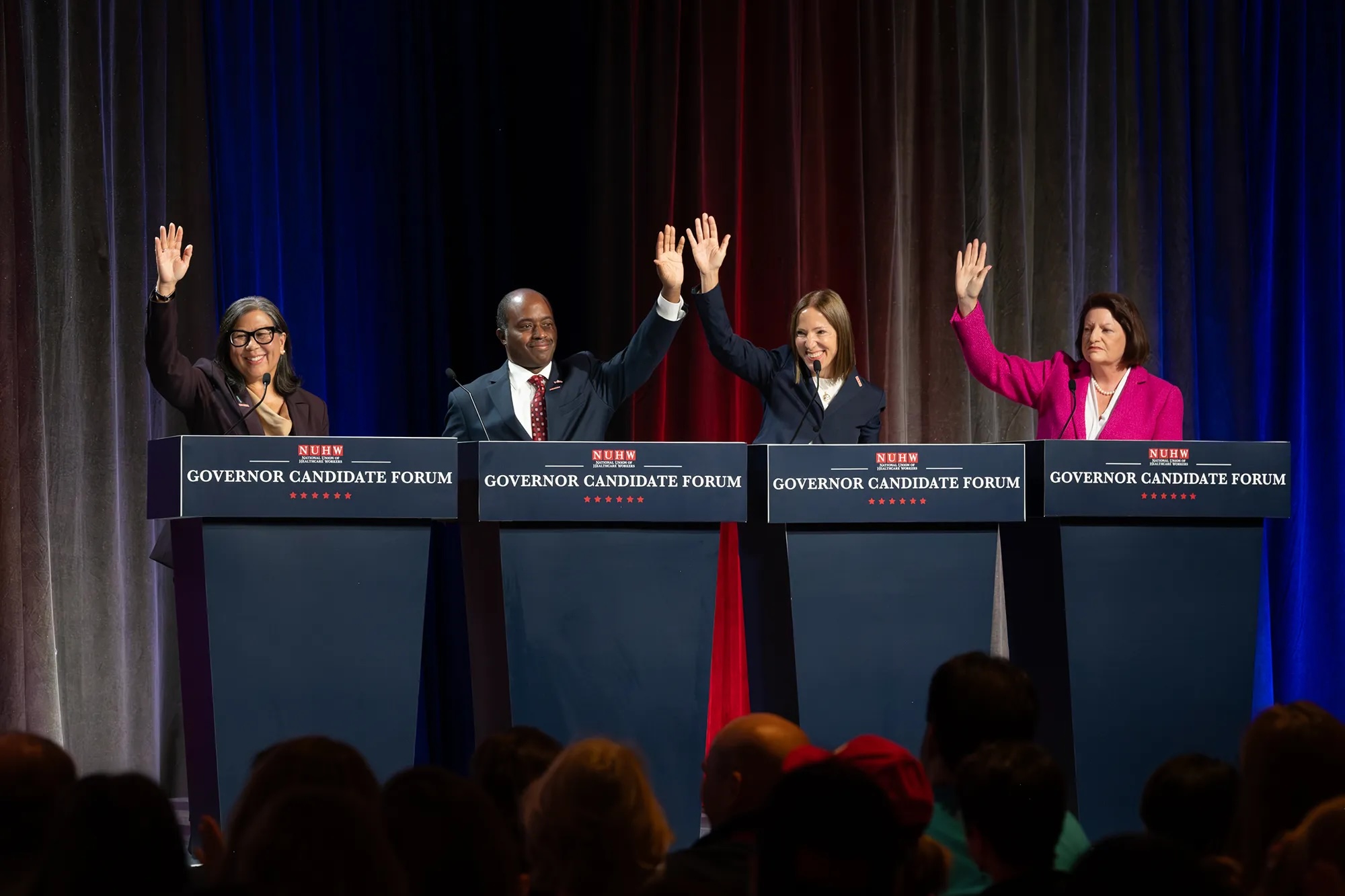
Lt. Gov. Eleni Kounalakis, the daughter of Sacramento real estate developer Angelo Tsakolopous, makes hundreds of thousands of dollars or more annually from her ownership stakes in grazing lands, orchards, solar fields and office buildings, many of which are rented out to interest groups that lobby the state. She is also running for governor.
Gov. Gavin Newsom has a wine and entertainment empire that he placed in a blind trust before taking office in 2019. He has also reported receiving four book advances of between $10,001 and $100,000 in the past five years. Since last summer, he has launched two podcasts with the iHeartMedia network, for which he is reportedly not being paid but which have nevertheless generated criticisms over potential conflicts of interest and distractions from his day job.
Thurmond directed donations to his employers
Over the past three years, Thurmond has also sought at least two donations to nonprofits where he was working at the time.
Officials in California can legally ask for contributions to nonprofits that employ them, their family or their staff members, as long as they disclose that connection when reporting the payment.
The state refers to these contributions as behested payments, meaning a donation made at the request of a public official. They must be reported to the state within 30 days when a source provides more than $5,000 in a single year.
McMorris of California Common Cause said that has created a loophole for politicians and special interest groups to potentially engage in influence peddling and purchasing.
“The problem with behested payments is that they are basically unregulated, except for disclosure,” he said. “It’s certainly a gray area that’s become more and more exploited.”
Last March, Thurmond solicited a $10,000 contribution to the Berkeley Food Pantry from Tim Ranzetta, the Silicon Valley entrepreneur behind a 2024 ballot measure to add a financial literacy graduation requirement in California.
Ranzetta runs a nonprofit, Next Gen Personal Finance, that provides free curriculum and teacher training for personal finance courses. He has successfully lobbied dozens of states to add financial literacy requirements for high school students, from which he says he does not earn any money.
According to behested payment records, the donation was made the same day that Thurmond hosted a panel discussion featuring Ranzetta, where Thurmond announced his support for Assembly Bill 2927, a legislative measure to require personal finance classes for California high schoolers by 2031. The bill quickly became law, allowing Ranzetta to pull his initiative from the November ballot. His organization remains engaged with the State Board of Education as it creates the curriculum guidelines.
Thurmond said he asked for the money from Ranzetta in his role as a nonprofit executive, not as superintendent of public instruction, but was still required to report it as a behested payment. The form cites “food delivery to community in need” as the purpose of the donation, but does not mention Thurmond’s employment with the food pantry.
He said the timing was purely coincidental and, as with all of the money that he has raised for the nonprofits he worked for, it did not go to his salary.
“None of those contributions came back to me directly,” Thurmond said. “In each of those positions, my salary was fully funded.”
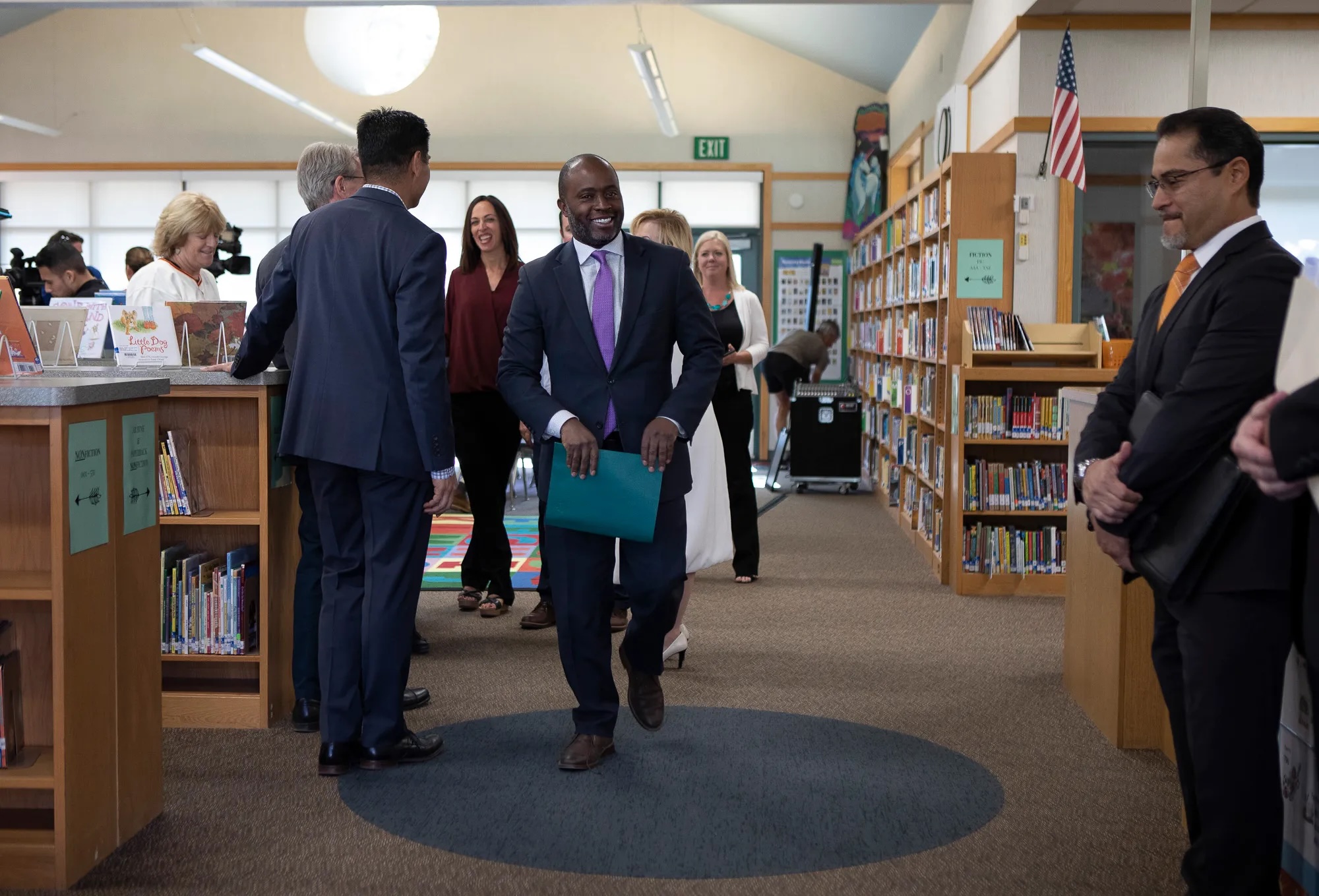
Ranzetta said he developed a relationship with Thurmond starting in August 2022, as his nonprofit began providing grants to California school districts to increase access to personal finance courses. That continued through both legislative and initiative efforts to make it a statewide requirement.
When Thurmond contacted him in March 2024 “about a nonprofit with which he was involved called the Berkeley Food Pantry,” Ranzetta wrote in an email, he was happy to donate to what seemed like a good cause, “consistent with my experience with other individuals I respect contacting me about charities which they think have merit.”
He said it did not come up in their conversation whether Thurmond was asking for the money as superintendent of public instruction or an employee of the Berkeley Food Pantry. Ranzetta was not aware that Thurmond was then working as the director of the food pantry and received a salary.
“To me, it was like anyone else I knew who called about a charity she or he supported,” Ranzetta wrote.
Four months later, Thurmond received a warning (PDF) from the Fair Political Practices Commission for failing to report on time a November 2022 behested payment from Pacific Gas and Electric Company.
According to the records, PG&E gave $10,000 at Thurmond’s request to Josie’s Place, a grief support program run by the San Francisco Study Center, where he was then working as the development manager. Thurmond finally reported the donation in February 2024, stating that, “No portion of funds will be used to compensate SPI Thurmond or any other employee of Josie’s Place per the grant restrictions.”
Thurmond told CalMatters that he did not approach PG&E as superintendent of public instruction, but rather filled out an application for one of its grant programs, which he said did not have his name on it.
Lynsey Paulo, a spokesperson for PG&E, refused to confirm that account or whether PG&E knew that Thurmond was being paid by the San Francisco Study Center at the time.
“We followed our charitable contribution process. We reviewed the request and we reported the payment in 2022,” Paulo said in a statement.
Thurmond said he has reported all of the money he raised for the nonprofits that he worked for during his tenure as superintendent of public instruction and there are no additional behested payments, even if they did not meet the $5,000 threshold. He said, “I go out of my way to make sure there are no conflicts” with his outside work.
“I’m honored that I get to be in a position to support our state and support important charities,” he said. “I’ve enjoyed being a public servant for 17 years, and everything I’ve done is above board.”
This article was originally published on CalMatters and was republished under the Creative Commons Attribution-NonCommercial-NoDerivatives license.
Low Turnout, High Stakes: District 3 Election Could Shift Power in San José 3 Apr 6:00 AM (22 hours ago)
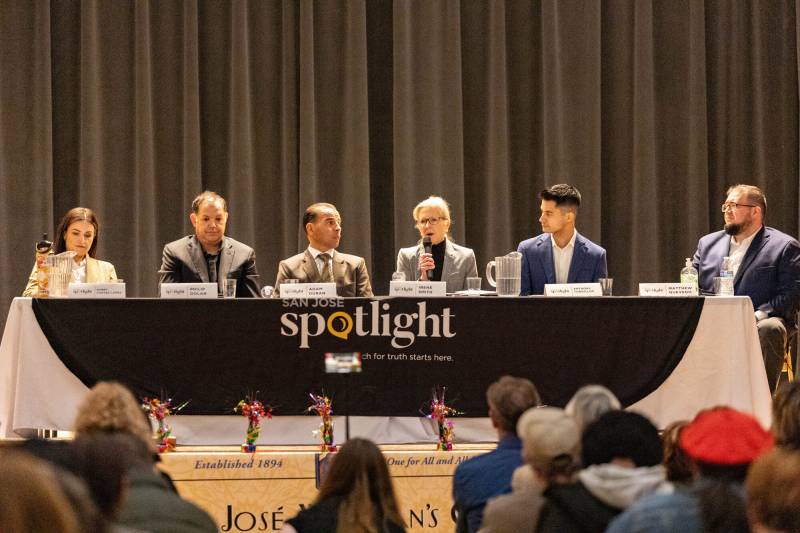
Next week’s special election for the District 3 seat on the San José City Council could help shape the balance of power at City Hall — and the future of Mayor Matt Mahan’s ambitious policy agenda.
Seven candidates are on the ballot in Tuesday’s election, which was scheduled after former Councilmember Omar Torres resigned in November. He was arrested on the same day and charged with child molestation. If no candidate receives a majority of the vote, a runoff between the top two finishers will be held on June 24.
Carl Salas, an engineering executive, was appointed to fill the seat until a new council member was elected, giving Mahan a clear majority of allies on the council. On the campaign trail and in interviews with KQED, the candidates expressed stark differences in their opinions of Mahan’s most controversial proposals, specifically his plans to prioritize city homelessness dollars for short-term housing and arrest unhoused people who refuse multiple offers of shelter.
“It’s really turning into a referendum on the mayor’s agenda,” said Bob Staedler, a land-use consultant and finalist for District 3’s interim appointment.
Under San José’s system of governance, the mayor does not have the power to sign or veto legislation but must instead find five other votes to build a majority coalition on the council.
Currently, Mahan has at least five Council members who appear aligned with his plans, particularly on homelessness, in Salas, Michael Mulcahy, Bien Doan, Pam Foley and George Casey.
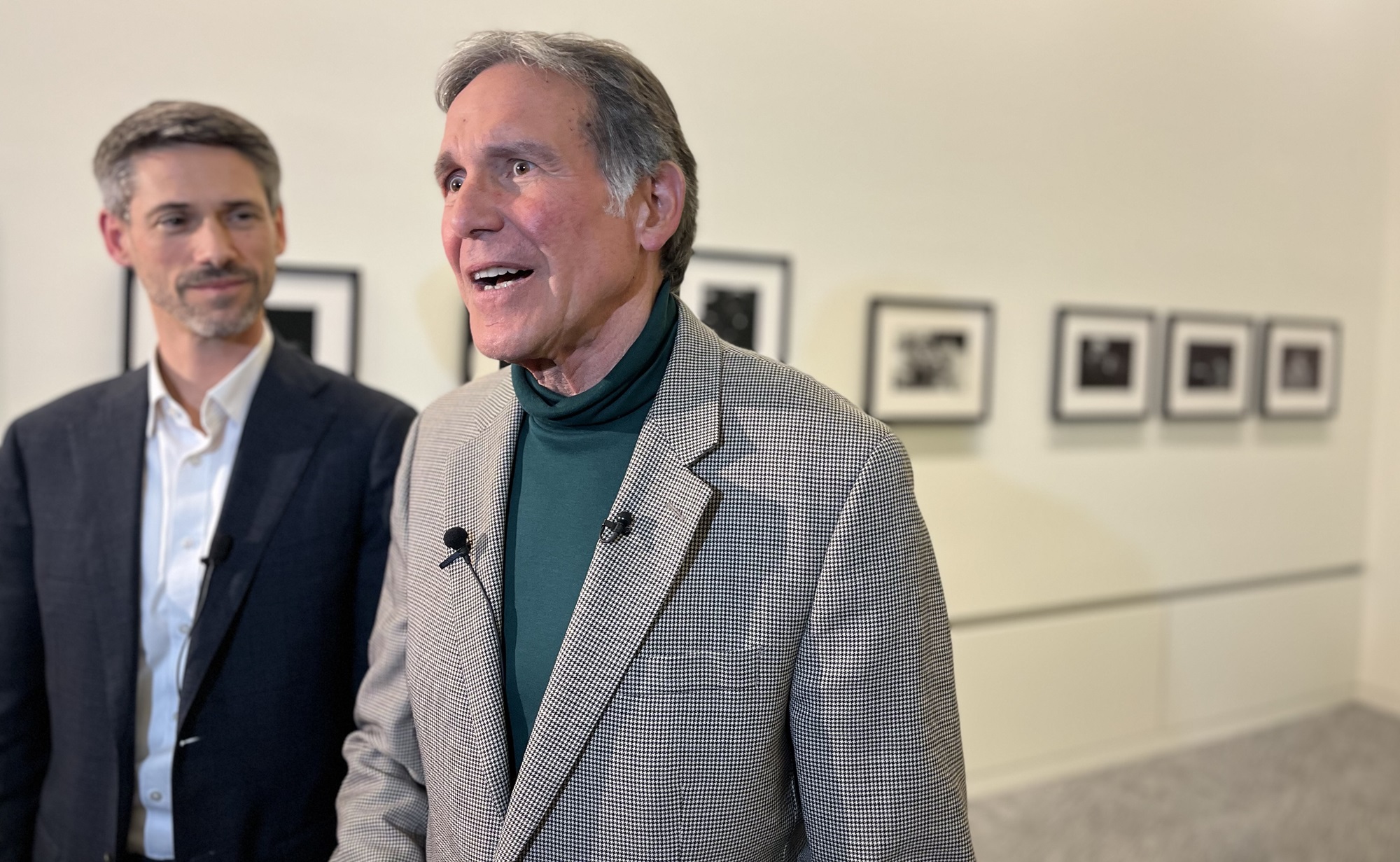
If Salas is succeeded by a candidate who opposes some or all of Mahan’s platform, more power could shift to council members seen as swing votes, particularly District 1 representative Rosemary Kamei. Last month, Kamei voted to give Mahan’s budget, which included his plans on homelessness, initial approval.
The candidate in the District 3 race most closely aligned with the mayor’s agenda is Matthew Quevedo, who has worked as Mahan’s deputy chief of staff and received his endorsement. Quevedo is the only candidate who has voiced clear support for Mahan’s plan to have people experiencing homelessness face arrest if they refuse three offers of shelter within 18 months.
Unless a candidate wins the District 3 election outright in April, the new council member will take office after the council is expected to take a final vote on the shelter-or-arrest plan in June. Debates over the city’s strategy to reduce homelessness are likely to be an annual point of contention for the foreseeable future.
Quevedo has campaigned on being a reliable sixth vote for Mahan’s long-term vision of redirecting transfer tax dollars raised through Measure E away from permanent affordable housing and toward short-term housing and shelter.
“Building six votes for that and getting people off the streets is of utmost importance,” Quevedo said. “On solutions like interim housing and getting people off the streets more immediately, I would be a proud vote and a proud majority vote on making that happen faster.”
Quevedo said he would not agree with Mahan on every vote. He pointed to the council’s unanimous approval in February of digital billboards in downtown, which Quevedo and the rest of the District 3 candidates opposed.
The sharpest critiques of Mahan’s plans have come from Gabby Chavez-Lopez, the executive director of the Latina Coalition of Silicon Valley, who called the mayor’s homelessness enforcement proposal jarring at a candidate forum sponsored by San José Spotlight in March and said it made her “question what city I live in.”
Chavez-Lopez said she campaigned in 2020 to pass Measure E, which taxes property sales of $2 million or more and raises around $50 million annually. In his budget plan, Mahan wants to permanently direct nearly all of the Measure E revenue to pay for temporary housing.
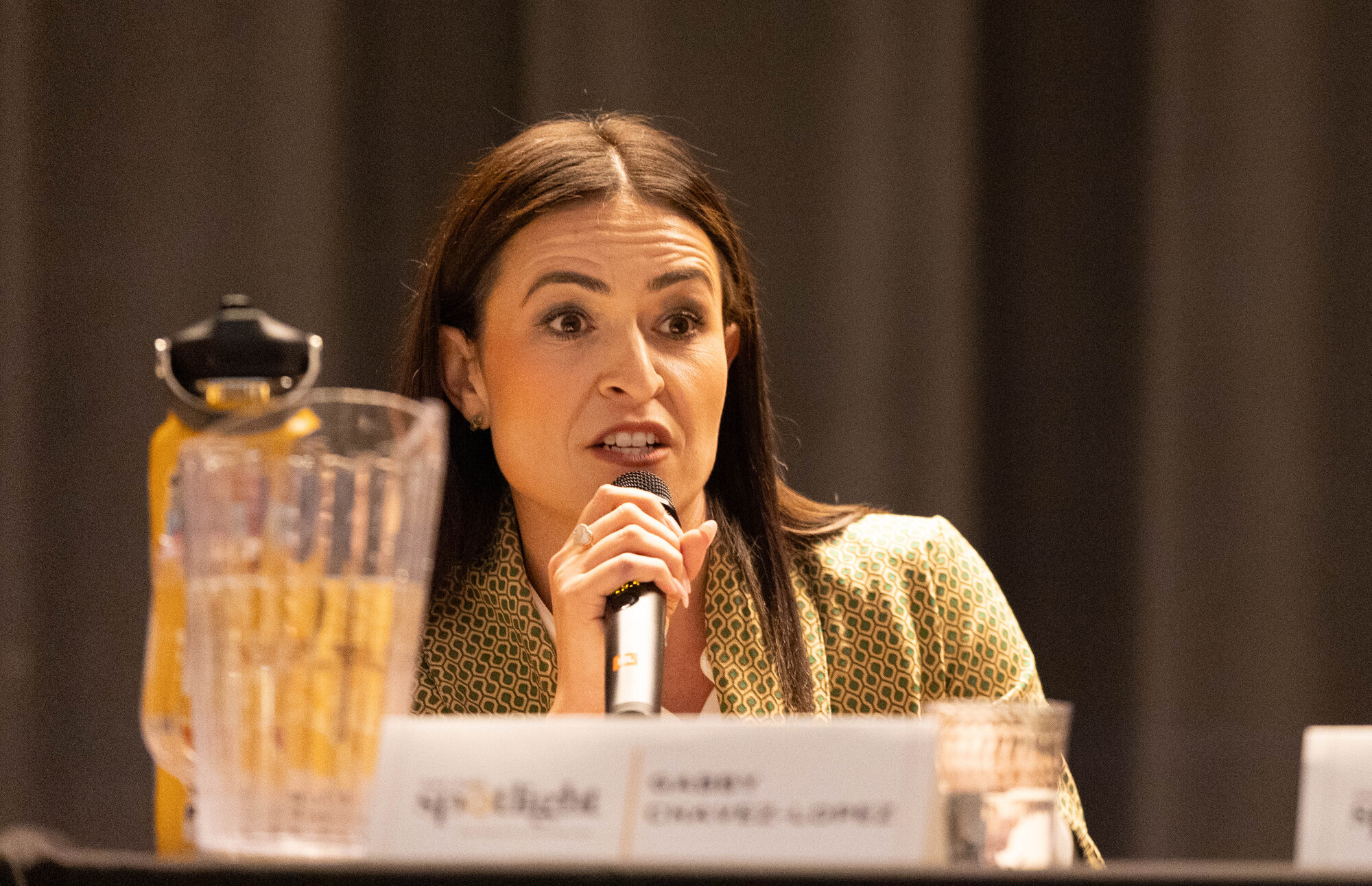
“We were telling [voters] that it was for permanent supportive housing and prevention,” Chavez-Lopez said. “So for me, in a time when trust is at an all-time low, why are we going back on that commitment to voters?”
Anthony Tordillos, chair of the San José Planning Commission, said he could support spending more Measure E dollars in the short term to fulfill the council’s commitment to building out tiny home villages and parking lots for people living in their cars.
He opposes a permanent funding shift.
“Over time, we need to make sure that we’re getting back to a balanced allocation of Measure E dollars between both shelter spending as well as affordable housing,” he said.
Both Tordillos and Chavez-Lopez are endorsed by the Santa Clara County Democratic Party, which has typically lined up on opposite sides of Mahan in city elections.
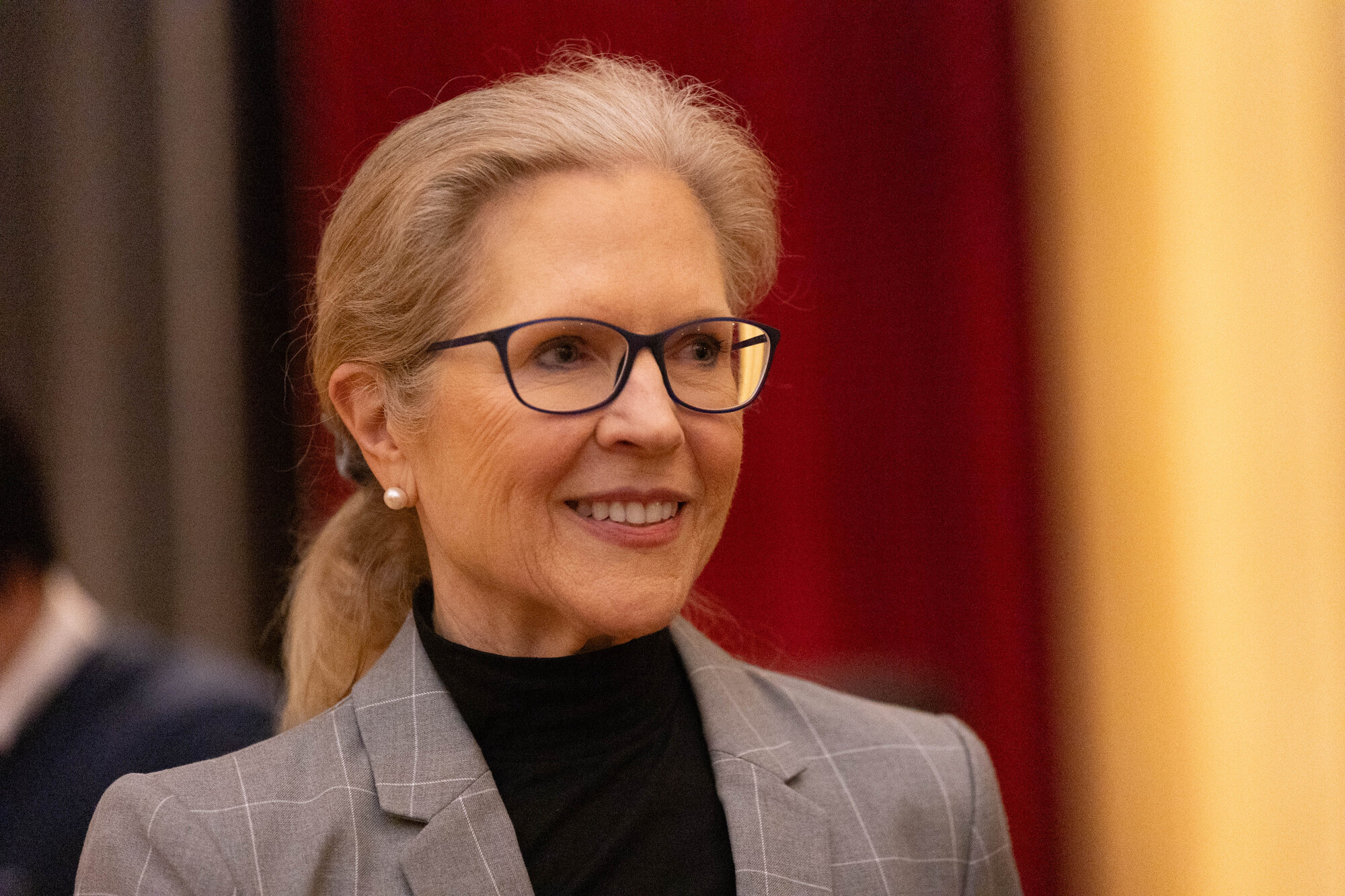
Irene Smith, a financial analyst and neighborhood activist, said she would push to fund larger congregate shelter developments instead of the tiny home models preferred by Mahan.
“While we’re waiting for the housing to be built, whatever it is — tiny homes, permanent supportive housing, group homes — let’s offer [unhoused] people an incrementally better way of living right now,” Smith said.
Adam Duran, a former lieutenant with the Santa Clara County Sheriff’s Office, said his focus would be on opening mental health and drug treatment facilities.
While City Hall insiders will be closely monitoring the outcome of Tuesday’s election, the expected low voter turnout could make it difficult to draw any clear conclusions on how the electorate is viewing the policies advanced by Mahan and the council.
As of Wednesday, just 8% of registered voters in the district had cast a ballot. Staedler said such low turnout adds a new level of volatility to the race.
“I think this is going to be one of the more unpredictable votes that you’re going to see in a while,” Staedler said.
If Your Employer Demands a Return to the Office, What Options Do You Have? 3 Apr 3:00 AM (yesterday, 3:00 am)

Five years ago this month, millions of Americans began working from home as companies adapted to the sudden realities of the COVID-19 pandemic.
As the coronavirus spread nationwide, individual states — including California — ordered residents to stay in their homes to minimize infections. And while some exceptions were made for workers considered “essential,” by April 2020, a Gallup poll found that 62% of employed Americans had begun working from home.
However, even as remote work swiftly became a new normal for many employees, the shift to widespread “working from home” was not permanent. As soon as the strictest public health restrictions were lifted, some companies around the country began calling their employees back to the office, while others instituted hybrid schedules where staff could mix in-office work with remote work.
And now, in recent months, several major employers are changing or abandoning those hybrid schedules completely — with companies like Meta, Amazon, Salesforce and JPMorgan ordering their staff to increase their in-office attendance. On March 3, Gov. Gavin Newsom signed an executive order (PDF) ordering most state employees to work in-person at least four days a week starting July 1, stating that “When we work together, collaboration improves, innovation thrives, and accountability increases.”
However, going into the office more often can be a major adjustment for many reasons. These include the length — and expense — of commuting and losing flexibility that remote work can afford people with personal responsibilities like raising a child, taking care of a loved one or dealing with their own health issues. This flexibility, advocates say, has allowed working mothers to be more involved in their careers while they balance child-raising and granted more job opportunities to folks living with disabilities and chronic health conditions.
So if your employer suddenly demands that you increase your in-office hours, what can you do — and what rights do employees even have when it comes to return-to-office mandates? We spoke to several legal experts who focus on employment law to understand what options remote or hybrid employees have in 2025 if they are asked to come to the office more — and how to best advocate for your particular needs.
When it comes to return-to-office mandates, your employer has the upper hand
“The employer always has the right to set the terms and conditions of employment,” said Christine Long, partner at Berliner Cohen, a San José-based law firm that provides employers with legal representation — “as long as the employee is given notice in advance of those things.” Adequate notice, Long said, “is usually considered a pay period in advance.”
Even if you moved to another region — or even another state — during the pandemic, your employer can still require that you come into the office any number of days during the week. And if you were hired during the pandemic while you were living in another state, it’s likely your employer can also ask for you to move to California. The employer usually has the right to change the terms of employment, Long told KQED.
Ella Zhang, managing partner at the San Francisco and Palo Alto offices of Sanford Heisler Sharp McKnight — a firm that offers legal services to workers — agrees that businesses have the upper hand here. Ultimately, “the employer has the discretion to set how many days they require their employees to go back to work,” she said.
Zhang acknowledges that going to the office more could absolutely make it harder for employees to maintain a work-life balance — particularly caregivers. “If they’re raising a child, especially a young child,” she said, “If the employee is caring for an elder at home potentially with medical conditions, they would have concerns about returning to work.”
However, at the state level, there is still no law in place that requires employers to set up hybrid work schedules for parents or caregivers. During the pandemic, Long said, “there was no order that said ‘you must work from home.’ The order was that you are not to be out unless you’re performing essential services.”
There is one state law that does allow employees to request accommodations, including working from home in very specific circumstances. In 1959, California passed the Fair Employment and Housing Act (FEHA), which states that employers cannot discriminate against employees based on several factors, including a medical condition or a physical or mental disability.
Being a parent or a caregiver, however, is not one of these factors — and “just getting your kid to and from school or needing child care in the afternoon, those are not accommodations,” Long said. (In San Francisco, however, employees who are parents or caregivers are afforded some additional protections thanks to the city’s Family Friendly Workplace Ordinance [FFWO] — more on that in the next section.)
If you do plan to request certain accommodations from your employer due to your health or disability, keep in mind that while your employer is not allowed to ask for a diagnosis, they can ask you for a medical note from your healthcare provider confirming that you have a disability and listing the ways in which it limits you. You can contact California’s Department of Rehabilitation to better understand which disabilities and health conditions are included under FEHA.
If you are granted accommodations under FEHA, Zhang said that your employer needs to make sure you will not be adversely impacted in the workplace as a result. Employees, she said, “should not get excluded from important projects or assignments and not be retaliated against because they have this reasonable accommodation.”
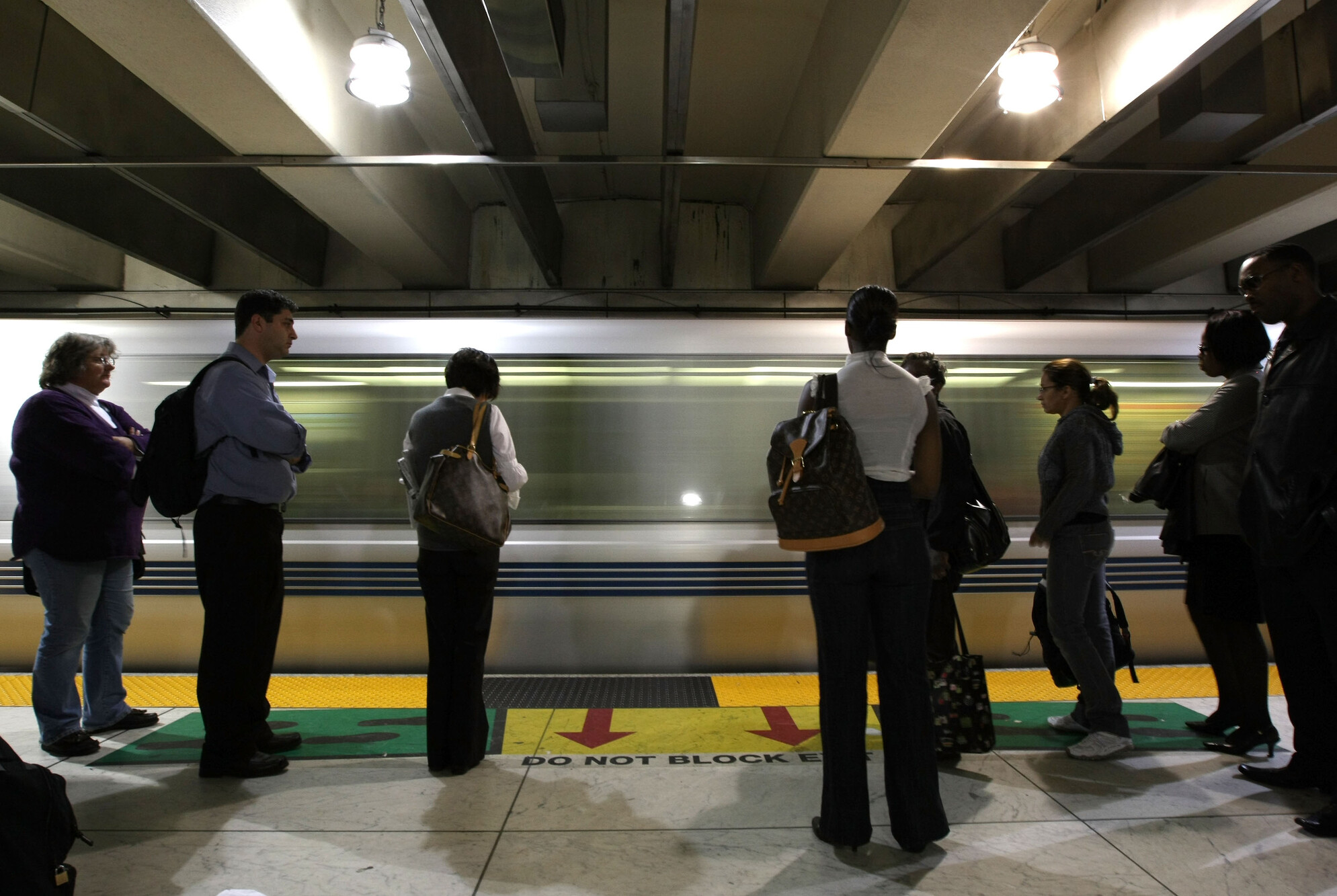
If you work in San Francisco, you may have more ability to push back against return-to-work mandates
In 2022, San Francisco expanded its Family Friendly Workplace Ordinance (FFWO), which sets up rules for SF-based employers with 20 or more employees. “The ordinance allows people to make requests of their employer to help them with parenting, family caregiving or caring for an older adult in their family,” said Katherine Wutchiett, senior staff attorney at Legal Aid at Work, a San Francisco-based legal aid office that offers services across California.
“People can request things like adjusting their schedule to make it possible to do daycare pickup, or requesting to be on projects that have more predictable hours,” she said. “There’s not a set list of what people can ask for, but it’s just changes that would allow them to be able to take care of their family.”
To qualify for accommodations under FFWO, you must:
- work in San Francisco, or be assigned to your employer’s San Francisco office (you don’t need to live in San Francisco);
- work for a company that has at least 20 or more employees;
- work with this employer at least eight hours per week on a regular basis, for at least six months;
- be responsible for the care of either a child (your own or a child you’re a guardian of), a family member with a serious health condition, or a family member 65 or older.
You must submit the FFWO request for accommodations to your employer in writing. If you’re unsure how to get started, San Francisco city officials have created a sample FFWO form (PDF) that you can complete yourself and submit to your employer.
“Using the [sample] form can be a great way to make the request because there are some employers that don’t know that this law exists,” Wutchiett said. “It educates the employer that this is actually a San Francisco city ordinance.”
An employer can deny your request, but according to city notices (PDF), your employer can only deny your request once they have met with you to discuss alternatives — and they must also show that accommodating your request would cause them “undue hardship.” Your employer must provide you an explanation in writing and you have the right to file a complaint with the city’s Office of Labor Standards Enforcement (OLSE).
If you believe that your employer has ignored your request — or is not following the terms of the FFWO — you can contact OLSE directly.
You can still try to advocate for yourself in the face of an employer’s return-to-office announcement
If you don’t work in San Francisco and aren’t therefore covered by the city’s Family Friendly Workplace Ordinance, you frankly have fewer options available to push back against an employer who’s demanding that you come into the office more.
And even though it’s possible to still talk to your employer to propose alternatives, the legal experts KQED spoke to recommend that you exercise a degree of caution when trying this — to make sure you don’t accidentally jeopardize your job.
“People can certainly talk to their employer about standards and ask questions,” said Wutchiett from Legal Aid at Work. But, “they should be careful knowing that if they say to their employer, ‘I absolutely cannot come to work more than two days a week in person,’ and their employer wants to set a four day in-person requirement, that might make it difficult for them to continue in their job,” she warned.
You also want to be proactive in initiating any conversation like this with your employer, recommended Zhang from Sanford Heisler Sharp McKnight. “As soon as [employees] learn about the change in the in-office workday policy, they should start thinking about raising the accommodation request with the employer, and they need to do that as soon as possible,” she said. “They can’t be sitting on the policy for a long time and not say anything until the last minute.”
Make sure you know the right person to talk about your company’s policies, Zhang adds — whether that’s your direct supervisor or the human resources department — and then communicate with that person in writing, whether that’s email or text. If you end up having an in-person conversation, make sure to send an email or another type of written message to who you met — confirming what you discussed and potentially agreed to.
“That way it’s very clear as to who said what, and it’s really the best way for employees to protect themselves,” Zhang said.
When talking to your employer, Wutchiett also suggests highlighting how remote working or a hybrid schedule has helped you become a more productive worker — ideally with concrete examples.
“One thing we learned from the pandemic is that a lot of people are able to work really successfully from home,” she said. “Think through the ways that you’ve been successful over the last couple of years, how you’ve been able to accomplish your employer’s needs while still working from your home and being able to point out that in the ways it benefits both the employer and yourself.”
“That can be a way to have a friendlier conversation about what that transition to go back might look like,” she added.
And if you’re planning to request for an accommodation under California’s Fair Employment and Housing Act (FEHA), remember that there is a process both you and your employer must follow.
“Once you make that [FEHA] request, your employer has an obligation to engage in a good faith interactive process with you, to determine how they can accommodate you,” Wutchiett said. Employers are required to provide reasonable accommodations that would allow you to fulfill your essential functions at work, she explained, unless they can show that it would cause them “an undue hardship.”
If you’re part of a union, check in with them about your employer’s return-to-office mandate ASAP
According to 2023 data from UC Berkeley’s Labor Center, 16.2% of working Californians form part of a labor union (PDF). If you’re one of them, your union could well be an additional resource when talking with your employer about returning to the office.
“It is always important to seek out your shop steward, your union leadership, and try to get the help that they can provide for you,” said Lorena Gonzalez, president of the California Labor Federation. She adds that union leadership can walk you through the finer details of the collective bargaining agreement that exists between workers, the union and the employer.
“If you have a collective bargaining agreement with your employer, it’s really important to know the conditions of it,” she said. “Some things were bargained for during and after COVID that have to be taken into consideration.”
Unions and employers re-negotiate their collective bargaining agreements every few years and if negotiations are coming up at your workplace, remote working options could be something you tell your union that you’re interested in being considered for negotiations.
Returning to the office “absolutely something that could be collectively bargained,” Gonzalez said. “It’s usually up to the union and the membership of the union what the priorities are at the bargaining table.”
And even if contract negotiations are not scheduled for the near future, she stressed the support that a union can offer its members in these kinds of labor matters. She points to the organizing and legal efforts led by SEIU Local 1000, which represents tens of thousands of state employees, as they push back against Gov. Newsom’s return-to-office mandate.
“When we work collectively with the union, we’re able to have a much stronger voice,” Gonzalez said — “and we’re able to force employers to deal with issues that otherwise they would like to just mandate.”
Tell us: How has a return-to-office mandate affected you?
Do you work for an employer that “went remote” during the height of the pandemic but has since requested that employees return to in-person work?
If you’ve experienced a return-to-office mandate, we’d like to hear from you. How did having to work in the office more days a week affect your daily life, your family or your commute — and how do you feel about it all? What positive effects, if any, has returning to the office had for you, personally or professionally?
Also, if you feel like you’ve finally made in-person work for you again, we’d like to hear your advice. How would you recommend others adapt to the shift away from remote work and back to the office? And if you worked out an understanding with your employer concerning a return-to-office mandate, what strategies worked for you?
You can use the form below to share your thoughts with us, and what you tell us could be shared in a future KQED story. You don’t have to name your employer if you don’t want to, but it will be helpful to hear about when your employer began mandating more days in the office, where your office is based and where you live.
We may use any contact information you provide to get in touch with you to ask a few follow-up questions, but we’ll never share your information outside of KQED without your permission. We won’t be able to reply to everyone who submits a question, but what you tell us will make our reporting stronger on KQED.org, KQED Public Radio and our social media channels.
https://docs.google.com/forms/d/e/1FAIpQLSeF6RelNW1w7veJkDblmQFXeX-eeH4PiQGGHdodqSbAWHmqfw/viewform?embedded=true
The ‘Trashy’ History of Berkeley’s César Chávez Park 3 Apr 2:00 AM (yesterday, 2:00 am)
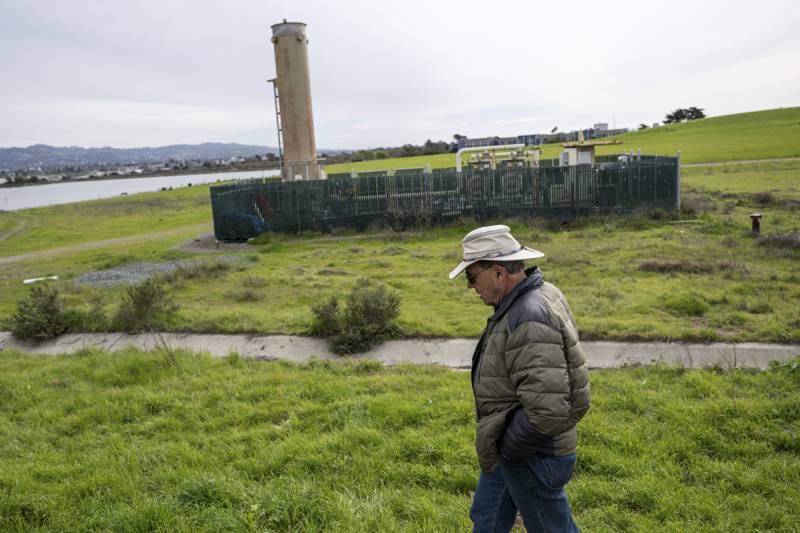
View the full episode transcript.
Bay Curious listener Tom Rauch grew up in Berkeley in the 1960s. Some of his most vivid memories from that time are of the old Berkeley dump.
“It really was just this big, giant pit where you backed up your car, opened up your trunk and just shoveled whatever you had into this open pit,” he said.
The dump was located on Berkeley’s waterfront. Rauch remembers it as the Wild West. It smelled rank and was loud, with big bulldozers constantly shifting and compacting the garbage. Seagulls were ever-present, squawking above the roar of the machinery.
“As a little kid, of course, I was fascinated by this because there were all manner of things,” Rauch said. “There [were] refrigerators and lumber and whatever people didn’t want. It was just sitting right there, and the bulldozers would come and push it over.”
Fast forward to today, and the dump is long gone. In its place is César Chávez Park, a big grassy expanse with sweeping views of the entire bay.
Rauch visits the park from time to time, and he recently started to wonder about the old dump. How did it go from a squalid mass of junk to a beautiful shoreline park where people go to walk their dogs, fly kites and have picnics?
Transition from dump to park
The city of Berkeley operated the 90-acre landfill site from the mid-1950s until 1983, when it stopped receiving waste.
The site, like much of the bay’s shoreline, was saved from development thanks in large part to environmental activists like Sylvia McLaughlin, co-founder of what’s now known as Save the Bay.
City officials decided to turn the spit of land into a park. But to do that, they had to seal off the garbage to ensure nothing would leak out and contaminate the environment. They capped the landfill with soil and clay.

If you take a cross section of the park’s underground, you’d see a layer cake of soil and garbage: starting from the bottom, about four feet of garbage, two feet of clean soil, two feet of compacted clay and about a foot of topsoil on top of that, all capped with grass.
This means the garbage remains to this day. Those grassy, green hills you see when you visit the park? It’s just grass-covered garbage.
But that wasn’t always the plan for the park.
After it capped the dump, city officials started to think about how to landscape and develop the open space. Should it have tennis courts, a redwood tree grove, a playground?
They decided to solicit design proposals from landscape architects and eventually settled on a local designer named John Roberts. Roberts studied landscape architecture at UC Berkeley, where he graduated in 1974. His firm focuses on ecological and socially conscious landscape design. And he had all kinds of ideas for the park.
He was collaborating with another consultant based in Seattle named Richard Haag, who had worked on landfill conversions before.
“What was revelatory to me was what Rich Haag had done in Seattle, which was to treat the landfill as a giant compost pile,” Roberts said.
In other words, instead of capping and forgetting about the garbage, they proposed digging it up, cleaning it up and encouraging it to break down naturally, with the help of the already-existing bacteria and microbes.
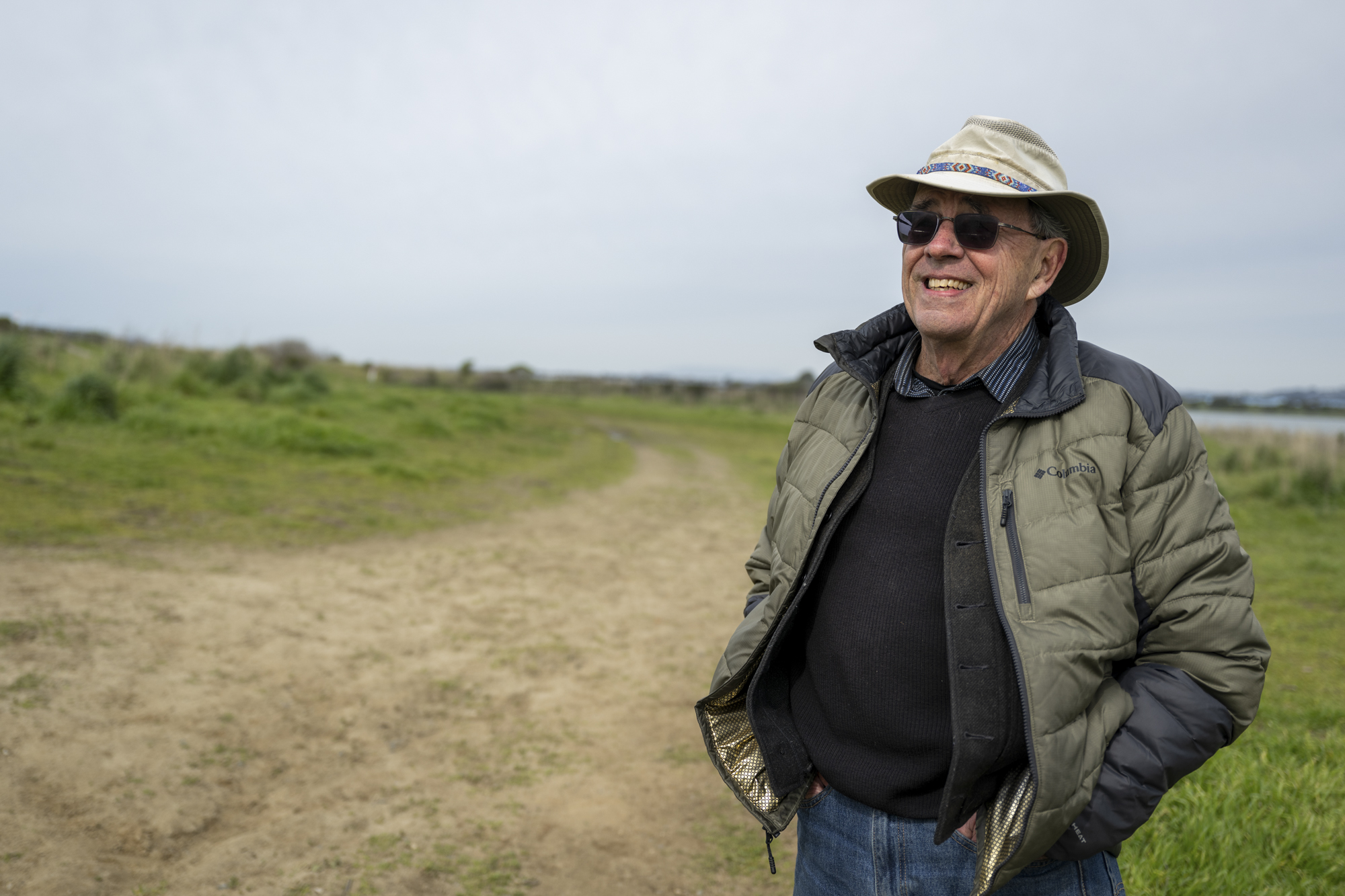
“The garbage is being cleaned up by the bugs that are here, and we could use that to our advantage,” he said.
Roberts and his collaborators wanted to return the land to as close to its original form as they could before it was inundated with garbage. Their proposal included things like cultivating native plant species, dedicating space to wetland habitat and even building a beach where humans and animals could access the bay more easily.
Roberts spent seven years on the project. However, when it came time for approval, the city decided not to move forward with the proposal.
“They had a 57-word phrase that said how much they liked the plan and how it reflected all their values, but they couldn’t approve it,” Roberts said.
The proposal was bold and broke a lot of norms for landfill restoration. Roberts suspects it was too much of a hassle for the city and that money was probably a factor, too.
He was extremely disappointed.
“I didn’t come out here for 15 years,” he said. “I could see what it could have been. It could have been something so much different.”
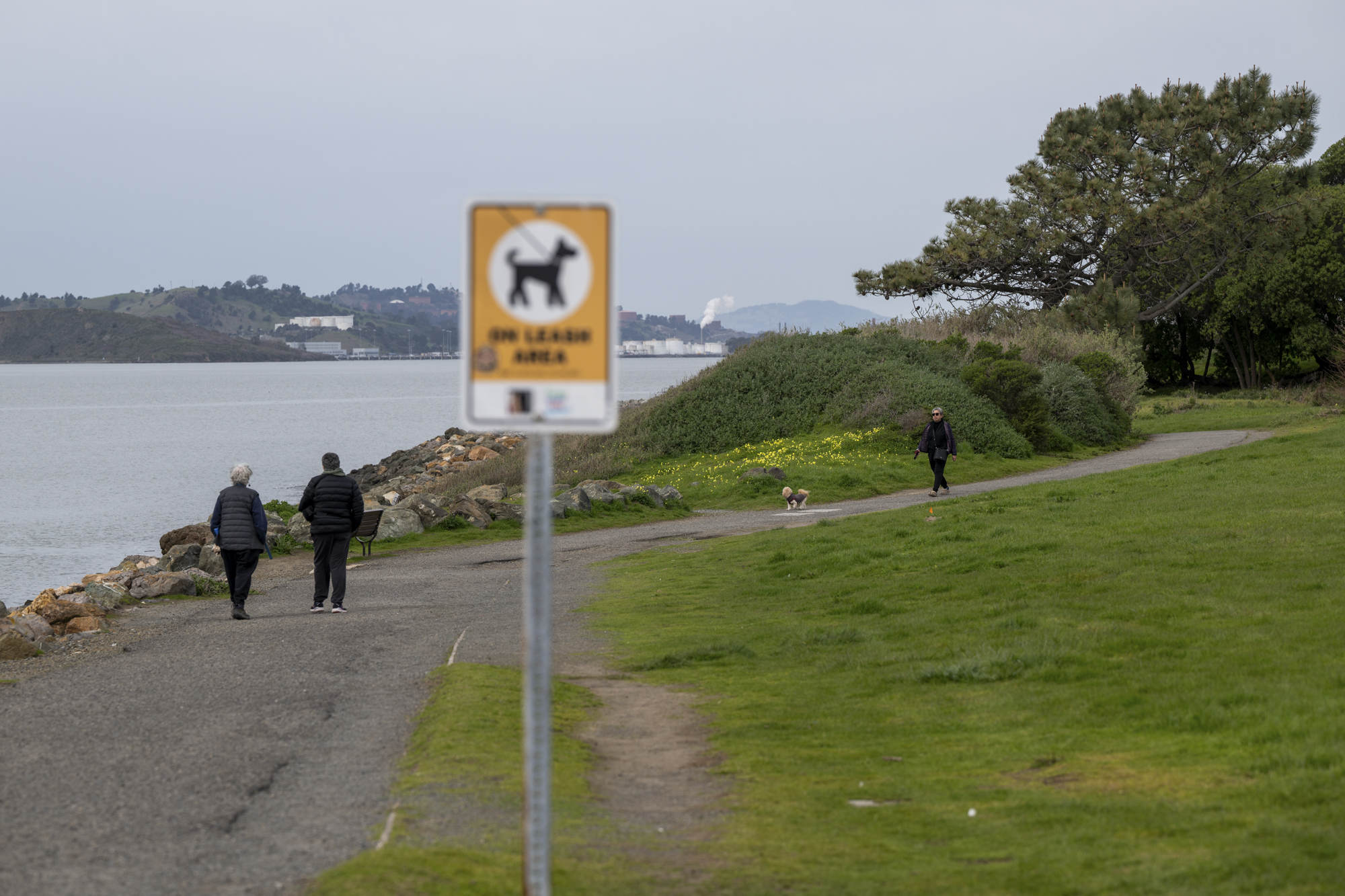
Bumps in the road
Leaving all that trash underground has led to some complications for the city of Berkeley.
As it breaks down, the garbage produces methane, which is a combustible gas. Leaving it there is dangerous, so instead, the city installed a series of underground pipes to collect the gas and send it to a flaring station, where it burns off.
The flaring station is located on the east side of the park, near the dog area. It’s a bit of an eyesore — and it can also be dangerous.
The Bay Area Air District has issued numerous notices of violation to the city of Berkeley over its management of the landfill flaring. Violations include missing gas collection wells, severe methane leaks and failure to continuously operate the system during power outages.

Last year, the air district fined the city $130,000 for air quality violations at César Chávez Park.
Berkeley city officials declined a request for an interview for this story.
In addition to air regulators, water regulators have also kept close tabs on the park. That’s after archival documents emerged (PDF) showing that more than 11,000 tons of industrial waste believed to contain radioactive material was disposed of at the Berkeley dump in the 1960s and ’70s.
It all started in May 2023, when Keith Roberson, who oversees landfills for the San Francisco Bay Regional Water Quality Control Board, was talking on the phone with a colleague at the EPA’s Department of Toxic Substances Control (DTSC), which oversees hazardous waste sites.
“My counterpart at DTSC mentioned, you know, ‘By the way, I have run across a document that I want to share with you that indicates that the Berkeley landfill apparently had accepted some material from a chemical plant in Richmond that was known as Stauffer Chemical,’” Roberson said.
The water board immediately sent a letter to the city of Berkeley asking them to conduct radiation testing at the park, which they did late last year. With the help of UC Berkeley experts, the city attached a highly sensitive radiation sensor to a drone and flew it over the park.
“There’s really no indication from the Gamma survey that there are any places on the surface of the Berkeley landfill that pose a threat to human health,” Roberson said.
However, the city also collected water samples during its survey, and those results showed elevated concentrations of radium-226 — a radioactive compound.
“Whether or not that poses any threat to humans above the surface, we don’t think so,” Roberson said. “Does it pose a threat to water quality in the bay? We don’t think so. But we’re still in the process of analyzing that.”
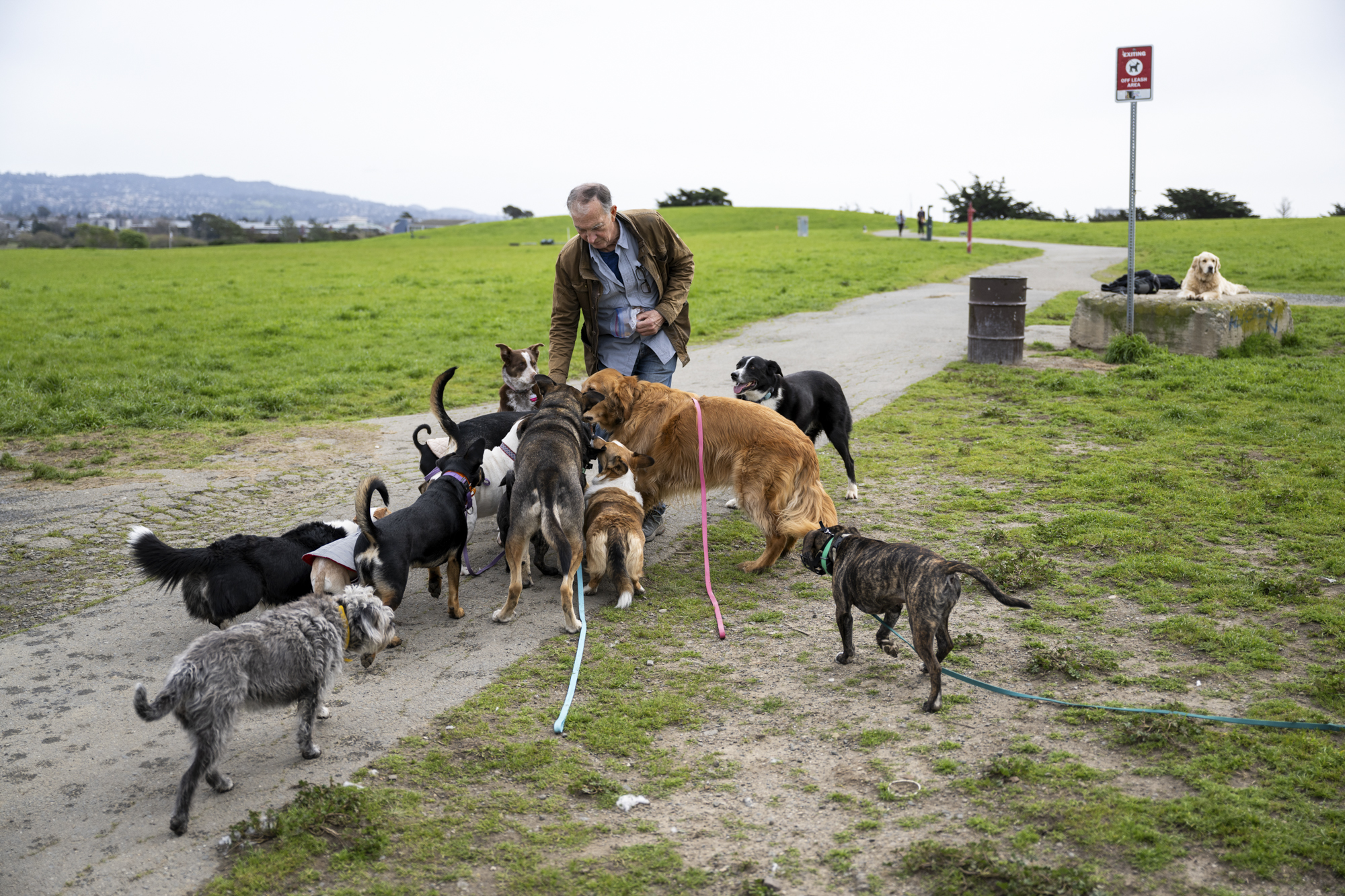
Alternate uses for shuttered landfills
César Chávez Park isn’t the only former landfill-turned-beautiful park in the Bay Area.
The Albany Bulb, for example, used to be a dumping ground for construction debris. The Bulb was also recently tested for radiation, and levels there were also not dangerous to human health.
The Petaluma dog park, Byxbee Park in Palo Alto, are also former dumps!
“From the water board’s perspective, that’s probably our preferred usage,” Roberson said.
Turning former landfills into open space is generally a low-risk use, said Roberson, especially compared to something like commercial development.
However, due to the high cost of land in the Bay Area, some cities are doing just that.
The city of Santa Clara, for example, approved a plan late last year to put a shopping center, office space and even condominiums on a former landfill site near Levi’s Stadium.
That’s more concerning, Roberson said.
“Landfills contain organic material that’s decomposing,” he said. “So the landfill surface is subsiding, and it doesn’t subside evenly. Some parts may drop four feet, some parts may drop 12 feet. So you get this very uneven hummocky surface.”
It takes a lot of additional planning to safely put a building on top of a former landfill, and even then, it’s risky — especially for the groundwater.
Not to mention, many former landfill sites in the Bay Area are located directly on the water line, which poses a risk as the climate changes and sea levels rise.
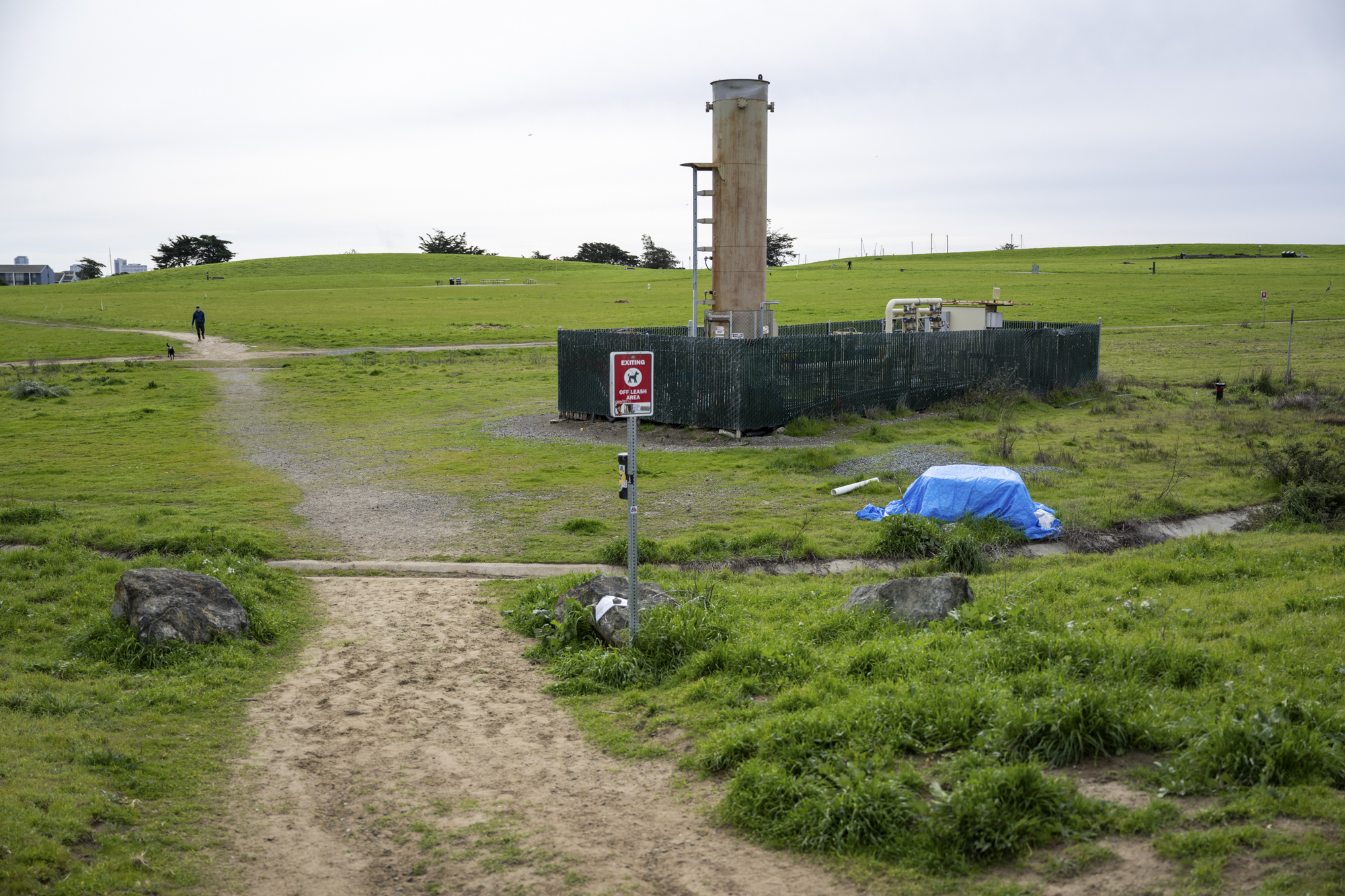
A nostalgic place
Tom Rauch, our question-asker, went on a walk at César Chávez Park recently. He wanted to refresh his memory of the place. It was a cold, rainy day. He said he was struck by how beautiful it looked and at the outstanding views of the San Francisco Bay.
But there was something tugging at him.
“I know we shouldn’t have this, but it would be so much fun if you could still drive your car to the mouth of this pit and just shovel away and have the seagulls and the bulldozers keeping you company.”
A landfill right on the water isn’t a great idea these days, he gets that. But Rauch said he’s glad his memories remain.
“There are a lot of us who grew up in that Berkeley experience that are starting to remember fondly those kinds of Berkeley days.”
===
Ask Bay Curious a question ...
Episode Transcript
This is a computer-generated transcript. While our team has reviewed it, there may be errors.
Olivia Allen-Price: Tom Rauch grew up in Berkeley in the 1960s.
He has vivid memories of that time. His mom worked at UC Berkeley and his dad was a grad student there, so he and his brother spent many days riding their bikes around campus.
Another memory he still thinks about to this day… one of his most vivid… is going to the Berkeley dump.
Tom Rauch: It really was just this big, giant pit where you backed up your car. You know, you turned around, you backed up your car, opened up your trunk and just shoveled whatever you had into this open pit.
Olivia Allen-Price: It was on the west side of Berkeley, right on the water. It was like the Wild West. It smelled rank. It was loud, with big bull dozers shifting and compacting the garbage. And then there were the birds! Hundreds of sea gulls squawking above the roar of the machinery…
Tom says back then, it seemed like the dump stretched for miles.
Tom Rauch: And as a little kid, of course, I was fascinated by this because there was all manner of things. You know, there’s refrigerators and lumber and whatever people didn’t want. It was just sitting right there and the bulldozers would come and, of course, you know, push it over.
Olivia Allen-Price: Now… fast forward to today… and the dump is long gone. In its place is Cesar Chavez park… a big grassy expanse with sweeping views of the entire bay. And Tom still visits! He goes once a month or so with his family… to walk around and take in the views. But he recently started to wonder about the old dump. Was it really the way he remembers it? How could it go from a squalid mass of junk… to this beautiful shoreline park, where people go to walk their dogs, fly kites and have picnics? So, he did some research. Or, he tried.
Tom Rauch: There is a surprisingly almost nonexistent amount of information about it there. Really. I couldn’t, maybe there are, but I couldn’t find any images of it. I couldn’t find any kind of recollections of it, any historical documents associated with it.
Olivia Allen-Price: So, he did what any Bay Area resident does when they have questions they can’t find the answers to: He reached out to Bay Curious.
Theme music
Olivia Allen-Price: I’m Olivia Allen-Price and on today’s episode of Bay Curious… how did Berkeley’s former landfill site become one of its most popular public parks? And what are some of the challenges of turning a big pile of trash into a recreational space? All that, after this break.
Sponsor message
Olivia Allen-Price: To uncover the mystery of the Berkeley dump we asked reporter Dana Cronin to see what she could dig up.
Dana Cronin: As a frequent visitor to Cesar Chavez park… I was excited about this one. I love taking my dog there to run the perimeter of the park. On a clear day, I don’t think there’s a better view of the Golden Gate Bridge. But… I was not around in the 1960s, and had no idea about the park’s former life as a landfill.
So, I called someone who does.
John Roberts: It was pretty thrilling to come down and just dump stuff out. And I don’t. You didn’t do it. I guess you were it before your time.
Dana (laughing): Yes.
Dana Cronin: This is John Roberts. He’s a landscape architect here in Berkeley. I meet him … surprise surprise… at Cesar Chavez park.
Park sounds
Dana Cronin: It’s a slightly cool and breezy morning, and we’re sitting on a park bench overlooking the bay. Ground squirrels dart around us, birds fly overhead, and a sea lion pops its head out of the water. It’s beautiful out here. But, as John likes to remind me…
John Roberts: This is garbage. We’re on our garbage.
Dana Cronin: And let me just say, talking with John has totally changed how I think about this park. Before I met him, I thought of it as a beautiful green park with great views. But John still sees it as a big pile of trash, covered in grass. He says it could have been so much more.
Music
Dana Cronin: The Berkeley dump stopped receiving waste in the mid-80’s, and the city decided to landscape it and turn it into a park.
To do that, they had to seal off the garbage… to prevent leakage and contamination. So, they trucked in a whole lot of soil.
John Roberts: There’s a four foot cross section of garbage. Then there’s two feet of clean soil and two feet of compacted clay and a foot of a foot of topsoil on top of that.
Dana Cronin: This layer cake of garbage and soil was capped with grass. And that’s pretty much how it looks to this day. Those rolling, green grassy hills? It’s all just grass-covered garbage.
But this wasn’t always the plan. After it capped the pile of trash, the city started to think about how to develop the space. Should it have tennis courts, a redwood tree grove, a playground?
The city put out a call to landscape architects for design proposals.
That’s where John comes in.
John Roberts: 1986 or ’87, something like that, there was a call for proposals and I was selected as the prime consultant.
Dana Cronin: He had all kinds of ideas. He was working with another consultant based in Seattle, who had worked on landfills before. And he had the idea to treat this site like a big compost pile.
In other words, instead of capping and forgetting about the garbage… they would dig it up, clean it up, and encourage it to break down naturally… with the help of the already-existing bacteria and microbes.
John Roberts: The garbage is being cleaned up by the bugs that are here. And we could use that to our advantage.
Dana Cronin: Ultimately, John wanted to return this spit of land to its original form — before all the garbage. Or at least, as close as he could get.
The area used to be all marsh so John wanted to cultivate native plant species… dedicate space to wetland habitat… maybe even build a beach where humans and animals could access the bay more easily.
But… as you may have guessed by now… none of that stuff happened.
After spending about seven years on this project, the city of Berkeley decided NOT to move forward with John’s proposal.
John Roberts: They found a 57-word phrase that said how much they liked the plan and how it reflected all their values, but they couldn’t approve it.
Dana Cronin: The proposal was bold and broke a lot of norms for landfill restoration. John says he thinks it was just too complicated and too much of a hassle for the city. He says money was probably a factor too.
Dana Cronin (to John in tape): How did it feel at that final vote when they endorsed but, you know, chose not to move forward with the project. How did you feel after having worked on it for so long?
John Roberts: Disappointed. I didn’t come out here for 15 years, I could see what it could have been. It could have been something so much different.
Music
Dana Cronin: Had the city moved forward with John’s proposal, the park would look much different than it does today.
It also potentially could have saved the city of Berkeley from a lot of maintenance issues that have cropped up over the last several years.
Because, as it turns out, that decision to keep the garbage underground has led to some complications.
First of all as it breaks down the garbage is producing methane. Methane is a combustible gas, so they can’t just leave it there.
Instead, they’ve put in a series of pipes underground to collect it. If you visit and look for them, you can see white access pipes sticking out of the ground every 200 feet or so throughout the park.
John Roberts: So here we are. There’s a white pipe there. You see another white pipe over there, the white pipe sticking up all over the place.
Dana Cronin: All that methane is sent to a flaring station on the east side of the park, near the dog area, where it burns off.
Flaring station ambi
Dana Cronin: The flaring station is a bit of an eyesore. And it can also be dangerous. Air regulators have issued numerous notices of violation to the city of Berkeley over its management of the landfill flaring. Violations include missing gas collection wells, severe methane leaks, and failure to continuously operate the system during power outages.
Last year the air district fined the city 130-thousand dollars for air quality violations. I did reach out to Berkeley city officials for this story. They declined my request for an interview.
Music
Dana Cronin: Now, it’s not just air regulators that have been keeping a close eye on the park. Water regulators are too. Specifically this guy…
Keith Roberson: Hi, my name is Keith Roberson.
Dana Cronin: Keith works for the San Francisco Bay Regional Water Quality Control Board. He’s responsible for overseeing landfills — both active and closed — to ensure they’re not contaminating the bay. Two years ago, he started to worry about the old Berkeley dump.
Keith Roberson: In May of 2023, I was having a phone conversation with one of my colleagues at the DTSC.
Dana Cronin: DTSC is the Department of Toxic Substances Control. It’s a part of the EPA, and it’s in charge of landfills that house hazardous waste.
Keith Roberson: My counterpart at DTSC mentioned, you know, by the way, I have run across a document that I want to share with you that indicates that the Berkeley landfill and the Albany landfill as well apparently had accepted some material from a chemical plant in Richmond that was known as Stauffer Chemical.
Dana Cronin: Hazardous material, that is. This letter was from the 1980’s, from the Stauffer Chemical company… and indicated that waste from one of their pesticide manufacturing facilities had likely ended up at the Berkeley landfill.
Keith Roberson: That’s when we first learned that, you know, there was a possibility or a likelihood that the Berkeley and Albany landfills had accepted some radioactive material.
Dana Cronin: Stauffer processed aluminum ore in their pesticide production, and the type of ore they used contains some naturally occurring radioactive elements. And this changed everything. Prior to this letter, there hadn’t been any indication that the Berkeley landfill contained any hazardous material. This was a matter of public safety.
So, Keith sent letters to both cities, asking them to do some radiation testing at their respective parks.
And late last year, Berkeley did just that. With the help of UC Berkeley experts, the city attached a highly sensitive radiation sensor to a drone, and flew it over the park.
And then, the results were in.
Keith Roberson: They did not find any spectral variation in the gamma signal.
Dana Cronin: In other words…
Keith Roberson: There’s really no indication from the Gamma survey that there are any places on the surface of the Berkeley landfill that pose a threat to human health.
Dana Cronin: So, that’s obviously a relief. But, the city also took some water samples during this survey. And Keith says, those results were a bit more concerning.
Keith Roberson: They did find elevated concentrations of radium 226 in their water samples.
Dana Cronin: Radium 226 is a radioactive compound, which, with enough exposure, can cause cancer and even death in humans. But Keith says they didn’t detect concentrations that high at the park.
Keith Roberson: Now, whether or not that poses any threat to humans above the surface, we don’t think so. Does it pose a threat to water quality in the bay? We don’t think so. But we’re still in the process of analyzing that.
Dana Cronin: But, Keith says, clearly there’s something buried in that pile of trash that’s starting to leak out.
Music
Dana Cronin: Now, Cesar Chavez park isn’t the only former landfill site-turned beautiful park in the Bay Area. The Albany Bulb — for example — used to be a landfill for construction debris. And, as Keith mentioned earlier, the Bulb was also tested for radiation. Luckily, levels there were also not dangerous to human health.
The Petaluma dog park… Byxbee Park in Palo Alto… all former dumps!
Keith says yes, there are risks with turning a landfill into open space, but…
Keith Roberson: From the water board’s perspective, that’s probably our preferred usage.
Dana Cronin: What’s more risky, he says, is trying to convert a former landfill site into, say, a commercial space. But, given the high value of land here in the Bay Area, some cities are doing just that.
The city of Santa Clara, for example, recently decided to move forward with a proposal to put a shopping center, office space and even condominiums on a former landfill site, near Levi’s Stadium.
That’s a little more concerning, Keith says.
Keith Roberson: Landfills contain organic material that’s decomposing. So the landfill surface is subsiding and it doesn’t subside evenly. You know, some parts may drop four feet, some parts may drop 12ft. So you get this very uneven hummocky surface.
Dana Cronin: He says it takes a lot of planning to put a building on top of a former landfill and, even then, it’s risky — especially for the groundwater. Also, a lot of these former landfill sites lie right on the water line, which poses a real risk with climate change and sea level rise.
Music
Dana Cronin: Tom, our question-asker, went on a walk in Cesar Chavez park recently. He says he wanted to refresh his memory of the place.
It was a cold and rainy day. He says he was struck by how beautiful it looked… and at the outstanding views of the San Francisco Bay.
Tom Rauch: And at the same time, there was that little tug about, well, you know, I know we shouldn’t have this, but it would be so much fun if you could still drive your car to the mouth of this pit and just shovel away and have the seagulls and the bulldozers keeping you company.
Dana Cronin: Tom says he gets that these days a landfill right on the water isn’t a great idea. And even though the Berkeley dump is long gone… his vivid memories of the smells, the sounds, the whole experience of the place… remain.
Music
Olivia Allen-Price: That was KQED’s Dana Cronin. Thanks to Tom Rauch for asking this week’s question. You can check out what the old Berkeley dump used to look like by heading over to Baycurious.org. We’ve got archival photos and new ones too! And while you’re there, why not sign up for the Bay Curious newsletter? We answer even more of your questions there and it only comes once a month, so it won’t clog your inbox.
Bay Curious is made in San Francisco at member-supported KQED.
Our show is produced by Katrina Schwartz, Christopher Beale and me, Olivia Allen-Price. Extra support from Jen Chien, Katie Sprenger, Alana Walker, Maha Sanad, Holly Kernan and the whole KQED Family.
Some members of the KQED podcast team are represented by The Screen Actors Guild, American Federation of Television and Radio Artists. San Francisco Northern California Local.
Have a great week.
Man Charged With Punching Oakland Police Officer Refuses to Appear in Court 2 Apr 2:33 PM (yesterday, 2:33 pm)
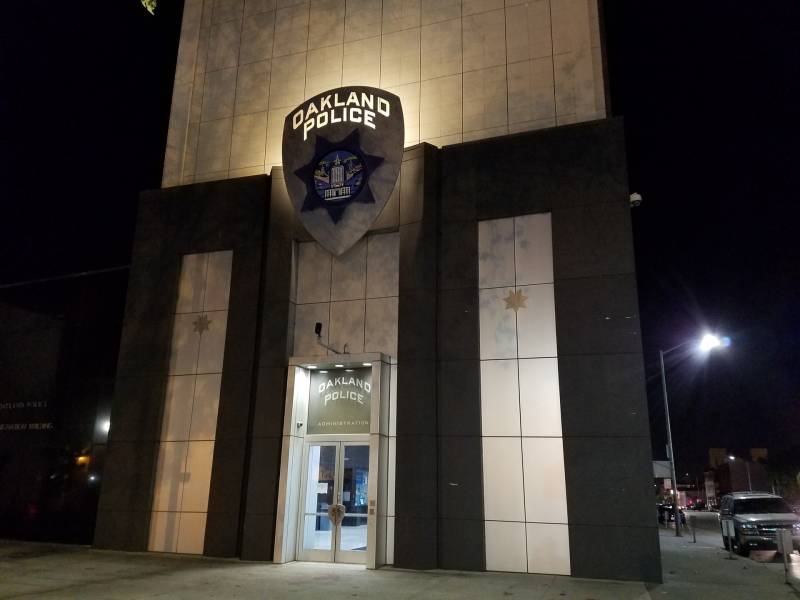
The arraignment of a man accused of punching an Oakland police officer in an unprovoked attack last week was called off after he refused to appear in court on Wednesday for the reading of his charges, according to the Alameda County district attorney’s office.
Lawrence Holley, 48, was arrested Friday afternoon near 104th Avenue and International Boulevard on suspicion of assaulting an Oakland police officer, who was sitting in his patrol vehicle when Holley came up to his window and began repeatedly punching him, prosecutors say. Holley was taken to Santa Rita Jail with bail set at $150,000.
Holley, who was on felony probation at the time of the attack, is charged with felony assault likely to cause great bodily injury, resisting a police officer and causing injury, according to Alameda County District Attorney Ursula Jones Dickson — charges that drew praise from the Oakland police officers union. His arraignment was rescheduled for Thursday.
“If we are asking the police to protect us, then we must also protect them when they are the victim of an unprovoked assault,” Jones Dickson, who campaigned on a promise to improve public safety, said in a statement on Tuesday. “Today, we have filed felony assault charges that reflect the outrageous nature and seriousness of the case.”
Huy Nguyen, president of the Oakland Police Officers Association, said Jones Dickson is showing people that “there is a new district attorney in the county.”
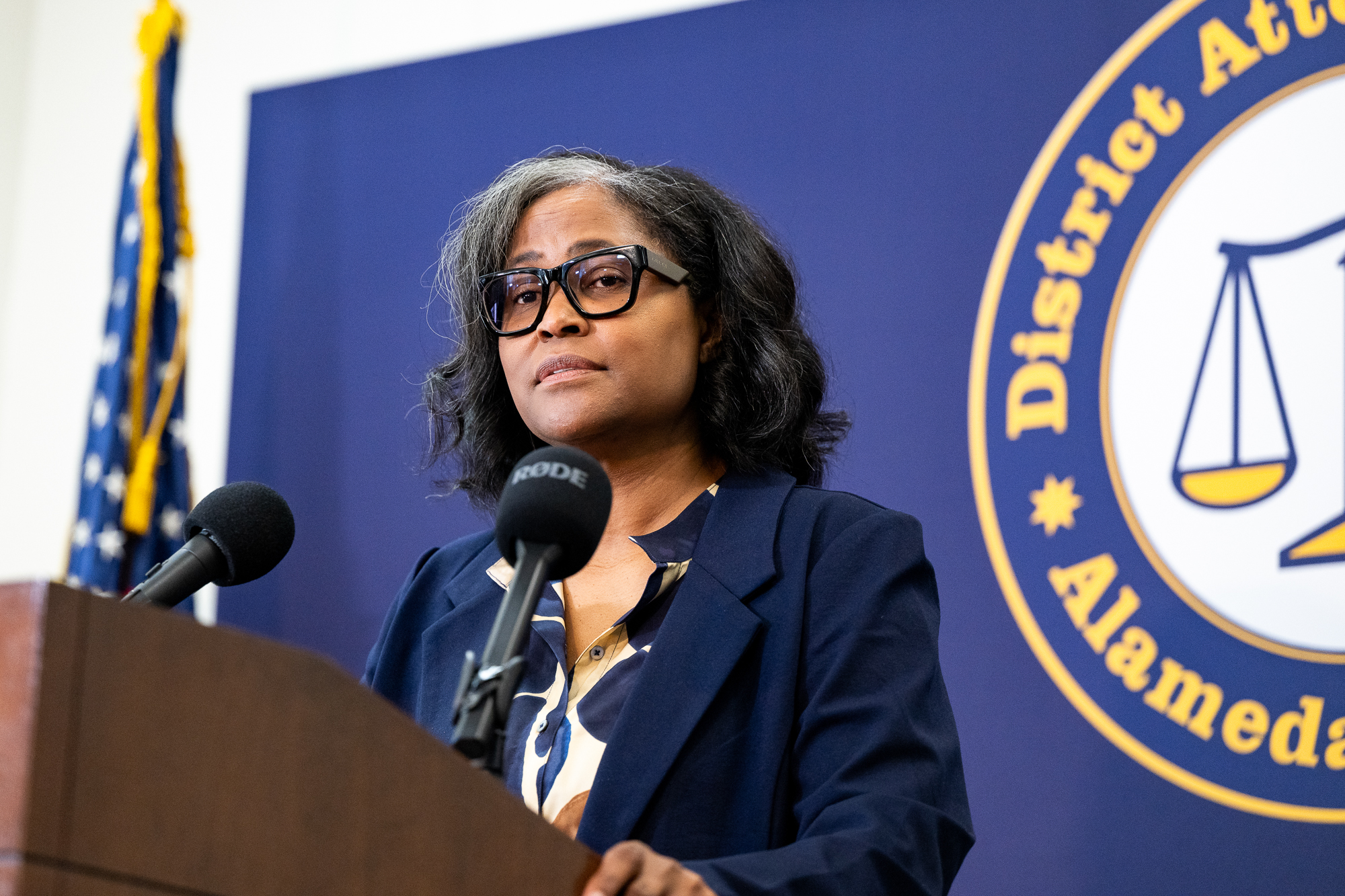
The attack reveals some of the more serious safety concerns facing law enforcement in the city, Nguyen said. The Oakland Police Department is understaffed and lacks sufficient support from city leaders, he noted, adding that the relationship between OPD and Oakland residents is strained because the city is not investing in public safety.
The city of Oakland is facing a $130 million budget deficit, and efforts to mitigate the shortfall have resulted in sweeping cuts to city services, including the Police Department. Last year, the city announced that it would be laying off several non-sworn Police Department employees, curbing overtime spending and closing two police academies for the remainder of the fiscal year.
OPD has contracted from more than 800 officers a few years ago to 675, and because more than 100 officers are out on leave, the number that can actually respond to calls for service is much lower, Nguyen said.
“The Police Department continues to shrink, and it creates a much more challenging work environment for our officers,” he said. “We’re unable to respond to calls from community members. That’s an issue that we need to fix, especially if we want to gain their trust.”
When officers fail to respond to calls or respond too late, the tension between residents and officers only gets worse, Nguyen said, adding that last week’s attack suggests that people are less concerned about being held accountable for their actions.
The situation is dire for both residents and officers who might be targeted amid mounting frustrations, he added.
Oakland’s violent crime rate, which includes homicide, aggravated assault, rape and robbery, was nearly 20% lower last year than the year prior, falling from 7,900 violent crimes to 6,361, according to OPD’s end-of-year crime report.
However, Nguyen said that comparing crime rates to record highs is not an indicator that public safety is improving. The focus instead should be on making Oakland a place where people feel safe and comfortable, and that is not the case, he said.
“Our community members don’t see what our officers are facing, but we also understand the challenges our community members are facing,” Nguyen said. “I understand the frustration when they call, and we don’t respond in a timely manner.”
KQED’s Brian Krans contributed to this report.
San Francisco Ends Health Programs for Drug Users Not Active in Treatment 2 Apr 2:12 PM (yesterday, 2:12 pm)
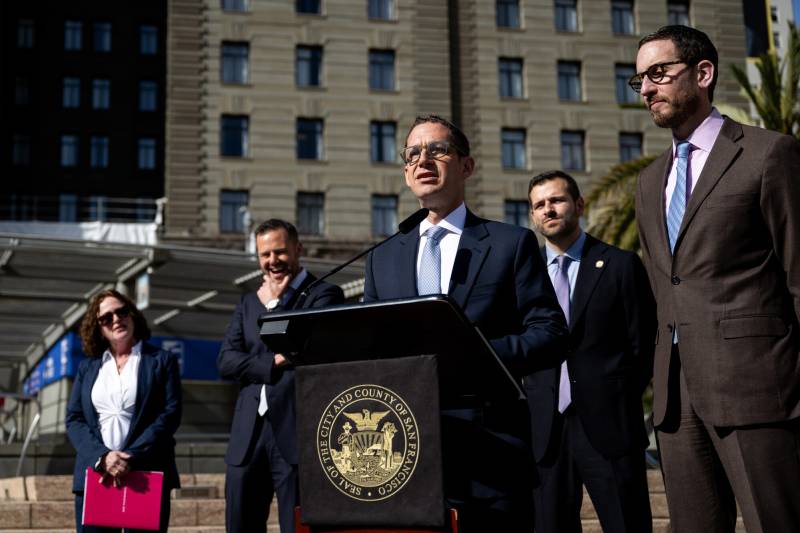
Mayor Daniel Lurie is scaling back a core component of San Francisco’s approach to overdoses and outdoor drug use, putting many health experts on edge.
Public health providers across the city are being told to cease distributing safe smoking supplies in public spaces, according to the mayor’s Wednesday announcement. People must now participate in drug counseling or other services in order to receive any type of safer-use supplies.
The move comes as overdose deaths have increased in San Francisco since October. Mounting pressure from business and community members has challenged the city’s embrace of harm reduction, a public health approach the city helped pioneer during the HIV/AIDS crisis to improve the health and lives of drug users at any stage of use or recovery.
“We can no longer accept the reality of two people dying a day from overdose. The status quo has failed to ensure the health and safety of our entire community, as well as those in the throes of addiction,” Lurie said at a press conference on Wednesday. “Our new policy will connect individuals to treatment quickly, and that is a big step toward reclaiming our public spaces.”
Instead of having outreach workers handing out safer smoking supplies to users on the street, Lurie is ordering all health providers to move that distribution indoors. For those who do make it in person to pick up any safer use supplies, Lurie is now requiring that they also participate in drug treatment, counseling or other services.
The city will maintain its safe needle exchanges and distribution of Narcan, which can reverse an opioid overdose.
Health advocates cried foul over the recent update, saying it goes against research and current trends in San Francisco’s overdose epidemic.
In San Francisco, more people consume fentanyl through smoking rather than injecting. While overdose rates remain at devastating levels, research shows that smoking is less likely to lead to an overdose or soft tissue infections that can come from using needles.
“Safer smoking supplies, for me, are really the best possible solution to prevent someone from injecting their drug of choice,” said Tyler TerMeer, CEO at the San Francisco AIDS Foundation. “My fear — the fear of many harm reductionists in the city — is that if we are to tailor back safer smoking suppliers, that folks will begin injecting their drug again. And injection does then lead to potential rise in HIV infection, rise in hepatitis infection and rise in soft tissue infection.”
A large body of research shows that safe needle exchanges have historically been a powerful tool to prevent overdose and disease while also connecting drug users to health services and treatment.
But in more recent years, the drug supply has shifted towards fentanyl, an opioid about 50 times more potent than heroin.
“As the drug supply changed in our city, as we entered a fentanyl crisis and as folks started smoking fentanyl, we began providing safer smoking supplies,” TerMeer said. “The reason we’ve made such significant progress in this city (cutting down on HIV infections) is because we have leaned into many different approaches.”
The research supporting safe smoking supplies is smaller than the decades of research that exists for needle exchanges. But it is growing and state guidelines have already adopted safe smoking supplies as a pillar of addressing the current drug overdose crisis.
In 2018, California’s health law was amended to expand the scope of harm reduction supplies so that health providers can distribute safer smoking supplies as well.
Lurie stressed the city’s current approach is not working.
“Fentanyl has changed the game, and we’ve been relying on strategies that preceded this new drug epidemic, which ends today,” Lurie said.
Department of Public Health Director Dan Tsai said the city is basing its directive in science and underscored that clean needle exchanges will remain unchanged. When asked at Wednesday’s press conference, he could not identify research showing that requiring counseling in order to obtain safe use supplies could lead to decreased overdoses or increased connections to treatment.
“We are committed to proven, evidence-based health interventions and safer-use supplies are most effective when paired with counseling, healthcare and access to treatment and recovery services to create meaningful change for an individual,” he said.
The Department of Public Health plans to monitor changes in overdose rates, HIV/Hepatitis C transmission “to ensure this policy aligns with overall public health goals,” a press release reads.
The policy goes into effect on April 30.
California Lawmakers Push to Lower Rent Cap, Expand Protections. Property Owners Are Worried 2 Apr 1:44 PM (yesterday, 1:44 pm)

A few months before the 2020 pandemic hit, lawmakers approved sweeping statewide protections against evictions and rent increases. Now, a group of legislators wants that law to go further.
On Wednesday, Assemblymember Ash Kalra, D-San José, announced a new bill, AB 1157, dubbed the “Affordable Rent Act,” that would expand the 2019 Tenant Protection Act to more renters, lower the amount rent can increase each year and make those changes permanent by removing a 2030 sunset date.
“For many, the rent just keeps rising by the maximum allowed by state law,” Kalra said at a press conference unveiling the bill. “Areas that were once considered affordable are no longer affordable to the average working-class tenant. Rent is an issue in every corner of this state.”
The bill is one of a handful of proposed legislation aimed at strengthening tenants’ rights. As renters continue to make up almost half of the state’s population and are more likely than residents of most other states to spend almost a third of their income on housing costs, tenants’ rights groups say the Affordable Rent Act could help protect millions of renters from displacement.
“As a renter in a non-Tenant Protection Act-protected home — a single-family home — I really need this thing to pass,” said Democratic Assemblymember Alex Lee of Milpitas, a co-author of the bill. “We’re in a deficit, and I don’t want to ask for a raise, so I need to pay my rent too.”
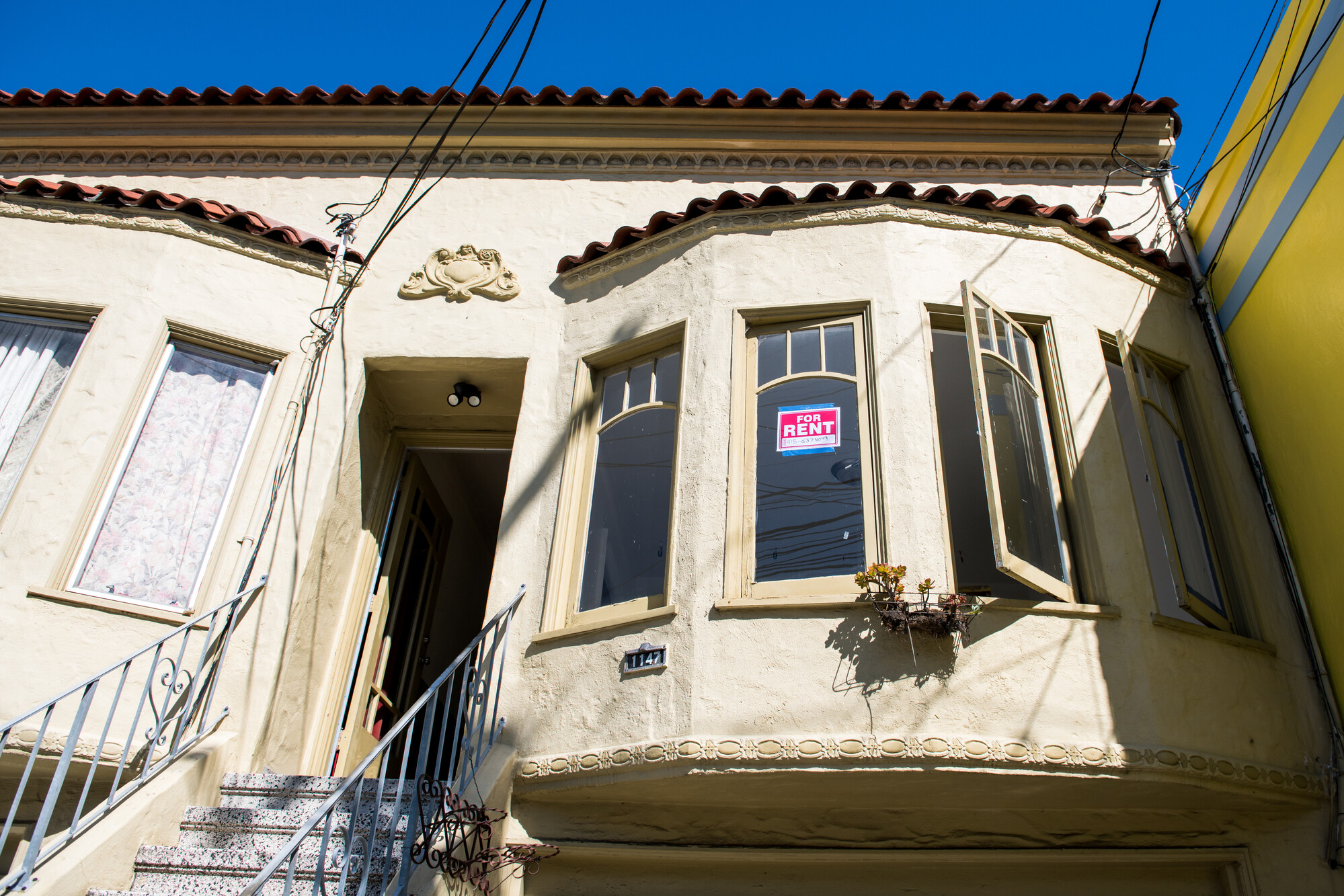
But several real estate and property owner groups are concerned it could make the rental market less attractive for a landlord to enter or stay in and they say it undermines the compromise they struck with tenants’ groups in AB 1482, the Tenant Protection Act.
The California Apartment Association, the California Building Industry Association, California Association of Realtors and other groups sent a letter (PDF) to Kalra on Tuesday voicing their opposition.
“The law struck a careful balance, aiming to prevent rent gouging while protecting California’s efforts to increase housing production,” said Debra Carlton, executive vice president for state and government affairs for the California Apartment Association. “AB 1482 was intended as a temporary, 10-year measure, allowing time for the Legislature to focus on enacting long-term, pro-housing policies.”
AB 1157 builds off the 2019 law by lowering the annual rent increase from a maximum of 10% to a maximum of 5%. In the years since the law has been in effect, inflation has increased and the amount landlords can raise rents has crept closer to 10%.
The 2019 law also requires landlords removing a unit from the rental market to pay relocation assistance to evicted tenants and to have a “just cause” to evict a tenant. While it covers most renters living in multi-family units, it includes exemptions for those living in single-family homes, duplexes and granny flats, among other housing types and living situations.
The new bill would remove most of those exemptions.
“Stable rents keep communities whole — when people can stay, they build roots, sustain lasting connections and contribute to local economies,” said Rae Huang, a senior organizer with tenants’ rights group Housing Now! “Our elected leaders must step up and act now to protect tenants and ensure that all Californians have a place to call home.”
Rent control has been a recurring point of debate across California, as it has repeatedly appeared on local and statewide ballots. Last November, voters shot down Prop 33, which attempted to repeal the Costa-Hawkins Rental Housing Act. The 1995 law limits how local governments can impose rent control laws. In her letter to Kalra, Carlton pointed to multiple studies showing that rent control can discourage landlords from placing units on the market and stymie housing construction.
At the press conference, Karla acknowledged that argument but said immediate action is needed while affordable housing is built.
“I agree that we do need to build more housing, but we also need to focus on how we keep families from being displaced,” Kalra said. “The number one thing we can do to prevent homelessness is not building housing — it’s keeping people in their homes so they don’t become homeless.”
https://docs.google.com/forms/d/e/1FAIpQLSfZ-ZKtuSHdeWqxooQwfEcr-oiOpdpJcf2RLZInU7aqjjQlRQ/viewform?embedded=true
Trump Administration Subpoenas UC Faculty Information in Antisemitism Investigation 2 Apr 12:56 PM (yesterday, 12:56 pm)

Updated 9:15 a.m. Thursday
Hundreds of University of California employees could have their personal information turned over to the federal government as part of the Trump administration’s investigation into allegations of antisemitism on college campuses.
The Equal Employment Opportunity Commission, which enforces workplace anti-discrimination laws, last week subpoenaed the university system for information about some employees as part of the probe, according to a letter from the UC’s general counsel to affected faculty and staff members.
Severin Borenstein, a professor at UC Berkeley’s Haas School of Business, is among those whose information the EEOC is seeking because he signed an open letter to the campus’s administration decrying Hamas’s attack in Israel on Oct. 7, 2023.
“I was certainly unsettled by the fact that the EEOC was asking for my personal email and personal phone number due to my signing a letter that in no way could be interpreted as supporting violence or undermining the federal government,” Borenstein told KQED.
He said he received a message from the UC president’s office last Thursday informing him that the EEOC had subpoenaed his name, position, personal email and phone number, along with other employment information.

The request applies to all signatories of two open letters. The one Borenstein signed, along with more than 360 professors and lecturers in October 2023, calls for support for Jewish staff and students and also wishes safety for students and faculty with Palestinian family and ties in Gaza. The other, signed by about 500 faculty members, was addressed to the UC regents in May 2024 and alleges that campus antisemitism had put Jewish students and faculty in danger after pro-Palestinian protests spread over Israel’s war on Gaza.
“This notice is to inform you that, because your signature appears on one of these letters, your information on file with the University is being produced to the EEOC in response to this subpoena,” read the message from UC general counsel Charles Robinson to those who signed the letters.
It also said that a member of the EEOC staff could reach out to UC employees “regarding [their] own experiences at the university” as part of its investigation.
Borenstein, who is Jewish, said he was initially puzzled by his inclusion in the subpoena because the letters were “not the sort of thing that so far the Trump administration has been targeting.”
“One possibility is they are actually looking for allies within the academic community, and the people who signed this letter might be allies to whatever policies they expect to put into place in punishing the University of California,” he told KQED. “The other possibility was that even expressing any sympathy towards the people of Gaza would potentially bring down the wrath of the Trump administration.”
The UC Office of the President said in a statement that it “remains committed to protecting the privacy of its community members, while complying with its legal obligation in responding to the agency requests.” The EEOC did not respond to requests for comment.
The subpoena follows investigations that the Trump administration has launched into alleged antisemitism at Columbia and Harvard universities, both of which have affected federal funding at the schools.
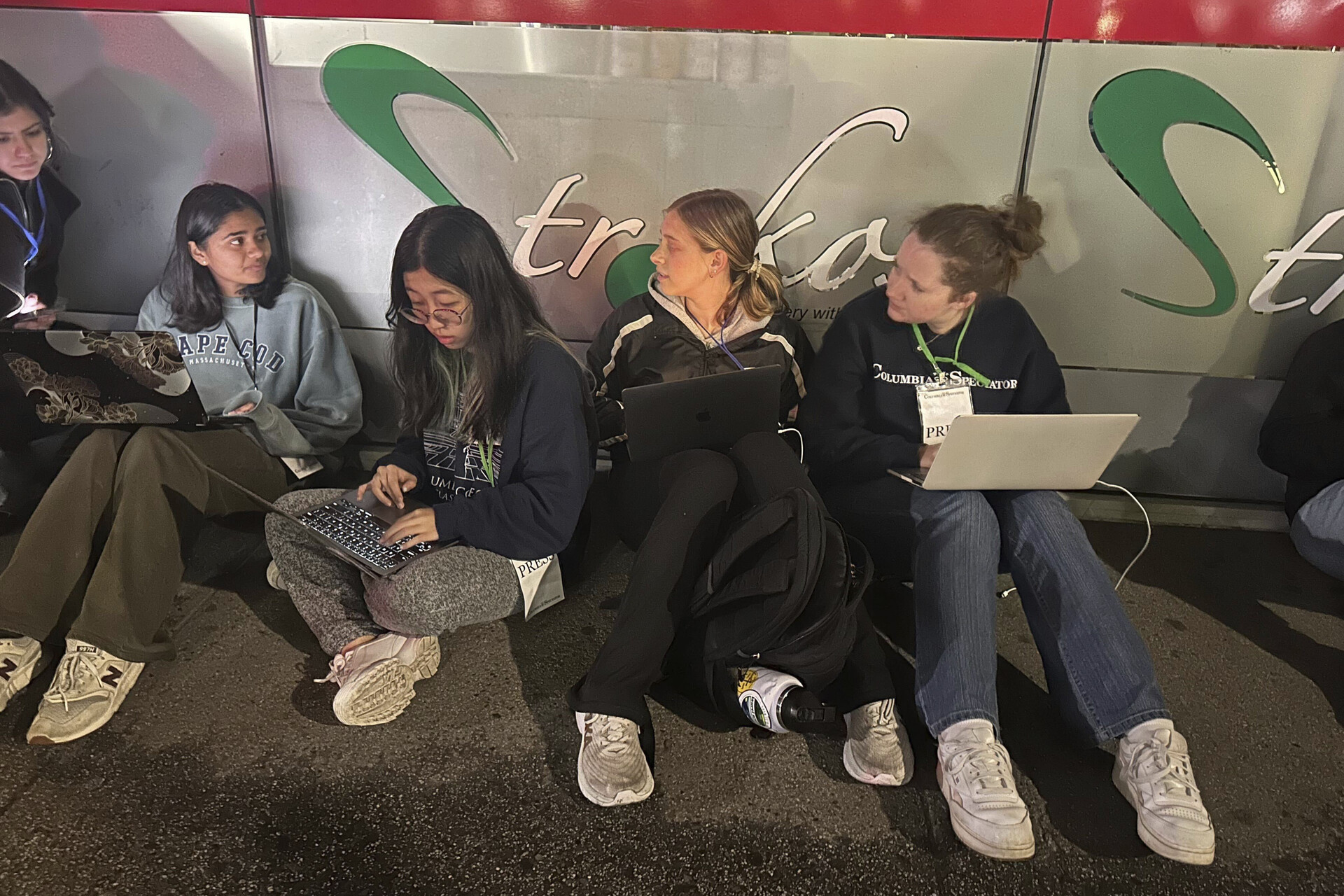
In a letter to its members this week, a UC faculty association said those cases have set a clear precedent “that the Trump administration is using these investigations as pretext to make multimillion dollar cuts to research funding in higher education.”
Even after complying with the administration’s demands, neither Columbia nor Harvard has had its funding restored, UC-AFT Local 1474 President Katie Rodger wrote in the message, which demanded that the UC system protect employees’ privacy and decline to respond to the subpoena.
A federal antisemitism task force this week launched a review of more than $255 million in contracts and grants between Harvard, its partners and the government.
The same task force in March canceled $400 million in research funding from federal sources to Columbia. In response, the university agreed to make changes to its student disciplinary process, put limitations on protests and stepped up oversight of its Middle Eastern studies program, among other changes.
“I think it’s pretty clear that the Trump administration is using antisemitism as a smoke screen to go after academic institutions for what they think is a liberal bias and possibly just to suppress intellectual learning,” Borenstein said. “I believe that the general antagonism towards universities and the cutting off of grants on completely non-political subjects and research that very much benefits people of all political persuasion has nothing to do with antisemitism.”
Borenstein said that although the war in the Middle East has spurred heated and contentious debate on college campuses, “the role of a university is to allow open debate,” even when it’s uncomfortable.
“This has very little, if anything, to do with the Trump administration’s focus on universities,” he said of the investigations. “I think that’s made clear by the broad brush punishment that they are suggesting towards entire universities and organizations that have no political implication whatsoever.”
Trump Launches ‘Liberation Day’ Tariffs, Saying Global Trade Has ‘Plundered’ US Economy 2 Apr 12:36 PM (yesterday, 12:36 pm)

Updated 2 p.m. Wednesday
President Donald Trump declared on Wednesday a 10% baseline tax on imports from all countries and higher tariff rates on dozens of nations that run trade surpluses with the United States, threatening to upend much of the architecture of the global economy and trigger broader trade wars.
Trump held up a chart while speaking at the White House, showing the United States would charge a 34% tax on imports from China, a 20% tax on imports from the European Union, 25% on South Korea, 24% on Japan and 32% on Taiwan.
The president used aggressive rhetoric to describe a global trade system that the United States helped to build after World War II, saying “our country has been looted, pillaged, raped, plundered” by other nations.
Trump declared a national economic emergency to launch the tariffs, expected to produce hundreds of billions in annual revenues. He has promised that factory jobs will return back to the United States as a result of the taxes, but his policies risk a sudden economic slowdown as consumers and businesses could face sharp price hikes on autos, clothes and other goods.
“Taxpayers have been ripped off for more than 50 years,” Trump said in remarks at the White House. “But it is not going to happen anymore.”
Trump was fulfilling a key campaign promise as he imposed what he called “reciprocal” tariffs on trade partners, acting without Congress through the 1977 International Emergency Powers Act in an extraordinary attempt to both break and ultimately reshape America’s trading relationship with the world.
The president’s higher rates would hit foreign entities that sell more goods to the United States than they buy, meaning the tariffs could stay in place for some time as the administration expects other nations to lower their tariffs and other barriers to trade that it says have led to a $1.2 trillion trade imbalance last year.
The tariffs follow similar recent announcements of 25% taxes on auto imports; levies against China, Canada and Mexico; and expanded trade penalties on steel and aluminum. Trump has also imposed tariffs on countries that import oil from Venezuela and he plans separate import taxes on pharmaceutical drugs, lumber, copper and computer chips.
None of the warning signs about a falling stock market or consumer sentiment turning morose have caused the administration to publicly second-guess its strategy, despite the risk of political backlash as voters in last year’s election said they wanted Trump to combat inflation.
Senior administration officials, who insisted on anonymity to preview the new tariffs with reporters ahead of Trump’s speech, said the taxes would raise hundreds of billions of dollars annually in revenues. They said the 10% baseline rate existed to help ensure compliance, while the higher rates were based on the trade deficits run with other nations and then halved to reach the numbers that Trump presented in the Rose Garden.
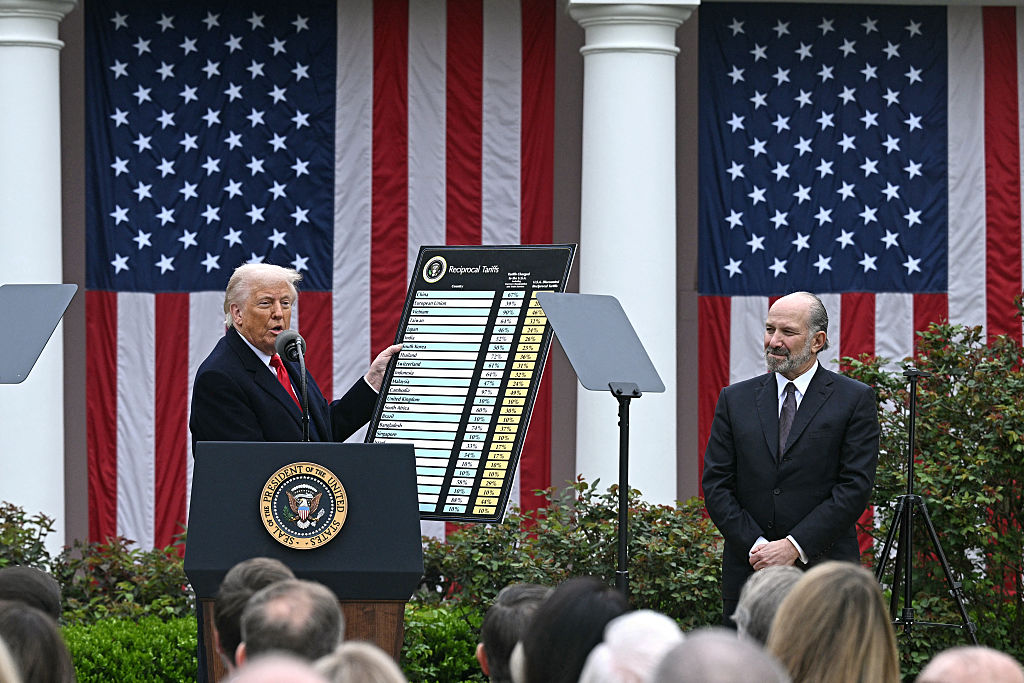
In a follow-up series of questions by The Associated Press, the White House could not say whether the tariff exemptions on imports worth $800 or less would remain in place, possibly shielding some imports from the new taxes.
Based on the possibility of broad tariffs that have been floated by some White House aides, most outside analyses by banks and think tanks see an economy tarnished by higher prices and stagnating growth.
Trump would be applying these tariffs on his own; he has ways of doing so without congressional approval. That makes it easy for Democratic lawmakers and policymakers to criticize the administration if the uncertainty expressed by businesses and declining consumer sentiment are signs of trouble to come.
Heather Boushey, a member of the Biden White House’s Council of Economic Advisers, noted that the less aggressive tariffs Trump imposed during his first term failed to stir the manufacturing renaissance he promised voters.
“We are not seeing indications of the boom that the president promised,” Boushey said. “It’s a failed strategy.”
Rep. Suzan DelBene, D-Wash., said the tariffs are “part of the chaos and dysfunction” being generated across the Trump administration. The chair of the Democratic Congressional Campaign Committee stressed that Trump should not have the sole authority to raise taxes as he intends without getting lawmakers’ approval, saying that Republicans so far have been “blindly loyal.”
“The president shouldn’t be able to do that,” DelBene said. “This is a massive tax increase on American families, and it’s without a vote in Congress … President Trump promised on the campaign trail that he would lower costs on day one. Now he says he doesn’t care if prices go up — he’s broken his promise.”
Even Republicans who trust Trump’s instincts have acknowledged that the tariffs could disrupt an economy with an otherwise healthy 4.1 % unemployment rate.
“We’ll see how it all develops,” said House Speaker Mike Johnson, R-La. “It may be rocky in the beginning. But I think that this will make sense for Americans and help all Americans.”
Longtime trading partners are preparing their own countermeasures. Canada has imposed some in response to the 25% tariffs that Trump tied to the trafficking of fentanyl. The European Union, in response to the steel and aluminum tariffs, put taxes on 26 billion euros’ worth ($28 billion) of U.S. goods, including on bourbon, which prompted Trump to threaten a 200% tariff on European alcohol.
Many allies feel they have been reluctantly drawn into a confrontation by Trump, who routinely says America’s friends and foes have essentially ripped off the United States with a mix of tariffs and other trade barriers.
The flip side is that Americans also have the incomes to choose to buy designer gowns by French fashion houses and autos from German manufacturers, whereas World Bank data show the EU has lower incomes per capita than the U.S.
“Europe has not started this confrontation,” said European Commission President Ursula von der Leyen. “We do not necessarily want to retaliate but, if it is necessary, we have a strong plan to retaliate and we will use it.”
Italy’s premier, Giorgia Meloni, on Wednesday reiterated her call to avoid an EU-US trade war, saying it would harm both sides and would have “heavy” consequences for her country’s economy.
Because Trump had hyped his tariffs without providing specifics until Wednesday, he provided a deeper sense of uncertainty for the world, a sign that the economic slowdown could possibly extend beyond U.S. borders to other nations that would see one person to blame.
Ray Sparnaay, general manager of JE Fixture & Tool, a Canadian tool and die business that sits across the Detroit River, said the uncertainty has crushed his company’s ability to make plans.
“There’s going to be tariffs implemented. We just don’t know at this point,” he said Monday. “That’s one of the biggest problems we’ve had probably the last — well, since November — is the uncertainty. It’s basically slowed all of our quoting processes, business that we hope to secure has been stalled.”
Associated Press writers Mike Householder in Oldcastle, Ontario, Sylvie Corbet in Paris and Lisa Mascaro contributed to this report.
As California AG, Xavier Becerra Sued Trump 120 Times. Now He’s Running for Governor 2 Apr 11:30 AM (yesterday, 11:30 am)
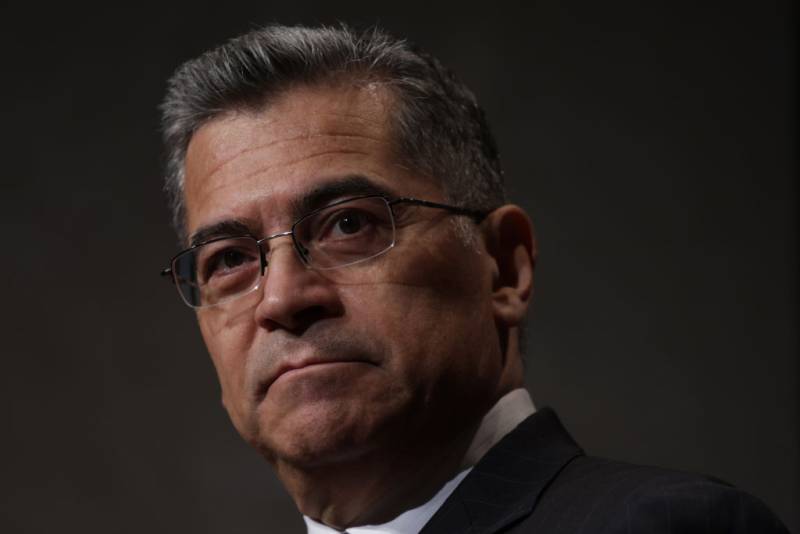
Former U.S. Health and Human Services Secretary Xavier Becerra, who as California attorney general was a constant legal antagonist of Donald Trump during his first term as president, announced on Wednesday that he’s running for governor in 2026 when term limits prevent Gavin Newsom from seeking a third term.
Becerra said he’s jumping in at a time when California is facing threats, including climate change, a housing affordability crisis and constant hostility from the Trump administration.
“This is the place to be. This is the time to do it. It’s a ‘break glass moment’ and I think I bring the experiences to help build us out of this mess,” Becerra told KQED.
As President Joe Biden’s choice to be health secretary, Becerra oversaw an agency with a sprawling array of responsibilities, from protecting food and drug safety to managing the Medicare and Medicaid programs and helping to implement the nation’s response to the COVID-19 pandemic.
On Tuesday, Speaker Emerita Nancy Pelosi’s office confirmed the Trump administration will shut down San Francisco’s HHS office this spring as thousands of layoffs begin amid widespread cuts to the federal health agency.
Mayra Alvarez, president at the Children’s Partnership, a statewide advocacy organization focused on child health equity, has worked with Becerra for nearly 20 years in Washington and Sacramento. She has not endorsed anyone in the race but said that as HHS Secretary Becerra played a critical role in strengthening the nation’s health care.
“Becerra really took ownership of ensuring that laws like the Affordable Care Act and Medicaid were as strong as possible, particularly in the aftermath of the pandemic and coming out of the public health emergency,” Alvarez said.
Becerra, who was California’s top law enforcement official when Biden nominated him, was not an obvious choice to run HHS, which has a fiscal year 2024 budget of $1.7 trillion, accounting for 25% of the nation’s entire federal spending. Although he helped implement the Biden administration’s COVID-19 policies, including vaccine distribution, Becerra was often in the background, especially compared with Dr. Anthony Fauci.
“His biggest challenge is that he did not serve in a particularly high profile way during his time in Biden’s cabinet, so he’d come into this race with a decided name recognition disadvantage,” said Dan Schnur, a USC political communications professor.
That said, Schnur notes Becerra will benefit from his years as California’s AG.
“During his time as attorney general, he got to know a lot of people statewide and a lot of different constituencies so his base might be less demographic and geographic than it is ideological,” Schnur said, adding Becerra’s true strength won’t be known until former Vice President Kamala Harris decides if she’s running.
Becerra said he’s in the race no matter who else jumps in.
“I’ve put my sneakers on the starting block, and I’m in,” he said.
Becerra, 67, is leaning on his resume in hopes of distinguishing himself from a growing field of Democrats.
“What I think I bring to this position as governor that no other candidate can is the executive experience of having been in the heat of this — in the kitchen at the hottest point — and having to deliver results,” he said.
Beccera, who sued the Trump administration 120 times as attorney general, often successfully, enters a crowded Democratic field with Lt. Gov. Eleni Kounalakis, former Rep. Katie Porter, former Los Angeles Mayor Antonio Villaraigosa, former state legislative leader Toni Atkins and state Superintendent of Public Instruction Tony Thurmond. Riverside County Sheriff Chad Bianco, a conservative Republican, has also declared.
Harris, who returned to California when Trump was sworn in, has said she’ll decide whether to run by the end of summer. Becerra isn’t waiting.
“It’s California’s time to rise, and it makes no difference to me how many people are in the race. For me, the competition is — can I get to enough people to explain how my experience and my gut are going to serve as well as governor,” Beccera said.
In an interview with KQED, Becerra said he didn’t necessarily have any “big ideas” to set him apart from the other candidates, saying he’s offering leadership that is prepared, focused and measured.
At a time when many Democrats say they want a fighter who will stand up against Republicans, Becerra acknowledges he’s not the type of politician who gives stem-winder speeches or creates viral moments on social media.
“I am who I am. I’ve had pretty decent success being authentic. That’s not going to change,” he said.
While not mentioning Robert F. Kennedy Jr. by name, Becerra faulted his successor as HHS secretary for not getting on top of the current measles outbreak, blaming it on a lack of preparation.
“What we can’t afford are man-made disasters where you fire people simply because they’re workers for the federal government, or you stop doing cancer research simply because you don’t like the NIH,” Beccera said, referring to the National Institutes of Health. “The reality is, it’s California’s time to rise.
“We must rise to this challenge.”
5 Takeaways From Tuesday’s Elections, Including Bad News for Elon Musk 2 Apr 10:30 AM (yesterday, 10:30 am)

Democrats won a judicial election in Wisconsin that saw a record amount of money spent, national attention and was something of a referendum on Elon Musk, who played a big role, as well as President Trump’s agenda by extension.
They also won a state schools superintendent race there, but Republicans got a win on a voter ID measure. And, in Florida, Republicans won two special elections by double-digits.
So what should be made of all that 19 months from the 2026 midterm elections?
Here are five takeaways:
1. The results show some political headwinds for Trump and Republicans
Susan Crawford, a liberal judge, helped keep the state Supreme Court leaning in Democrats’ direction in a race that saw nearly $70 million in advertising, according to the ad-tracking firm AdImpact, the most ever for a judicial race. That included some $20 million from Musk (more on him below).
It was the marquee race of the elections Tuesday in a state that was decided by 1 point in the 2024 presidential election, and Crawford won it handily, by 10 points with more than 95% of the vote in.
Republicans, on the other hand, won the two special elections in Florida by roughly 14 points each. But these are very red districts. Republican members of Congress, who had represented these seats before being plucked for the Trump administration, won them by more than 30 points in November, so Democrats ate into the margins significantly there as well — though indications were they might do even better. (These are the seats that were held by Mike Waltz, now the national security adviser, and Matt Gaetz, whom Trump wanted to be attorney general before his nomination was pulled over concerns that he lacked sufficient Republican support to be confirmed.)
There were 60 Republican House members who won in 2024 by 15 points or less — and they might be concerned after these results, according to Ballotpedia. The conservative Wall Street Journal editorial board, well read in Trump world, is calling the results a “MAGA backlash.”
It’s important to be careful to not overread the results of off-year elections — and Democrats did win a Wisconsin judicial seat in 2023, but lost the state in the presidential election. But there are early warning signs here for the GOP and a reminder that the energy is often with the out-party, which is why they have historically done so well in presidents’ first midterms. And these elections can be breadcrumbs on the path to success in midterms, especially if a president continues with a bold and divisive agenda.
2. It was a very bad night for Elon Musk — and his days may be numbered as Trump’s right hand
Musk went all in in the Wisconsin judicial race. Groups with the world’s richest man’s backing spent some $20 million. He also made an appearance in the state (wearing a cheese hat), offered $1 million checks to voters and even said “the entire destiny of humanity” could rest on the race.
Talk about raising the stakes.
Trump is likely to do what he does — put a positive spin on the results or say everything is fine and point to the Florida elections (as he did in an ALLCAPS social media post Tuesday night without mentioning the Wisconsin judicial result). But it likely isn’t making him happy, especially considering how much heat Musk and his DOGE group have taken. Musk’s favorability ratings have been a net-negative nationally — and were in Wisconsin too. Musk represented something of a heat shield for Trump on an unpopular way of making sweeping cuts to the government, but, after Tuesday’s results, how long can he remain in the public eye and not start to affect Trump’s political standing?
So far, Trump’s overall approval rating has been marginally higher than during his first term because of strong GOP backing and because of men. But an AP-NORC poll out this week showed Trump’s approval rating falling to 42% (PDF), and his economic approval only at 40%, compared to better marks he received on immigration. That’s especially telling on this day of reciprocal tariffs as his trade war is unpopular.
If Musk does start to lose luster in Trump’s eyes, it could be a result congressional Republicans are quietly happy about. After all, they won their two House seats in Florida, helping shore up their majority, and Wisconsin’s outcome might help move Musk and his blunt, unpopular agenda out of the spotlight.
By the way, Musk may be new to politics, but he violated a key rule of it — never put anything on your head you don’t normally wear, even Trump, who likes a good hat, knows about that one.
3. Signs of how Democrats combat Trump — and what the base wants.
An easy — and somewhat lazy — framing of the internal battle within the Democratic Party is “progressive vs. moderate.” Largely, many in the party agree on the issues, with obvious exceptions on how far to go on certain things or when to push for them or not.
Right now, it is more fighting vs. acquiescence, of standing up vs. complacency.
That was clear with how angry the “do something” Democratic base was when Senate leader Chuck Schumer allowed a GOP-led spending bill to pass last month to keep the government open. It’s also why so many on the left liked Sen. Cory Booker holding the floor of the Senate with an anti-Trump speech. It is now the longest speech ever in the chamber, more than 24 straight hours, breaking the record held by the late Strom Thurmond, a racist South Carolina senator, a fact Booker, who is Black, said he was “very aware” of.
The chairman of the Wisconsin Democratic Party summed up the split among Democrats.
“I don’t think that the most meaningful distinction within Democrats now is left versus center,” state party chair Ben Wikler said in MSNBC’s Morning Joe. “I think it’s actually going on your front foot and fighting back versus rolling over and playing dead.”
He noted that Crawford was against an abortion ban at the court, that Jill Underly, the state schools chief, ran against the dismantling of Department of Education, and that they both were against Musk casting “aside any check and balance.”
“These are broadly held by progressives, by centrists, by everything in between,” Wickler said. “The critical thing is to go out there and fight. It is to make the case to voters; it is to be omnipresent, to communicate, travel everywhere, and I think the Democrats who do that in the big-tent coalition that makes up the Democratic Party, the anti-MAGA coalition, you’re going to see a lot of success from people who have that energy and that conviction. That’s what voters are looking for right now.”
4. The political realignment is helping Democrats in off-year elections
Both parties poured millions of outside dollars into these races, and that’s because off-year and special elections are hard to mobilize voters.
The $70 million spent on ads alone in Wisconsin was the most ever for a judicial race and lots of it came from outside the state.
In Florida, the 6th congressional district election for Waltz’s seat — the one Trump and the GOP were most concerned about — would have been in the top 20 for most spending by a single candidate (PDF) for any House race the entire 2024 cycle, and that was over 20 months. This was two. The Democrat raised about $10 million in that time and spent more than $8 million, while the Republican spent less than $1 million, as of the candidates’ March 12 filings.
Turnout wasn’t bad. It’s always lower in those kinds of races than in presidential elections — and that, of course, was the case in both states. In Wisconsin, roughly 2.4 million ballots were cast (with 95% in), about 30% less than in November. In Florida, fewer than 200,000 voters went to the polls in each congressional district. In 2024, it was more than double that. So money isn’t everything.
But it’s a reminder that firing up the bases is key in off-year and midterm elections —and that the realignment of college-educated voters, who have higher turnout rates, toward Democrats is helping them in these kinds of elections.
5. Voter ID is an issue that continues to heavily lean right
It should be noted that the same voters who voted for a liberal judge in Wisconsin also overwhelmingly approved a measure requiring voter ID.
It’s something that’s already state law; this enshrined it in the state constitution.
A Pew poll last year found 81% in favor of requiring people to show government-issued photo ID to vote. That included 69% of Democrats. Few things get that level of bipartisan support.
So, yes, Democrats can take Tuesday as one of the first bits of good news they’ve had since the 2024 presidential election. But they also have to be aware that there are lots of issues that are still center-right, including voter ID and many measures meant to curb immigration — especially when the party is seeing record lows in favorability.
Apprenticeship Program Aims To Help California’s Struggling Logging Industry 2 Apr 9:01 AM (yesterday, 9:01 am)
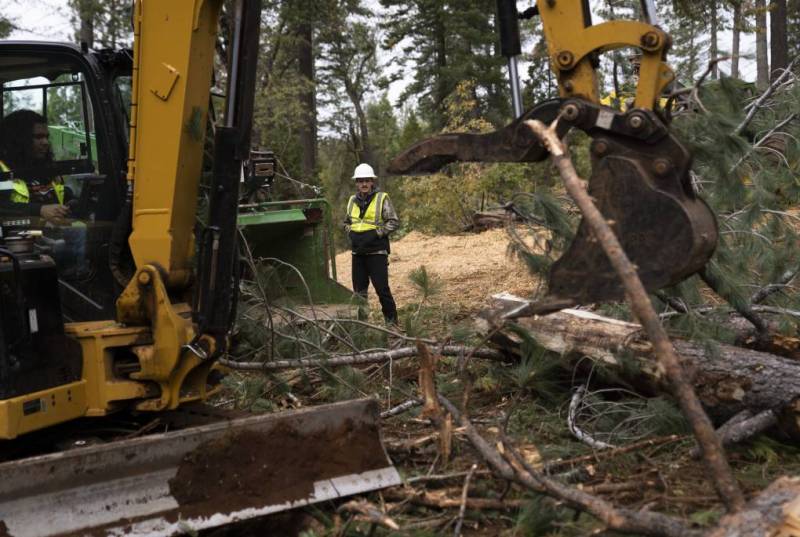
Here are the morning’s top stories on Wednesday, April 2, 2025…
- California’s logging industry has been shrinking for years, with an aging workforce and fewer young people entering the trade. But in Northern California, a community college is stepping in to change that, helping to train the next generation of loggers through an innovative apprenticeship program.
- The California snowpack is close to 100 percent for the third year in a row. That hasn’t happened in three consecutive years since the late 1990s.
- State lawmakers rejected two bills Tuesday aimed at banning transgender children from playing sports in California.
Apprenticeships Are Bringing New Workers To Heritage Industries
On a cold morning in October, the sun shone weakly through tall sugar pines and cedars in Shingletown, a small Northern California outpost whose name is a reminder of its history as a logging camp in the 1800s. Up a gravel road banked with iron-rich red soil, Dylan Knight took a break from stacking logs. Knight is one of 10 student loggers at Shasta College training to operate the heavy equipment required for modern-day logging: processors to remove limbs from logs that have just been cut, skidders to pull logs out of the cutting site, loaders to stack and sort the logs by species and masticators to mulch up debris.
For centuries, logging was a seasonal, learn-on-the-job trade passed down from father to son. But as climate change and innovations in the industry have changed logging into a year-round business, there aren’t always enough workers to fill jobs. “Our workforce was dying,” said Delbert Gannon, owner of Creekside Logging. “You couldn’t even pick from the bottom of the barrel. It was affecting our production and our ability to haul logs. We felt we had to do something.”
Around the country, community colleges are stepping in to run apprenticeship programs for heritage industries, such as logging and aquaculture, which are too small to run. These partnerships help colleges expand the workforce development programs central to their mission. The partnerships also help keep small businesses in small industries alive by managing state and federal grants and providing the equipment, courses and staff to train workers.
Retirements have hit Creekside Logging hard. In 2018 Gannon’s company had jobs to do, and the machines to do them, but nobody to do the work. He reached out to Shasta College, which offers certificates and degrees in forestry and heavy equipment operation, to see if there might be a student who could help. That conversation led to a formal partnership between the college and 19 timber companies to create a pre-apprenticeship course in Heavy Equipment Logging Operations. Soon after, they formed the California Registered Apprenticeship Forest Training program. Shasta College used $3.5 million in grant funds to buy the equipment pre-apprentices use.
Logging instruction takes place on land owned by Sierra Pacific Industries lumber company — which does not employ its own loggers and so relies on companies like Creekside Lumber to fell and transport logs to mills. Each semester, 10 student loggers like Knight take the pre-apprenticeship course at Shasta College. Nearly all are hired upon completion. Once employed, they continue their work as apprentices in the forest training program, which Shasta College runs in partnership with employers like Gannon. State apprenticeship funds help employers offset the cost of training new workers, as well as the lost productivity of on-the-job mentors.
Late Storms Boost Snowpack, Hitting A 3-Year Streak Not Seen In Decades
After a boost from late-season storms, the California snowpack is coming into April at nearly 100% of average for the third year in a row — a streak that hasn’t happened since the end of the 1990s, according to state climatologist Mike Anderson.
Farmers and cities across the state rely on this frozen reservoir for water supplies as the snowpack melts in spring and summer.
Across the northern Sierra Nevada and southern Cascade peaks, the snowpack is at 118% of the historical April 1 average; it’s 91% and 84% in the central and southern Sierra, respectively. Statewide, it sits at 96% of average.
Reservoir levels statewide, meanwhile, are mostly above average. Lake Shasta, the state’s largest reservoir and part of the federal Central Valley Project, is at 113% of its average capacity for April 1. Lake Oroville, the biggest reservoir within the State Water Project, is at 121% of average.
CA Lawmakers Reject Bills To Ban Trans Athletes’ Participation In Girls Sports
California lawmakers won’t change state policies allowing transgender kids and teens to play on sports teams consistent with their gender identities amid heated nationwide debates over the participation of trans youth in athletics.
Democratic lawmakers on the state Assembly’s Committee on Arts, Entertainment, Sports and Tourism rejected two proposals by Republican lawmakers on Tuesday after hours of impassioned debate and commentary.
One bill would have required the California Interscholastic Federation, the governing body for high school sports, to adopt rules banning students whose sex was assigned male at birth from participating on a girls school sports team. The other would have reversed a 2013 law allowing students to participate in sex-segregated school programs, including on sports teams, and use bathrooms and other facilities that align with their gender identity. It would have applied to K-12 and college students.
The hearing came a day after Transgender Day of Visibility, and weeks after Democratic Gov. Gavin Newsom angered his political allies when he suggested on his podcast it’s unfair for transgender athletes to participate in girls sports.
Angel Island Exhibit Aims to Shine Light on Border Surveillance, American Exclusion 2 Apr 6:30 AM (yesterday, 6:30 am)
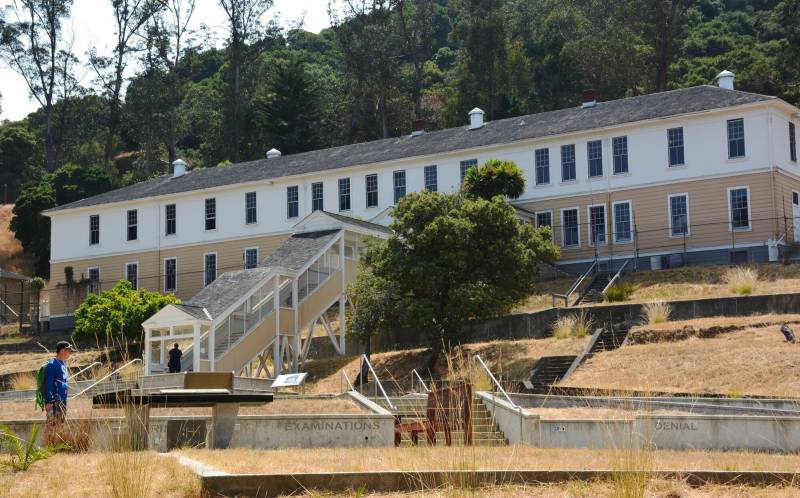
As the Trump administration cracks down on immigration, a new exhibit on Angel Island in the San Francisco Bay draws attention to the “virtual wall” that already looms over the U.S.–Mexico border — and the island’s past as a piece of exclusionary American immigration policy.
In the early 1900s, the Angel Island Immigration Museum was the site of a hospital and processing station for detained asylum seekers, most of them from China or other parts of Asia. Now, posters set out in the airy building display the blimp-like cameras and tall towers that surveil zones on the U.S.’s southern border.
Border communities are keenly aware of the license plate readers that can track their cars and the cameras that can peer into their backyards or at the jungle gyms where their kids play, according to Matthew Guariglia, a senior policy analyst at the Electronic Frontier Foundation, which installed the Angel Island State Park exhibit.
The exhibit, which opens Wednesday, “provides a kind of border surveillance 101” for others who might not be aware of the privacy-impeding technology already creating a barrier between the U.S. and its southern neighbor, Guariglia told KQED. “How much surveillance infrastructure there really is on the U.S.–Mexico border, what technology there is, and how it’s being used.”
For the past few years, the EFF has been conducting research along the southern border, identifying where surveillance equipment is and the ways that it can be disguised — like the seismic trail sensors that track movement and often look like rocks or litter scattered throughout the desert.
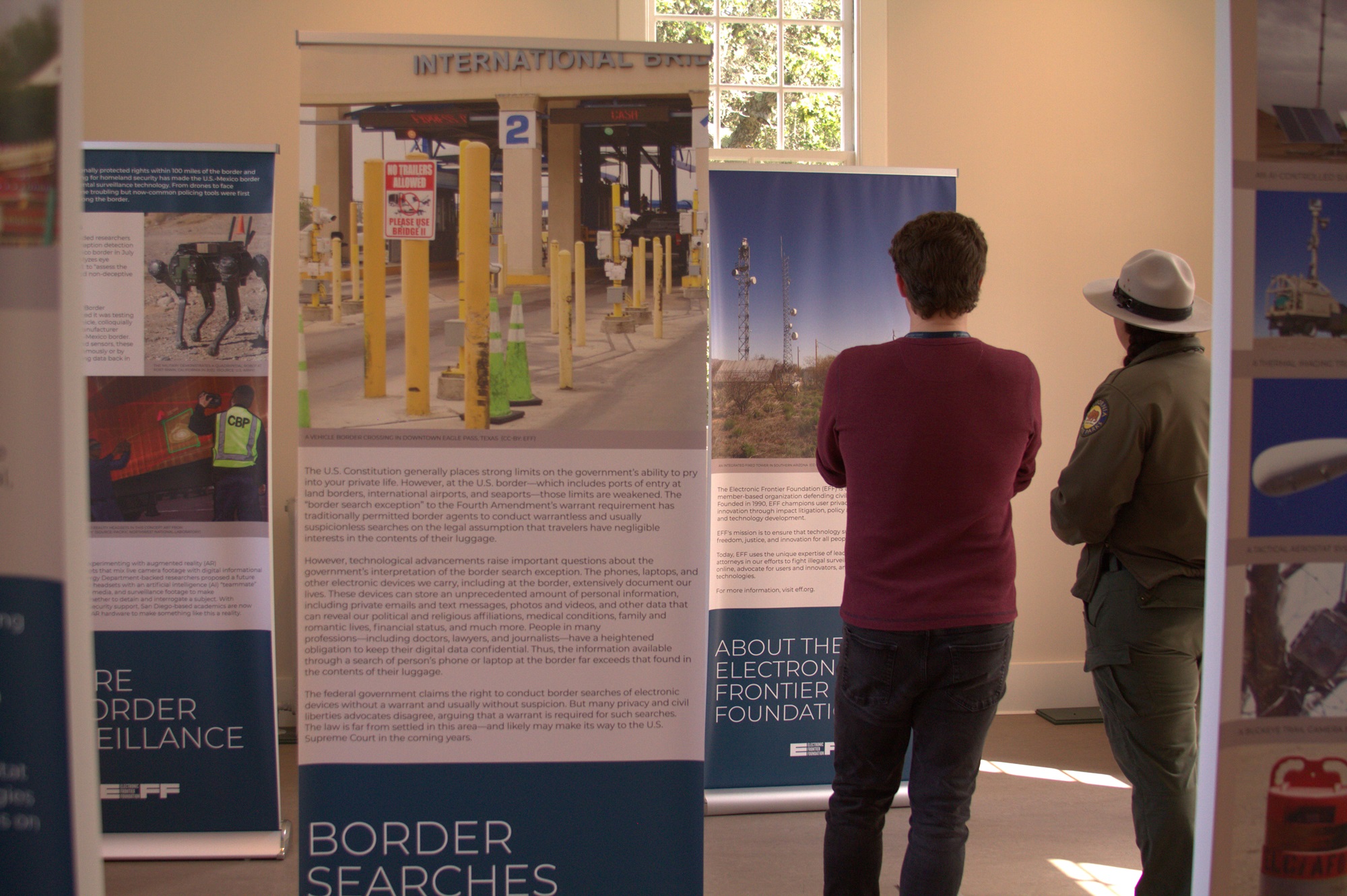
Angel Island felt like the perfect place to debut the work the team has done so far because, according to Guariglia, it is a past “product of Chinese exclusion.”
“Here we had right in our own backyard a kind of encapsulation of how the government throws its power around on some of the most vulnerable people there are, which are immigrants,” he said.
“From the time that Angel Island served as an immigration station from 1910 to 1940, where the majority of the immigrants detained and processed there were of Asian immigrant heritage, there have also been concurrent efforts along the southern border,” said Ed Tepporn, the executive director of the Angel Island Immigration Station Foundation.
Tepporn said that the museum on the island now serves as an educational site for Americans who don’t know as much as they should about the Chinese Exclusion Act — and subsequent expansion of exclusionary efforts to other Asian and Pacific Islander nations.
“They’re not just the things that happened to people from a long time ago, but unfortunately, the same detention, exclusion, racism and xenophobia that immigrants who were held and detained at Angel Island experienced over a hundred years ago in many ways is happening to specific immigrant communities today,” he told KQED.
The exhibit opens as the Trump administration has promised in its first months to carry out mass deportations of illegal immigrants and attempts to narrow legal pathways into the U.S. But the exhibit, and the surveillance it shows, has been in the works for much longer, according to Guariglia.
“Now, this is more important than ever, but really, it kind of doesn’t matter who’s been in office,” he said. “Administrations from both [U.S. political] parties have really kind of increased spending on government surveillance infrastructure at the U.S.–Mexico border over the last 20 years.”

That spans the terms of Democrats Barack Obama, who was infamously labeled the “deporter in chief” by immigrant rights groups, and Joe Biden, whose administration attempted to crack down on the southern border during his — and Kamala Harris’ — campaigns last year.
Guariglia said that since finalizing the exhibit, the EFF has turned to examining legal and policy strategies to combat the “intense” surveillance happening in border towns. In the meantime, he and Tepporn hope more people become cognizant of the U.S.’s presence there.
“Visitors have a chance to reflect on how these histories connect to their own families or their own communities’ experiences and perhaps to imagine together a future that is filled with more welcome and more belonging,” Tepporn told KQED.
After the tenancy at Angel Island, the EFF hopes to display its research across the country, potentially moving to Southern California next.
KQED’s Elize Manoukian contributed to this report.
As Deportation Fears Rise, Alameda County Invests in Immigrant Legal Defense 2 Apr 4:00 AM (2 days ago)
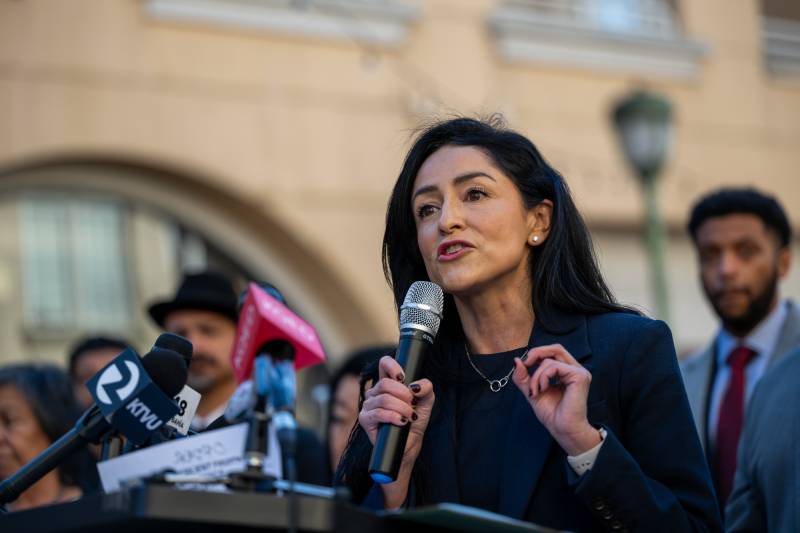
As the Trump administration intensifies attacks on immigrant communities, Alameda County supervisors voted Tuesday to allocate roughly $1.3 million to the Alameda Public Defender’s immigration unit, which provides legal representation to people facing possible detention and deportation.
The one-time emergency funds will help support the immigration unit for two years — $80,000 has been earmarked for fiscal year 2025, while $1,300,000 will be set aside for fiscal year 2026. Most of the money will be used to expand the office through the hiring of additional immigration attorneys and support staff, while the remaining funds will be used to cover litigation costs in criminal and immigration courts.
“There are people who are being stopped, detained, held in custody … and sent back to countries where they might be tortured or executed, and they don’t have access to counsel,” said Brendon Woods, Alameda County’s public defender. “People are being removed from this country when they actually have a legal right to stay here, but they don’t have a lawyer representing them to enforce that right.
“That’s why we’re doing it.”
Alameda County supervisors approved $3.5 million last month to bolster support services and legal aid for the county’s refugee and immigrant communities. Some of the money is being allocated to the immigration unit at the Public Defender’s Office, with the remaining $2.2 million going to East Bay nonprofits. According to Woods, it’s likely the largest amount of funding that the immigration unit has received.
Since the start of President Donald Trump’s second term, widespread anxiety over his anti-immigrant policies has pushed many state and local officials to take action. Bay Area counties have reaffirmed their sanctuary statuses amid reports of immigration enforcement in cities such as San José and San Francisco, as well as Trump’s calls for rapid deportations without due process through the Laken Riley Act and the Aliens Enemy Act.
Recently, Trump called for the removal of Venezuelans who he claimed belonged to Tren de Aragua, a criminal organization designated as a foreign terrorist group by his administration. However, the administration has provided little evidence to back the allegations, and deportations have already occurred despite court orders.
“People are terrified and rightfully so as this administration does not give a damn about the legal process,” Woods said. “I don’t think any of us would’ve thought that would be happening in the United States. People with criminal convictions from over 20 years ago, who are legal permanent residents, are being detained and held right now. This is not due process.”
In 2014, the Public Defender’s Office became the first in the state to create a deportation defense unit. Other public defenders throughout the Bay Area created similar units after Trump was first elected.
The Contra Costa County Office of the Public Defender helped launch the nonprofit Stand Together Contra Costa in 2018 as part of its legal defense initiative for undocumented county residents. Stand Together also manages the county’s rapid response hotline, which residents can use to report immigrant enforcement activity and request legal aid.
In 2017, the San Francisco Public Defender’s Office created an immigration unit after the first Trump administration threatened to facilitate mass deportation of undocumented residents. It was the third public defender’s office to provide immigrants with legal representation during removal proceedings.
According to Woods, it’s likely that demand for services is going to increase. Alameda County Public Defender’s Office is working with local nonprofits and advocacy groups to make sure that resources are accessible, Woods said, adding that the newly allocated funds will allow it to expand its reach.
“I hope we are staffed up and prepared for the coming challenges,” Woods said. “Immigration laws and what we think is normal changes almost daily. It’s almost as if the government or administration is throwing out the playbook.”
He Lived in SF Drug-Free Housing for Years. A Relapse Put Him Back on the Streets 2 Apr 3:00 AM (2 days ago)
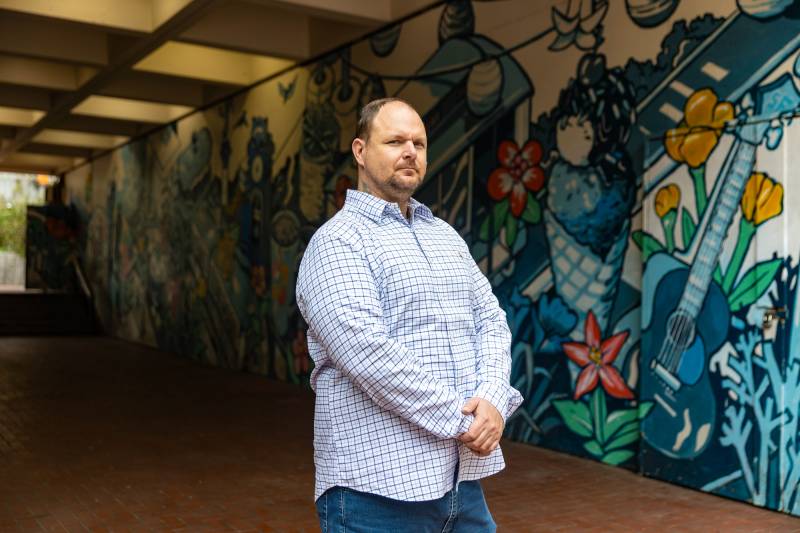
Kull Murray felt like the pieces were finally falling into place.
After more than three years of living sober at Delancey Street Foundation, a residential drug rehabilitation program in San Francisco, he had lined up a job and reconnected with family. His future dimmed on a trip home one night in early March.
Just one drink would be fine, he thought.
“I ended up drinking at least a 12 pack. And then, the next thing I know, I’m at a park with people I’m familiar with and I’m smoking meth,” Murray, a Central Valley native, said. “It happened so quickly.”
The slip cost Murray his bed at Delancey Street, where drug use is prohibited.
“When I came back the next morning, they called me in to drug test me. I definitely failed, so I just walked out ‘cause I knew what they were gonna do,” Murray, 41, said. “I was about to graduate. And I’ve been trying to rack my brain, why I made this decision. It was a very unfortunate one. Now I’m stuck on the streets in San Francisco.”
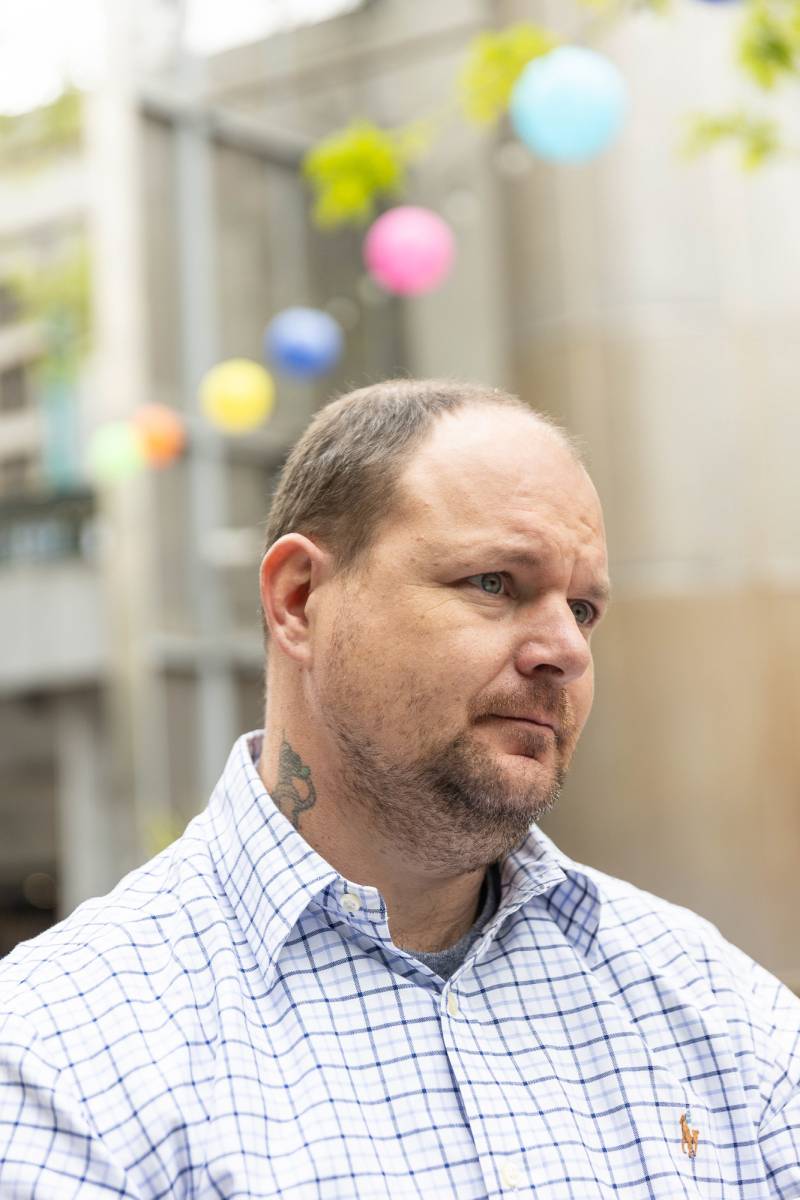
Murray’s experience comes as San Francisco supervisors push for more low-income housing options that require sobriety in response to the city’s drug crisis.
Advocates say it’s a much-needed component of the city’s public housing inventory for people in recovery or low-income residents seeking a drug-free environment.
“I’ve been running transitional housing right down the street for the last 10 years. When they discharge, I gotta look and scramble for them to go to a place that’s safe,” Richard Beal, director of recovery services at Tenderloin Housing Clinic, said at a recent town hall about the city’s response to drug use and homelessness in the Tenderloin neighborhood. “We need drug-free housing. We need to complete the bridge.”
Supervisor Matt Dorsey, who oversees the South of Market neighborhood, is leading the charge.
“Virtually 100%, or close to it, of permanent supportive housing right now has a drug-tolerant policy that people can’t be evicted for the use of illicit drugs,” Dorsey told KQED. “There are people that I hear from who are in recovery and in permanent supportive housing who are asking for drug-free options.”
Unhoused for the first time, Murray slept outside the first two nights. On the third day of homelessness, he visited a triage center on Sixth Street, where he heard he might find help.
“I’m hoping that this place will get me a bed in a shelter, if that’s what happens here. I don’t even really know. I just know they have food, and I haven’t eaten in a couple days; that definitely drew me in,” Murray said, sitting on the facility’s picnic bench one recent morning. “I just don’t want to sleep outside.”
A social worker found a shelter bed for Murray, where he’s since been sleeping as he applies to jobs and navigates the city’s web of social services. He said he hasn’t used drugs since the relapse, but every day is difficult trying to maintain sobriety while facing the harsh realities of homelessness.
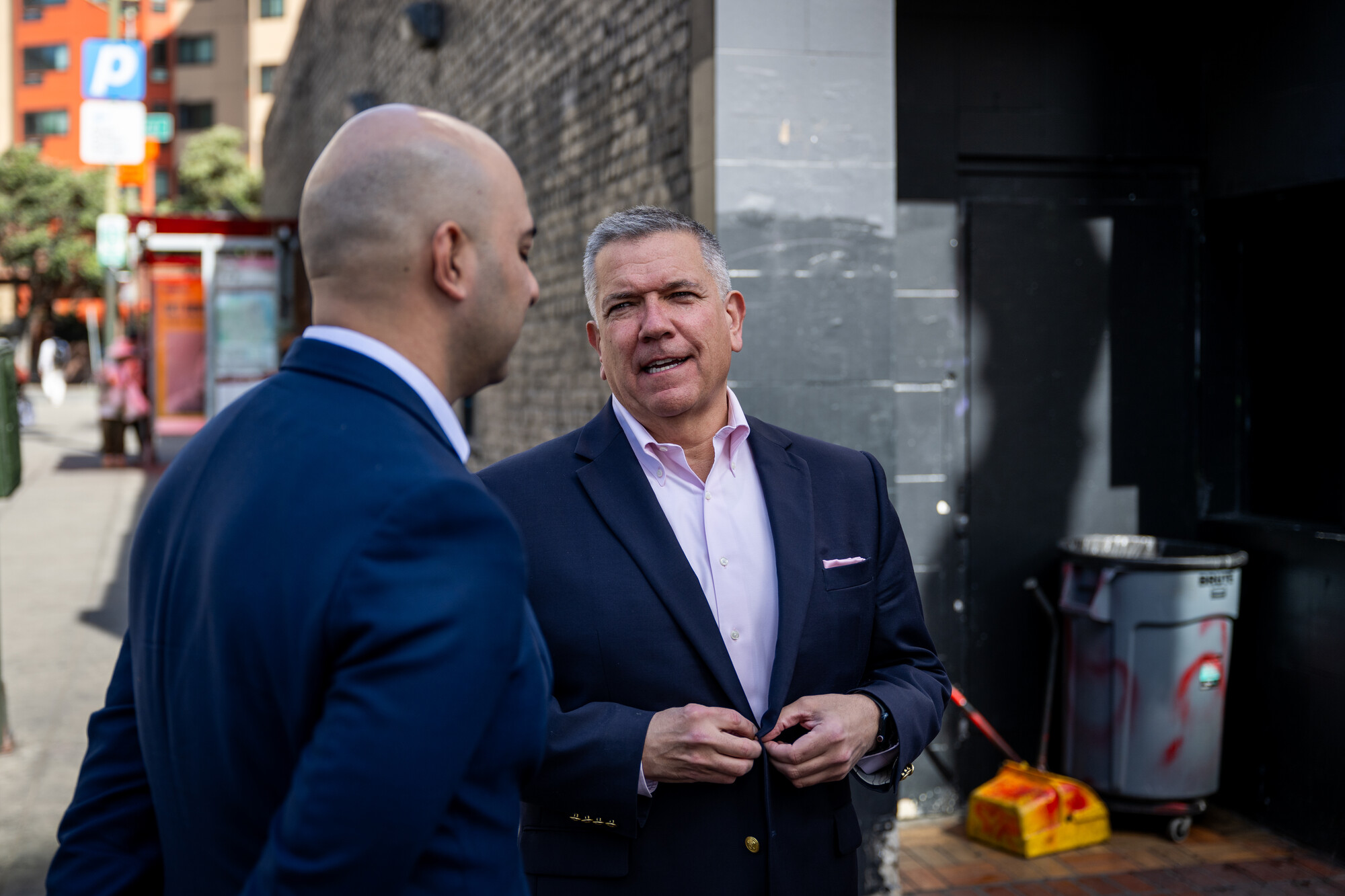
“What’s creeping into my head and giving me anxiety now is having a uniform or the clothing that I’ll need for a job and the ability to maintain my hygiene,” Murray said on a phone call a few days into his shelter stay. “I’ve taken showers here, but I’m literally putting on the same clothes that I have.
“It starts wearing on you, like, the hopelessness.”
In 2004, under President George W. Bush, the federal government adopted a “housing first” model requiring permanent supportive housing providers to accept residents regardless of drug use, credit history or criminal background. The idea is backed by studies showing that having a place to live increases a person’s likelihood of stabilizing their health and income.
Recognizing that some people in recovery prefer abstinence housing, in 2022, the Department of Housing and Urban Development modified its policy to include drug-free programs.
California adopted its housing-first policy in 2016, and state law still prohibits tax dollars from funding drug-free housing. That could soon change. Assemblymember Matt Haney, who represents San Francisco, has proposed legislation to allow state housing-first dollars to go towards residential programs where up to 25% of units are drug-free.
If passed, it would also “prohibit eviction on the basis of relapse,” according to the bill’s text. “If a tenant is no longer interested in living in a supportive-recovery residence or is at risk of eviction,” then they should receive “assistance in accessing housing operated with harm-reduction principles that is also permanent housing.”
Directives from the Trump administration are already filtering down to the local level. HUD officials said they “will not enforce” grant agreements with the City of San Francisco “to the extent that they require the project to use a housing first program model,” according to a memo obtained by Kaiser Health News.
Efforts to expand drug-free housing in San Francisco have percolated for years, and a shift toward the center among the city’s political leadership has accelerated efforts. The city is on track to open its first drug-free housing facility at the Civic Center Motor Inn this summer.
The state and federal changes could boost momentum around legislation that Dorsey plans to reintroduce to grow the city’s abstinence housing stock. His plan would restrict funding for subsidized housing for homeless adults unless a portion of the units are drug-free.
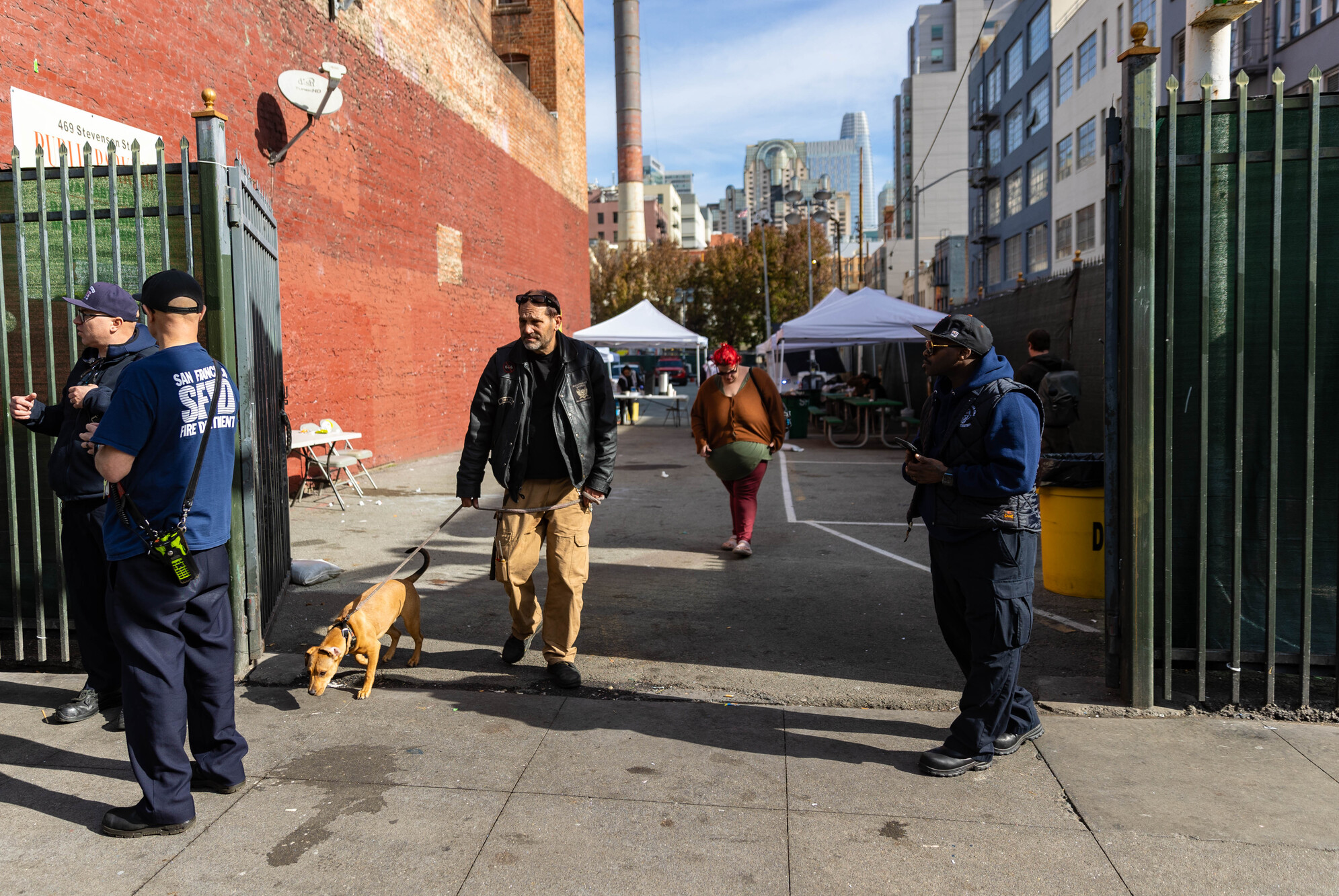
Dorsey, who identifies as a recovering drug addict, said that a relapse in drug-free housing would not immediately trigger an eviction. Ideally, a person who relapses would be referred to other treatment options in a different setting to keep them connected to care and protect other residents hoping to avoid drug use, he said.
“If someone were to have a return to use, the policy would actually require that we place people into a more appropriate level of care,” as opposed to being placed on the street, Dorsey said.
He acknowledged that the city lacks adequate alternatives, and situations like Murray’s aren’t uncommon. “We have to make sure we have treatment on demand and expand our recovery options,” Dorsey said.
Addiction experts who agree that drug-free housing can support recovery goals have raised concerns over the heightened emphasis on abstinence. Relapse is a regular experience for many substance use disorders.
“People who are working towards abstinence have a right to be in a space where there’s no drug use. But we are first obligated to see how we can work with them, if we can figure out what support they need,” said Vitka Eisen, who leads one of the city’s largest drug treatment providers, HealthRIGHT360. “Returning to old ways that didn’t work is not the answer.”
If someone has a relapse in HealthRIGHT360’s residential drug treatment programs, Eisen said they are typically evaluated for alternative care, including withdrawal management, medication-assisted treatment, counseling or other services.
An abstinence-based transitional housing program at the Drake Hotel takes similar approaches to relapses, using discharge as a last resort only if someone has been violent or shown other disruptive behavior, according to Beal of the Tenderloin Housing Clinic.
“The goal is to keep people connected to care. That’s the most important thing, to the degree to which we can turn a single slip from a deepening crisis for the individual,” Eisen said. “The worst outcome is when people are disconnected.”
Living away from drug use helped Murray stick to his sobriety. He’s desperate to find a place to live, but he isn’t looking to move back to Delancy Street, which has residents commit to a two-year stay.
“It’s not even really an option,” Murray said. “I’m 41 years old. I have kids that I’m desperately trying to get to, and I’ve been there already for three years. I just can’t justify in my head being away from them for another two years.”
He’s now hoping for a subsidized housing unit.
“I made a mistake, there’s no denying that. But to have three years of sobriety and getting under my feet then to just be cast out like garbage, it’s pretty tough,” Murray said.
Between job applications, Murray mostly keeps busy watching YouTube videos about astronomy, history and cute animals. “I spend a lot of time trying to watch positive stuff like educational videos because if I just sit alone and I’m not occupying my mind, it’s pretty depressing,” he said.
At the shelter, he said he sees many people with mental illnesses and substance use disorders who need supportive housing.
“I’m in the same situation they are in, but my situation is not hopeless. I can figure this out and get my shit together,” Murray said. “Some of these other folks, it’s not their fault and they’re really, really struggling.”
Guantanamo ICE Detention Costs $40 Million in 1st Month, Padilla Calls Spending ‘Exorbitant’ 2 Apr 3:00 AM (2 days ago)
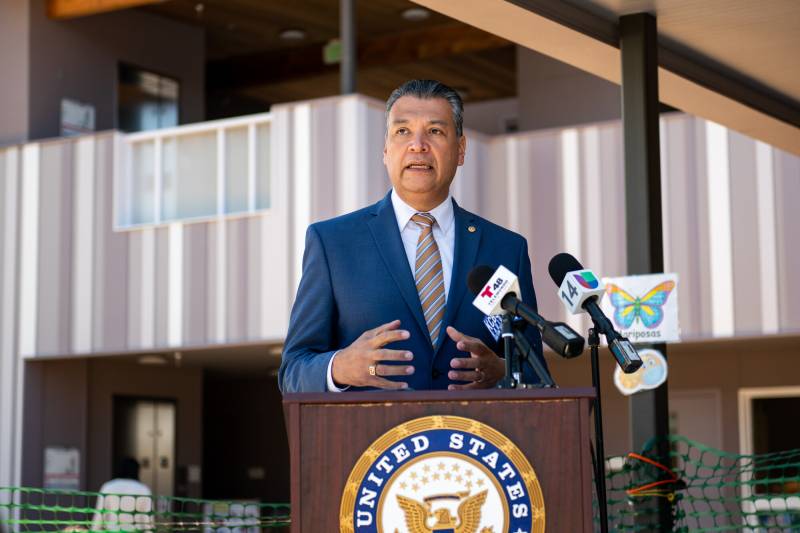
The Trump administration’s move to detain people for Immigration and Customs Enforcement at the U.S. naval base in Guantanamo Bay, Cuba, has cost taxpayers $40 million in its first month, according to U.S. Sen. Alex Padilla, D-Calif., who called the price tag “exorbitant.”
Padilla said the administration only disclosed the cost information after he and several other senators traveled to Guantanamo last Friday. As the ranking Democrat on the Senate Judiciary Subcommittee on Border Security and Immigration, Padilla joined top-ranking members of the Armed Services, Foreign Relations and Homeland Security committees on the oversight trip.
On the day of the senators’ visit, 87 people were detained at the facility, according to Padilla’s office. The Department of Homeland Security estimates that each detention bed at standard ICE facilities costs about $165 per day. At that rate, holding 87 people for a month in the U.S. would total about $430,000 — a fraction of the $40 million spent at Guantanamo.
“It’s a huge waste of taxpayer dollars,” Padilla said of the Guantanamo operation. “It was done without any significant planning or preparation, simply to give Donald Trump the talking point or the soundbite that he wants. It’s irresponsible, it’s reckless and it undermines due process.”
Homeland Security and U.S. Immigration and Customs Enforcement officials did not respond to KQED’s request for comment.
Sen. John Cornyn, the chair of the Senate Judiciary’s immigration subcommittee, also did not respond to a request for comment on the senators’ trip to Guantanamo.
A significant portion of the cost stems from the use of military personnel for detention operations rather than ICE officials or their contractors. Padilla said that if Trump and his senior adviser Elon Musk are serious about rooting out waste and abuse in government spending, this is a “prime candidate for their attention.”
He added that many of the service members there were redeployed on very short notice, taking them away from other “critical missions.”
Before the trip, Padilla and other Democratic senators wrote in a letter to Trump (PDF) that immigrant detention on foreign soil is “unprecedented, unlawful, and harmful to American national security, values, and interests.”
During the visit, Padilla discovered that nearly half of the 87 people in detention were held in a low-security facility, undermining the administration’s claim that only the “worst of the worst” violent criminals were being sent to Guantanamo.
“Every question we asked led to more and more questions. It became clearer and clearer throughout the day that this was very much a ‘ready, fire, aim’ sequence of events,” Padilla told KQED. “They’ve been doing this for more than a month-and-a-half now, and there’s still some very basic infrastructure that hasn’t been put in place … whether it’s housing, whether it’s affording migrants access to counsel or basic communications.”
Immigrant rights and civil liberties groups have filed at least two lawsuits against the Trump administration, calling the transfers to Guantanamo illegal and unconstitutional (PDF) and charging that detainees have been held incommunicado (PDF) without the ability to contact their lawyers or family members.
One ‘Remedy to Fear’ for Trans Folks? Self-Defense Classes 2 Apr 2:00 AM (2 days ago)
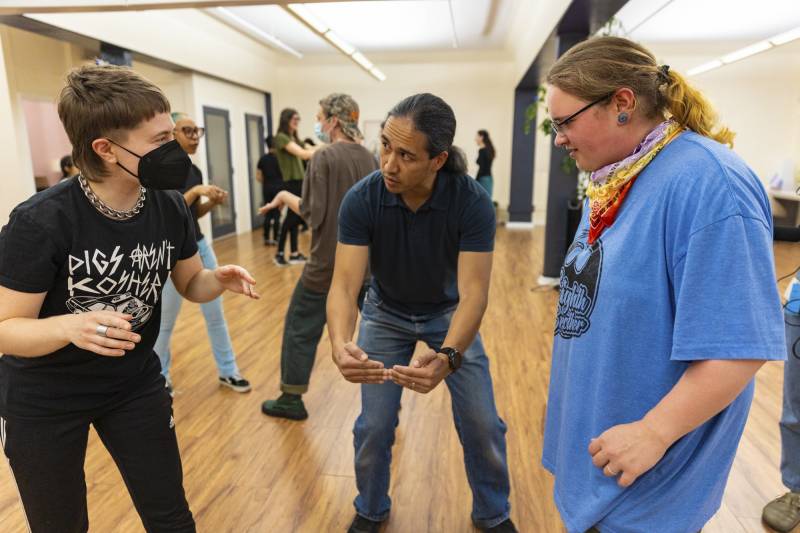
President Donald Trump’s executive orders and rhetoric have created a climate of fear in queer and transgender communities, including here in the Bay Area. KQED’s Bianca Taylor reports on a self-defense class in San Francisco’s Transgender District that teaches people skills to protect themselves while also building community.
Links:
- Amid Rising Threats, Transgender Community Builds Bonds at This SF Self-Defense Class
- Where LGBTQ+ people can find self-defense classes in the Bay Area
This is a computer-generated transcript. While it has been reviewed by our team, there may be some errors.
Ericka Cruz Guevarra [00:02:51] Well, I wonder if you can start by just telling me about this self-defense class that you went to. Where was it and I guess what were the vibes?
Bianca Taylor [00:02:59] I reported on a self-defense training class that was specifically for gender, queer, gender expansive and trans folks.
Organizer [00:03:06] We have pizza available in the pink room, there’s a vegan option
Ericka Cruz Guevarra [00:03:10] Bianca Taylor is host and producer of KQED’s The Latest Podcast.
Bianca Taylor [00:03:16] and it was held at the Transgender District, which is both a geographical space sort of in the Tenderloin in San Francisco as well as a non-profit organization founded by and for trans women of color.
Bianca Taylor [00:03:34] The space itself was really beautiful. It was like a big open office space. They basically turned the transgender district into the dojo for the evening. There were about 12 people who came and one instructor, Joseph Bautista.
Joseph Bautista [00:03:49] We’re gonna get into some things today. We’re going to go over verbal de-escalation, situational awareness, and of course the physical.
Bianca Taylor [00:03:56] It was really lively, you know, they did partnered exercises.
Joseph Bautista [00:04:02] Everyone that is facing the windows you are the designated attacker for this round okay all I want you to do right now is slowly with your right hand try to touch the other person’s head
Bianca Taylor [00:04:15] Everything from learning how to like push and punch someone away to like what to do if you’re being choked or like how to stab someone with a ballpoint pen. And then there was also a lot of emphasis put on how to just be aware of your surroundings, how to make sure you’re not an easy target, and then how to verbally de-escalate a situation.
Bianca Taylor [00:04:38] You know, those are really serious, scary scenarios, but the room was buzzing.
Joseph Bautista [00:04:43] Now push the shoulders. Boom, see, it’s safer, right? You’re getting away from this, I know right, no, yeah, yeah.
Participant 1 [00:04:50] I’ll attack you now. Okay, okay.
Participant 2 [00:04:52] That sounds crazy. Yeah.
Bianca Taylor [00:04:54] People came with friends, but people also came solo and through the experience, you know, switched partners so folks were meeting new people. There was an air of excitement.
Joseph Bautista [00:05:05] And time! This is it! This is it! Say thank you to your partner and do-si-do and find a new one!
Ericka Cruz Guevarra [00:05:14] I know you actually spoke to some people who were participating in the self-defense class. Who did you meet and what did they tell you about why they were taking the class?
Bianca Taylor [00:05:24] One of the folks I met was Alexis Jimenez.
Alexis Jimenez [00:05:27] I’m really interested in learning the techniques to like push away from like people grabbing certain parts of my body, whether it’s like… your neck.
Bianca Taylor [00:05:39] She had a little bit of background in Taekwondo, but she was mostly there because she had had some scary experiences before.
Alexis Jimenez [00:05:49] Though I have had stalkers and reported to police about this before,
Bianca Taylor [00:05:55] And in that moment sort of realized if something came to pass she wasn’t sure she knew what to do to protect herself and so she came to the class to learn additional techniques to kind of build on what she had learned a while ago.
Alexis Jimenez [00:06:12] Thought about scenarios of what could have happened and whether or not I’m prepared to defend myself in those situations. So it’s good that the stars have aligned for me to now kind of get some exposure and learning around this. That’s kind of what motivates me.
Ericka Cruz Guevarra [00:06:32] I mean, it’s, I think, very clear that trans people are under attack right now between President Donald Trump’s several executive orders, anti-trans executive orders and anti-Trans legislation introduced in state houses around the country. How do the people behind the self-defense class talk about why this is so important to do right now, like to hold a self-defense class like this?
Bianca Taylor [00:07:02] Yeah, I think there’s a couple of reasons, you know, there are legal challenges to those executive orders that you spoke about, but the reality for people living, even in a sanctuary city like San Francisco, a trans sanctuary city, people still feel afraid.
Carolina Osoria [00:07:21] The goal of this and other classes is to have people feel empowered.
Bianca Taylor [00:07:26] The training was put on by Carolina Osoria, she’s the program associate, and she told me that this class was really a response to what their community had been feeling after the 2024 election of Donald Trump. She said that community members were feeling very vulnerable.
Carolina Osoria [00:07:46] I feel like this it just feels a little bit worse. The landscape that he’s creating, this landscape is very much rooted in violence.
Bianca Taylor [00:07:56] Carolina said that she wanted the community to feel physically empowered at a time when there were a lot of threats towards trans people.
Carolina Osoria [00:08:05] And through that, if we’re able to help Black trans women, Black trans men, Black trans non-binary folks feel empowered and by giving them the adequate skills that they would need to do so, we’ll be helping all folks.
Bianca Taylor [00:08:23] There was a 2021 study that was done in San Francisco and the Bay Area, and it showed that trans women of color disproportionately bear the brunt of the violent crime committed against trans people. More than half of the physically violent crimes in this report were reported by trans women of color, or specifically Black and Latina trans women. So the reason that that is important in the context of this training is that the training happened in the Tenderloin. and the largest population of trans folk in the Tenderloin are trans women of color.
Ericka Cruz Guevarra [00:08:56] I mean, it is really striking, Bianca, that we’re talking about the fears of trans people right now, and also just, I guess, holding that up against the mood that you paint of the class as this really buzzing and exciting place. I mean it’s super serious stuff, but it seems like people are getting more out of the class than just self-defense. I wonder if you can tell me about the community that’s also being built.
Bianca Taylor [00:09:24] Yeah, I mean, Carolina really stressed that, like, a remedy to fear is being in power with other people, and I think that was very obviously felt.
Moss O’Neal [00:09:33] I’m not really sure what to expect because I haven’t done this before, but I’m excited.
Bianca Taylor [00:09:37] One of the folks I spoke with, his name was Moss O’Neal.
Bianca Taylor [00:09:41] Have you ever done a self-defense training?
Moss O’Neal [00:09:43] I have not, no.
Bianca Taylor [00:09:45] Have you felt like you wished you had?
Moss O’Neal [00:09:47] Yes, yeah, several times, and I think this will be good for me.
Bianca Taylor [00:09:51] He has had moments where he wished he had known how to defend himself, sort of walking around San Francisco. And he also specifically said he came to meet more queer people, to find queer community. After the training was over, there was pizza and drinks and folks stuck around and exchanged phone numbers. And I think that, especially in a time where it can feel scary to wear the clothes you wanna wear, walk down the street, be the person that you know you are. Being in a room with people who are going through the same thing and doing something joyful is very powerful. And I think that in addition to sort of like the physical techniques that folks used and how people learned how to use their voice, you can’t deny that there’s also power just knowing that you’re not alone.
Ericka Cruz Guevarra [00:10:39] Yeah, it seems like trans people and folks from the queer community who attended this training are really looking to feel empowered right now, not afraid.
Bianca Taylor [00:10:48] Yeah, I mean, the word that kept coming up was resilient.
Bianca Taylor [00:10:55] This is not the first time the gender expansive and trans community has been in the crossfire or scapegoated for societal ills, and it probably won’t be the last time. I think the really incredible thing about a place like the Transgender District and this training is that it is so rooted in a history of resistance and resilience in San Francisco and in the Bay Area. And I want to stress that San Francisco is not, it’s not necessarily a safe haven still. There are still real reasons that folks feel afraid. It’s telling and demonstrative of just the era that we’re in that even in a place like San Francisco there’s work to do.
Ericka Cruz Guevarra [00:11:36] Well, Bianca, thank you so much for sharing your reporting with us. I appreciate it.
Bianca Taylor [00:11:40] Thanks, Ericka.
Ericka Cruz Guevarra [00:11:45] That was Bianca Taylor, host and producer of The Latest, which you can find wherever you listen to The Bay. By the way, if you or someone you know is interested in self-defense classes like this one, there are some links in our episode notes for how LGBTQ+ people can find self-defense classes in The Bay Area. This 20-minute conversation with Bianca was cut down and edited by our intern Mel Velasquez. Alan Montecillo is our senior editor. He scored this episode and added all the tape. Jessica Kariisa is our producer, music courtesy of Audio Network and Blue Dot Sessions. Support for The Bay is provided in part by the Osher Production Fund. Some members of the KQED podcast team are represented by the Screen Actors Guild. American Federation of Television and Radio Artists, San Francisco, Northern California
The Broligarchy Pt 2: Is this Techno-Fascism? 2 Apr 2:00 AM (2 days ago)

The ”broligarchy” didn’t come together in a vacuum — this combination of extreme wealth, right wing leanings, and an anti-establishment point of view has been brewing for decades. There are lots of names for this ideology coming up in the news: techno-fascism, techno-feudalism, tech oligarchy, cyber-populism, authoritarian technocracy. What does it all mean? As tech business leaders align with the president, and Elon Musk leads the dismantling of federal agencies, what is the best way to describe what is going on in our country right now? In the second part of our two-parter on the “broligarchy,” Morgan speaks with historian and University of Washington professor, Margaret O’Mara, to discuss techno-fascism and other terms to see what really fits to describe our current reality.
Guests:
- Margaret O’Mara, Historian and Professor at the University of Washington
Further reading:
- “The Rise of Techno-authoritarianism” — Adrienne LaFrance, The Atlantic
- “‘Techno-Optimism’ is Not Something You Should Believe In” — Jag Bhalla & Nathan J. Robinson, Current Affairs
- “‘Headed for technofascism’”: the rightwing roots of Silicon Valley – Becca Lewis, The Guardian
- “Techno-Fascism Comes to America” – Kyle Chayka, The New Yorker
Want to give us feedback on the show? Shoot us an email at CloseAllTabs@KQED.org
Episode Transcript
This is a computer-generated transcript. While our team has reviewed it, there may be errors.
Morgan Sung: So there’s this bit in Silicon Valley, the HBO show I mean, where one of the characters, Jared, gets into a self-driving car owned by this billionaire named Peter Gregory.
Automated Voice: Buckle up, please. Okay. Enjoy your ride.
Morgan Sung: But then, things go off the rails.
Automated Voice: Destination override. New destination, 1 Gregory Drive, Arallon. Distance to destination, 4,126 miles. Enjoy your ride.
Morgan Sung: Instead of taking him home, like it’s supposed to, the car ends up getting rerouted to Peter Gregory’s offshore private island. It’s situated in international waters, so it’s basically in the middle of nowhere. And when Jared’s finally able to get out of the car, he faces another horrifying predicament.
Jared Dunn: Excuse me, can you help me?
Automated Voice: Obstacle averted. Resuming operations. Please be careful.
Morgan Sung: The man-made island is run entirely by robots, so there’s no one around to help him. The idea of a sovereign, self-contained tech utopia island sounds like a TV satire exaggeration, but here’s the thing, it’s drawn from real life. Silicon Valley’s Peter Gregory is based on Peter Thiel, the godfather of the PayPal mafia and an actual tech billionaire who funded a similar project to the one parodied in the TV show. Though there’s no public record of anyone actually getting stuck on one.
In the late 2000s, he became a huge proponent of what’s now known as seasteading, the dream of establishing these offshore, autonomous ocean communities that would be hubs for innovation. The purpose of seasteading was to put technological progress above everything else, to build them outside the grasp of anything that could limit that progress, especially things like pesky government regulations. Thiel was an early investor in the Seasteading Institute, an organization that originally planned to establish libertarian startup countries off the coast of San Francisco.
While that never came to pass, and similar VC-funded Tech Island projects in the years since have also faced a slew of issues, this ideology persists: the belief that innovation shouldn’t be hampered by regulation or any kind of social responsibility really, and that tech business leaders should be the ones in charge, not elected officials in a traditional government structure. And with a growing group of broligarchs stepping out from behind their standing desks and into positions of real political power and control, it seems like they’re getting closer to that goal. So, what’s behind this continued mingling of the tech industry and government power?
This is Close All Tabs. I’m Morgan Sung, tech journalist and your chronically online friend, here to open as many browser tabs as it takes to help you understand how the digital world affects our real lives. Let’s get into it.
Okay, so we’re seeing tech business leaders aligning with the president, Elon Musk leading the dismantling of federal agencies, and the anti-government ideologies fueling things like the seasteading movement. We’ve been calling this the brologarchy, but there are other terms getting thrown around in an effort to describe what’s going on in our country right now.
Let me just list them out. I’m gonna grab my whiteboard.
Okay, so we’ve got authoritarian technocracy, cyber-populism, tech oligarchy, techno-feudalism, techno-libertarianism. Oh, and I’ve seen this one a lot lately, techno-fascism. But what do these jargony terms even mean? Are they just hyperbole? Is one more accurate than the others to describe what’s happening right now? I think it’s time for a deep dive. You ready?
All right, let’s open a new tab. Is this techno-fascism?
Do you know faskism? It’s coming to get us. Is the broligarchy really driven by “faskism,” sorry, fascism as former bachelorette and TikTok icon Gabby Windey says? To get an expert opinion, I called up Margaret O’Mara. She’s a historian and a professor at the University of Washington where she teaches about the tech economy and American politics. She also wrote a history of the modern tech industry in her book, The Code: Silicon Valley, and the Remaking of America.
Margaret O’Mara: First of all, the brologarchy is a delicious term and I’m going to deploy it often. You know, I think for one thing, the tech industry, Silicon Valley, has always contained multitudes, right? But it is novel to, you know, dial back to January of this year and see all of those tech CEOs on the dais at the inauguration. John Rockefeller and Andrew Carnegie did not show up at William McKinley’s inauguration, this is really unusual to kind of just have the front and center display of, these are people who are so proximate to power where the president is kind of showing “I have these close connections with these people.”
Morgan Sung: Okay, let’s go back to our whiteboard. I asked Margaret about a few of our jargony terms. First, technocracy.
Margaret O’Mara: Is that what this is? Well, it’s really interesting because technocracy is a really old term and it goes back more than a century ago. Rather than being anti-institutional or anti-establishment, it’s been, “hey, let’s bring expertise to these big institutions. Let’s use the best knowledge and specialized knowledge we can to inform policymaking or inform whatever we’re doing to, whatever we are governing and however we’re governing it.” This isn’t really technocracy. Technocracy is like bureaucracy kind of slow and kind of deliberate and very much in the institution and using people who are not partisans but just pointy headed experts. And sometimes that’s right now some of these pretty headed experts aren’t really in fashion with the prevailing administration.
Morgan Sung: Right, I’m thinking of during FDR’s administration, that’s kind of when we saw a lot of technocrats establishing these government agencies, which DOGE is currently slashing.
Margaret O’Mara: That’s right, the 1930s, the New Deal, the advisors around Franklin Roosevelt were known as The Brains Trust. They were there because of their expertise, not because of who they knew or because of their political acumen, although some of them were very good at politics. But they were technocrats, and they believed in the power of government to steer the economy in a certain direction.
Morgan Sung: Okay, crossing out technocracy. How about techno-libertarian? Libertarianism being the idea that the government should generally stay out of people’s lives.
Margaret O’Mara: You know, techno-libertarianism has always been kind of a slippery term because, you know, truly pure libertarianism in any context is a really hard thing to stick to because you really have to be comfortable with, even if it’s something that I don’t agree with, I believe that the government, you know, shouldn’t be doing anything about it to change that status quo or change that from happening. So this is kind of different. You know, this is very specific actions that are directed at specific parts of the government.
Like for example, and this is a priority that Elon Musk supports very vocally is kind of getting rid of DEI or kind of quote unquote woke-ism in the government and in sort of a micromanaging way, right? Like banning certain words from government documents and websites, preventing funding of certain programs and not just things that are kind of new from the last several years, but things like the EPA’s environmental justice program, which is designed to address the disproportionately high levels of pollution in poor neighborhoods. And this isn’t libertarianism, this is very much trying to steer U.S. society in a certain way.
Morgan Sung: Got it. So, techno-libertarian doesn’t really describe what’s happening. Cross that off. What about techno-fascism? Historian Janice Mimura wrote about this concept in her book, Planning for Empire, which focuses on Japan’s colonization of Manchuria in the 1930s as a test case for techno-fascism. She defines it as an authoritarian regime driven by technology with technocrats at the helm. Some people also call this technocratic populism.
In this example of Imperial Japan, the fascist rule wasn’t concentrated behind a single leader. They still had an emperor, but the real power was in the hands of the technocrats. They established huge bureaucracies to force industrial development in Manchuria by exploiting the people that Japan colonized. Essentially, the public and private sphere were fused into one. This is just one example, but Margaret says there is a historic link between technological progress and fascism around the world.
Margaret O’Mara: I mean, you go back to authoritarian regimes of the 20th century of different political systems, whether it be Stalinism, whether the fascism of Mussolini and Hitler, whether it be other authoritarian regimes, communist and non in during the Cold War, and often technology and technological progress plays a really important role. It’s something that that these leaders invest in and technologists are often favored actors in that. You know, you go back to Nazi Germany and the V-2 rocket program of 1930s, 1940s Nazi Germany. That was the technology that was so advanced and so valuable that the U.S. allowed the rocket scientists from the Nazi regime to emigrate to the United States. And they became the people who were building NASA’s own space program.
Morgan Sung: Some argue that aspects of life in the U.S. right now do point to fascism—the scapegoating of minority groups, attacks on education, rising sexism, potentially illegal deportations—and that the broligarchs’ incursion into the government is a sure sign of techno-fascism’s arrival. But Margaret is wary of using that term. She says the current movement is too anti-bureaucratic to be techno- fascism. She says it’s not technocracy, and not quite techno-libertarianism either. So what is it? Maybe there isn’t one fixed term to describe exactly what’s happening, or maybe it’s more of an amalgamation of a bunch of these things. But Margaret did bring up one more term that was not on my whiteboard.
Margaret O’Mara: I think one thing that’s kind of consistent through a through line is techno-optimism or a belief in the power of technology to do good things and that more technology is better, and that I think with that kind of is an adversarial or a suspicion of government bureaucracy, feeling like tech is better than the bureaucrats. This tech is something that… ultimately, will do things better and improve things.
Morgan Sung: Techno-optimism sounds, honestly, kind of positive? But right now we’re also seeing the very real consequences of this ideology play out in government operations, people losing their government jobs, infrastructure crumbling. I mean, we could talk about that for the rest of the episode. What even are the core beliefs here? Who’s pushing it? And that is another tab. Techno-optimism? So Margaret was just telling us about this adversarial relationship between techno-optimists and government bureaucracy.
Margaret O’Mara: That sentiment ranges from yes, a sort of explicitly anti-government, you know, get the state out of things as much as possible, liberate currency, liberate individuals and groups from the control of state regulations and nation states. And then there’s also a kind of more affirmative, “hey, the government needs our help, let’s improve it and use all of these principles that we’ve used in developing these amazing products in the valley and let’s bring them to the government.”
Morgan Sung: A lot of these beliefs are laid out in The Techno-Optimist Manifesto. It was written in 2023 by venture capitalist Marc Andreessen. Here he is reading from it on the Startup Archive YouTube channel.
Marc Andreessen: We believe that we have been and will always be the masters of technology, not mastered by technology. This is a really key point today.
Morgan Sung: Mark Andreessen was the co-founder of one of the early internet browsers.
Margaret O’Mara: Netscape, which was the kind of original kind of gateway drug to the internet. This was the browser that started it all. This was also the company that when it went public 14 months after it was established, it started the dot-com boom. By the time he’s 25 years old, he’s on the cover of Time magazine sitting on a throne.
Morgan Sung: Andreessen went on to co-found the legendary Andreessen Horowitz Venture Capital Fund that has, among other things, invested heavily in crypto. And unsurprisingly, investing in crypto, a currency that doesn’t rely on a government or bank to maintain it, is informed by his beliefs. In his 5,000-word techno-optimist manifesto, Andreessen writes this: “Centralized planning is doomed to fail. The system of production and consumption is too complex. Decentralization harnesses complexity for the benefit of everyone. Centralization will starve you to death.”
Margaret O’Mara: Oh yeah, that’s such a fascinating document. Andreessen’s framing of techno-optimism and his manifesto really points the finger at not just bureaucracy and government bureaucracy and regulation as something that’s standing in the way, but also programs like DEI programs and the pressure that tech employees have brought on within companies over the last five years to diversify workforce and to create better working conditions for different types of employees. Um, unionization drives, you know, we’ve seen this activism in tech that really was unprecedented in the industry up until the last decade. I mean, not at this scale. So these are things that are, you know, being identified as this is standing in the way of, you know our progress.
Marc Andreessen: Victim mentality is a curse in every domain of life, including in our relationship with technology. Both unnecessary and self-defeating, we are not victims, we’re conquerors.
Morgan Sung: This manifesto is considered extreme, even in the tech industry. In it, Andreessen names what he calls “enemies.” Bureaucracy, regulation, academia, risk management, tech ethics, sustainability, social responsibility, and trust and safety. His version of techno-optimism sees anything that could hinder technological progress as the enemy. Even things that most people would agree make society better. like user safety or labor rights. In his manifesto, he also makes some very dubious claims that society doesn’t need those things because the free market will only drive innovation that is ultimately good for humanity.
Andreessen’s manifesto doesn’t speak for everyone in Silicon Valley, but a lot of these broligarchs seem to espouse very similar anti-government, anti-diversity talking points. And this lines up very well with the modern Republican Party. But techno-optimism is an ideology that doesn’t fit neatly into a political box. So how can we make sense of the recent political swings of the tech world? Okay, let’s dig into this when we come back from this break.
Let’s open a new tab. Is Silicon Valley right or left?
In recent history, tech industry leaders have aligned with political parties, not necessarily by ideology. They’ve stood by whichever party was better for business. And following the techno-optimist way of thinking, they’ve chosen whichever party wouldn’t stand in the way of innovation.
Margaret O’Mara: It’s moved from being Republican to Democrat to back again. Even though in recent years, Silicon Valley and the Bay Area generally has been a pretty blue place, right? It’s associated with Democrats, with national Democratic lawmakers, and for a long time it was the Republican party that was just pro-business, low taxes. There were enough Californians and Northern Californians in Washington during the Reagan years that there were people who could advocate for the special things that, say, the semiconductor industry needed and its competition with Japanese chipmakers, which was a really big deal in the 80s. And then that changes in the 90s. The Republican party, social conservatism becomes more predominant. And the Democrats, particularly Bill Clinton and Al Gore, kind of presented themselves as business-friendly centrists and especially internet business-friendly centrists and really wooed Silicon Valley very successfully.
Morgan Sung: And this very friendly approach to tech continued throughout Obama’s eight years as president, which meant that regulations were minimal. Very techno-optimist, right?
Margaret O’Mara: This is also when everyone’s kind of feeling that social media is basically a net good and awesome and hadn’t realized that bringing humanity online would bring all the great things about humanity online as well as the not great things.
Morgan Sung: In the years after Obama was in office, technology has progressed at a breakneck pace. And with that, society has realized that progress at all costs isn’t always what’s best for actual human beings. Remember when whistleblower Edward Snowden exposed government surveillance programs? Or when the Cambridge Analytica scandal happened and news broke that your Facebook data could be mined for political advertising without your consent? And then there’s everything happening now with AI.
Margaret O’Mara: This isn’t what we signed up for. And then there’s increased criticism of privacy or lack thereof. These companies not doing enough to protect user privacy, that’s starting to gather steam. There’s starting to be criticism of the gender imbalance in VC and in companies.
Morgan Sung: Still, the tech industry was doing pretty well by the end of Trump’s first term. Margaret says that tax cuts and other incentives were part of it, but there were outside forces too. Think of the state of the world back then. The COVID pandemic had just started, and online platforms had a huge growth spurt because everyone kind of just had to be online. So, Silicon Valley flourished.
Margaret O’Mara: And then Biden is elected, and his administration kind of takes a more aggressive stance when it comes to antitrust. It’s kind of going back to the way things were 50 years ago, but that’s after this really long time of very loose enforcement. What happened during the Biden years is this love affair between the Democratic Party and Silicon Valley started souring because there were antitrust enforcement actions and there were, you know, support of the unionization drives in some of these tech companies and some pretty tough talk from the Biden White House about “tech is too big and we need to do something about it.” But for this handful of very powerful, very influential, very vocal tech leaders, they really shifted their allegiance.
Morgan Sung: Yeah, I also am really curious by your thoughts on whether this shift to the right in Silicon Valley is actually purely just about business, just about pro-capitalism, or if it’s actually ideological. I mean, I’m thinking, like you said, Marc Andreessen was once a—well, he keeps flip-flopping. He was a Republican and a Democrat, now Republican again. Elon Musk was a Democrat until a couple years ago. I mean, I’m thinking of a tweet where he was like bragging about LGBTQ equality at Tesla, which seems unfathomable now.
Margaret O’Mara: It was a different world. Yeah. I mean, Elon Musk built electric cars. Democrats were and are his constituency. Yeah, it’s very different. I think it is both business and ideology, and it’s all bound up together. That’s the way I read it. I think there is kind of a core, let’s protect the business. But there’s also, yes, I think there’s ideology. I think there is a lot of resentment. There is a lot of, you know, these billionaires are feeling aggrieved. They’re like, all we did was we built these amazing products that you guys love so much that you can’t stop using. You don’t even understand how this stuff works. And you’re trying to regulate us.
There’s this real sort of disdain for Washington policymakers who legitimately have, you now, time and again, there have been many instances in which senators and members of Congress have shown their deep ignorance about technology. That is fair. And there’s also resentment of like, okay, our employees are like rising up against us and they’re not focused on building the next great thing. They’re focused on, you know, other stuff that we don’t think is important to the business.
Morgan Sung: So we’ve got this foundation of resentment, ideology, and business interests. What is it building toward? How about another tab? What’s the techno-optimist agenda? At the top of this episode, we have a bit about those self-governed islands funded by tech billionaires.
Automated Voice: Distance to destination, 4126 miles. Enjoy your ride.
Morgan Sung: But it’s not just a bit. These are real-life projects. How does that play into the dream of techno-optimism?
Margaret O’Mara: Oh yeah, the self-funded, it’s all in the name of escaping from the state, escaping from the old ways of doing things. It’s the ultimate disruption, right? And we can see lots of different products and projects and tools, both fantastical utopian ones that haven’t come into being yet, and ones that are very, very real, like, say, the blockchain, spurred by this philosophy that the existing financial institutions, governmental institutions, fiat currency, you name it, that has failed people. It is something where nation states have too much power. And also it’s kind of this populist argument too, that ordinary, the little guy’s been, you know, hasn’t been given a fair shake.
Morgan Sung: While cryptocurrency hasn’t reached the widespread adoption its advocates predicted, it’s still doing pretty well for itself. But in practice, these techno-optimist, human-built startup islands that operate outside of government oversight have fizzled out. Unfortunately for Peter Thiel’s seasteading dream, the flourishing network of independent tech hub islands off the coast of San Francisco still does not exist. The Seasteading Institute has tried, again and again, to build floating cities in different parts of the world over the years, but those plans have also… sunk.
And then there’s Prospera, another VC-funded libertarian city, this time built on existing land. It’s on an island off the coast of Honduras, backed by familiar names like Peter Thiel and Marc Andreessen. Construction started in 2021, but since then, the project has been accused of neocolonialism, weighed down with legal battles and embroiled in political turmoil. So instead of going through all the effort of building whole new tech island nations, it appears that some techno optimists are shifting their focus back home. They’re trying to bring it stateside, like California forever. A couple of years ago, this company started buying up acres of empty farmland in the Northeast Bay Area.
News Anchor: Getting some exclusive renderings tonight of a proposed new city in Solano County, California Forever. The group behind this huge plan says the community will be home eventually to some 400,000 people.
Morgan Sung: They’re trying to build a utopian walkable city of tech startups and sustainable residential homes from scratch, about 50 miles from San Francisco. They’ve got some pretty big name investors backing the project, like Mark Andreessen and PayPal mafia member and LinkedIn co-founder, Reid Hoffman. But this project is also facing a lot of local resistance. Some of these proposed cities go even further than just being startup hubs. According to reporting from Wired, some groups have met with Trump to launch Prospera-like startup nations here in the United States, what they call “freedom cities.” They want to build modern-day company towns on federal land, which would be exempt from any regulatory oversight or taxes. But it begs the question, “whose freedom would be prioritized?” Freedom cities would not be required to be democratically run and wouldn’t be held to workers’ rights laws.
Margaret O’Mara: It isn’t about a better government. It isn’t about a better, you know, better delivery of government services. It’s about, “let’s get this government out of the way and let’s build something entirely new and something that we control that’s driven by this engineering thinking, by this tech-forward, techno-libertarian thinking, because we have made amazing things, we have been responsible for amazing progress, and if we are given the power to do it and the smartest people in the room are allowed to build these things independent of government.”
So it’s not technocracy. It’s not bringing the experts into government necessarily, although a number of Valley people are now in the government. But I see sort of an end game kind of feeding into this philosophy that seems kind of radical but is something that’s been percolating for a really long time, which is, “where we’re going and where we need to go as a — humanity needs to go is beyond these old bureaucratic governmental structures as they are now.”
Morgan Sung: Techno-optimism says that we don’t need tech ethics or regulatory bodies or any sense of social responsibility because the invisible hand of the free market will guide innovation. But if you look at history, that story that techno-optimists like to tell is complete fiction. Okay, how about one last tab? The real story of Silicon Valley innovation. So despite the origin story that a lot of tech titans like to claim, Margaret says that the legendary innovation of Silicon Valley exists because of government intervention, not in spite of it.
Margaret O’Mara: There’s a really interesting collective amnesia that is part of the secret of Silicon Valley, funnily enough. So the government has played a huge, huge role in the growth of the electronics industry, the computing industry over time here and elsewhere. But it’s done in a way that’s kind of been hard to see. It’s been indirect, right? It’s contracts going to private companies or universities. It’s regulations that are lowering taxes or lowering regulation. I mean, that’s government action. That’s government help, right. because it has been kind of indirect and subtle, a lot of people in the industry kind of say, okay, where our success comes from, government getting out of the way. Like we are so great because government has not been kind of micromanaging us or curbing our growth. And yeah, that is true, but part of this was this industry was only in the last 15 years has become as enormous as it has.
Morgan Sung: Turns out, that dreaded government regulation that these corporations fear so much has historically been great for the industry.
Margaret O’Mara: Anti-trust enforcement has been this really important factor in driving innovation over time.
Morgan Sung: As an example, Margaret talks about the history of the transitor.
Margaret O’Mara: The invention that started it all, the thing that is the core of every microchip, that this is the digital revolution, the transistor. That was developed in Bell Labs, which was AT&T’s industrial laboratory in New Jersey in 1947.
Morgan Sung: The transistor was revolutionary in electronics. It basically controls the flow of electric signals. At the time, Bell Labs and AT&T had a monopoly over the telecommunications industry. They manufactured all the parts and operated the service itself. In 1949, the Department of Justice opened an antitrust investigation into AT&T. They settled the lawsuit in 1956, and AT&T was required to grant all applicants non-exclusive licenses for all existing and future Bell System patents, including the transistor.
Margaret O’Mara: And so the DOJ forced AT&T to allow the transistor to be freely licensed by other companies. And this is how you had chip companies that emerge in the valley in the first place. We would not have silicon in the Valley if not for that Department of Justice condition, you know, putting that restraint on AT&T. This is why this political history is really useful to be aware of because there’s a, it’s legitimate to fear government interference in the innovation machine if you think that this has been a free market miracle and if government’s around, it is going to mess it up. But if you know the history and you realize, “oh, the innovation machine has actually been something that the government’s been part of and entrepreneurialism and government policy have existed side by side the whole time. Like, oh okay. So maybe that isn’t a bad thing.”
Just the sheer presence of having regulation or having policymakers and politicians in the room, setting the terms of the debate, that’s not going to be an innovation killer. In fact, an innovation killer will be if all the power just resides in the hands of a few companies and a few people.
Morgan Sung: Of course, there are so many terms that can still apply, but we can’t cover all of political theory in a single deep dive, and no single ideology will explain what’s happening with our government. What we do know is that beyond semantics, we can always look at history to understand why this is happening now.
Margaret O’Mara: We are in uncharted waters in many ways right now in terms of where things will go next, but I do believe that historical knowledge is power. So the more you know, the more, you know.
Morgan Sung: Okay. I’m gonna cap these markers, roll away this whiteboard, and close all these tabs.
Close All Tabs is a production of KQED Studios and is reported and hosted by me, Morgan Sung. Our producer is Maya Cueva. Chris Egusa is our senior editor. Jen Chien is KQED’s Director of Podcasts and helps edit the show. Original music and sound design by Chris Egusa. Additional music by APM. Mixing and mastering by Brendan Willard and Catherine Monahan. Audience engagement support from Maha Sanad and Alana Walker. Katie Sprenger is our Podcast Operations Manager. and Holly Kernan is our Chief Content Officer.
Support for this program comes from Birong Hu and supporters of the KQED Studios Fund. Some members of the KQED podcast team are represented by the Screen Actors Guild, American Federation of Television and Radio Artists, San Francisco, Northern California Local. Keyboard sounds were recorded on my purple and pink DustSilver K84 wired mechanical keyboard with Gateron red switches.
If you have feedback or a topic you think we should cover, hit us up at CloseAllTabs@KQED.org, follow us on Instagram @CloseAllTabsPod, or drop it on Discord. We’re in the Close All Tabs channel at Discord.gg/KQED. And if you’re enjoying the show, give us a rating on Apple Podcasts or whatever platform you use.
Thanks for listening!
Cory Booker’s Senate Floor Speech Warning Against Trump Passes Record 24-Hour Mark 1 Apr 5:00 PM (2 days ago)
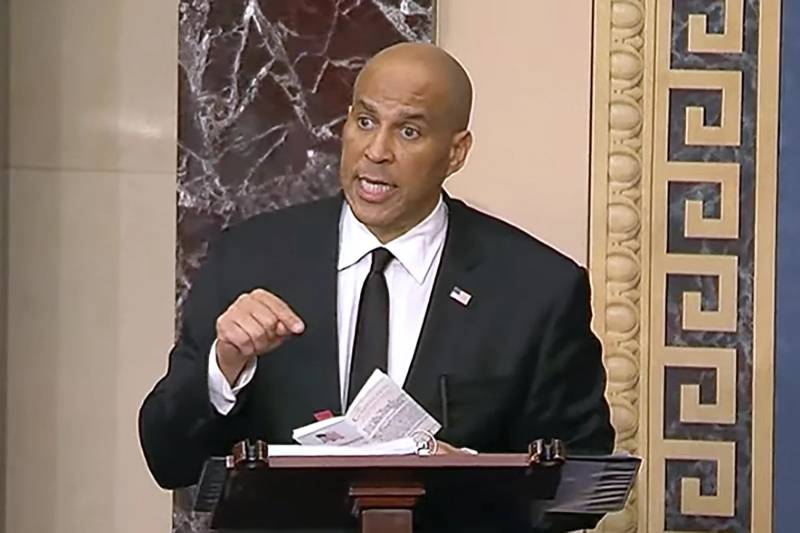
Updated 5:30 p.m. Tuesday
Sen. Cory Booker devoted all of Monday night and into Tuesday evening on the Senate floor, delivering an impassioned speech in protest of the Trump administration’s policies. This effort, which also involves numerous other Democrats, has set a record for the longest speech on record given in the chamber.
Booker wiped away tears and placed his hand over his heart as fellow Democrats, including House Democratic Leader Hakeem Jeffries, cheered. Some, like Sen. Tammy Baldwin, were seen crying, while Rep. Lucy McBath was seen comforting a woman beside her during the applause
“I wanted to not quite wrap this up yet,” he said, praising his staff for their support in preparing for the endurance speech.
The New Jersey Democrat took the podium at 7 p.m. ET on Monday, vowing to speak “for as long as I am physically able.” More than 24-hours later, Booker, who appeared visibly emotional and affected by the exhaustive speech, had broken the record for lengthiest remarks delivered.
Booker’s speech officially surpasses the previous record set in 1957 by noted segregationist Strom Thurmond. Thurmond filibustered for 24 hours and 18 minutes to oppose the Civil Rights Act.
Booker’s achievement stands in stark contrast to Thurmond’s efforts to deny Black Americans equal protections under federal law.
Sen. Chris Murphy, D-Conn., an ally and friend of the New Jersey Democrat Booker, took the floor briefly during the marathon speech to commend Booker for his perseverance and to highlight the difference between Booker’s advocacy for social justice and Thurmond’s attempts to uphold a status quo of racial inequity.
“What you have done here today, Sen. Booker, couldn’t be more different than what occurred on this floor in 1957. Strom Thurmond was standing in the way of inevitable progress towards equal political and economic rights for Black Americans,” Murphy said.
“Today, you are standing in the way, not of progress, but of retreat. You are standing in the way of retreat from the rule of law.”
By the evening, more than 115,000 people were watching Booker’s livestream on YouTube alone.
“I’ve been hearing from people all over my state and indeed all over the nation calling upon folks in Congress to do more, to do things that recognize the urgency, the crisis of the moment,” Booker said in a video posted to social media beforehand. “And so we all have a responsibility, I believe, to do something different, to cause — as [late Rep.] John Lewis said — ‘good trouble,’ and that includes me.”
Booker’s speech has taken aim at President Trump, White House senior adviser Elon Musk and policies that he says show a “complete disregard for the rule of law, the Constitution and the needs of the American people.”
The speech has covered a wide range of topics from health care and Social Security to immigration, the economy, public education, free speech and foreign policy. And it included portions of letters that Booker said he had received from affected constituents, as well as public comments from world leaders, in recent weeks.
“In just 71 days, the president has inflicted harm after harm on Americans’ safety, financial stability, the foundations of our democracy and any sense of common decency,” Booker said in his introductory remarks. “These are not normal times in our nation. And they should not be treated as such in the United States Senate.”
Trump and Musk have not commented publicly on Booker’s speech. It comes at a tense time for Booker’s party: Nine Democrats joined with Republicans to advance a Trump-backed spending bill last month, preventing a government shutdown but alienating constituents who want lawmakers to push back against the president’s agenda.
Booker did not pull out the phone book or children’s literature to read from, as some of his predecessors have done on the Senate floor. He has stayed focused on the topic of Trump’s agenda and how he says it is hurting everyday Americans — weaving together domestic and foreign policy concerns.
In the 15th hour, he said he still had “fuel in the tank.” About 16 hours and 24 minutes in, Booker looked at the time and said, “We are way behind the schedule of where we wanted to be at this point.” But he didn’t immediately move to wrap things up.
“And so to obey my staff, as senators are told to do, I want to move quickly to housing issues,” he said.
Booker paused for a brief prayer by the Senate chaplain at noon, following a long-standing Senate rule. Chaplain Barry Black specifically thanked “floor staff, Capitol police, stenographers, the pages and all those who have worked throughout the night.”
What are the rules?
The use of long speeches to delay legislation, known as a filibuster, is a time-honored tradition in the Senate. But that’s not technically what Booker’s speech is, since he is not trying to block a specific bill or nominee.
Under Senate rules, unless special limits on debate are in effect, a senator who has been recognized by the presiding officer can speak for as long as they wish, according to the Congressional Research Service.
“They usually cannot be forced to cede the floor, or even be interrupted, without their consent,” it says.
They must meet a few requirements, however. For one, the senator must “remain standing and must speak more or less continuously,” the Congressional Research Service states, which becomes more difficult as the hours pass.
Sen. Murphy posted on X on Monday night that Booker had employed an “interesting tactic” to that effect.
“Cory had a Senate page take his chair away to eliminate any temptation to sit down,” he wrote, just under three hours into the speech.
Booker employed another strategy at various points: permitting his fellow Democrats to ask questions, which is the only way a senator can yield without losing the floor. But it’s only partial relief: The senator must remain standing while others are talking.
“I will yield for a question while retaining the floor,” Booker responded each time a senator asked for his permission.
More than a dozen Democrats participated in the proceedings throughout Tuesday morning, including Murphy, Sen. Andy Kim of New Jersey, Sen. Peter Welch of Vermont, Sens. Dick Durbin and Tammy Duckworth of Illinois, Sen. Kirsten Gillibrand of New York, Sens. Tina Smith and Amy Klobuchar of Minnesota, Sen. Ron Wyden of Oregon, Sen. Raphael Warnock of Georgia, Sen. Chris Coons of Delaware, Sen. Mark Warner of Virginia, Sens. Elizabeth Warren and Ed Markey of Massachusetts, Sens. Chris Van Hollen and Angela Alsobrooks of Maryland, Sen. Maggie Hassan of New Hampshire and Sen. Ben Ray Luján of New Mexico.
What did other Democrats say?
The senators each spoke for several minutes about various issues Booker had mentioned, from Medicaid to tariffs to national security, veterans affairs, agriculture and housing. They asked Booker questions — giving him time to elaborate on their topics of choice — and applauded his persistence.
“I thank the gentlemen for his fortitude, his strength and the crystalline brilliance with which he has shown the American people the huge dangers that face them with this Trump-DOGE-Musk administration,” Senate Minority Leader Chuck Schumer said at the end of his second round of questioning on Tuesday morning, referring to the Department of Government Efficiency that Musk oversees.
Booker also heaped praise on his colleagues, talking up their accomplishments and shared work experience. While the tone of his speech was somber, there were some moments of levity between lawmakers.
At one point, Klobuchar — who had quoted Minnesota native Bob Dylan — asked Booker to name his favorite New Jersey musician, and he gracefully deflected.
Later, while responding to Schumer’s praise, Booker joked that “never before in history in America has a man from Brooklyn said so many complimentary things about a man from Newark.” When Schumer responded by saying they were both New York Giants fans, Booker reminded him that the team plays in New Jersey and would discuss it no further.
“This is not a colloquy,” he said with mock seriousness as those in the room laughed. “I hold the floor — I do not yield.”
How long can these speeches go?
Booker’s speech has been a marathon effort.
His efforts surpass those of Murphy, who led Democrats in a push for gun control legislation that lasted 15 hours, after the Pulse nightclub shooting in 2016 in Orlando, Florida. Booker was by his side for that entire speech and said Tuesday that Murphy had returned the favor.
Republican Sen. Ted Cruz of Texas held the floor for 21 hours and 19 minutes as he advocated unsuccessfully for defunding the Affordable Care Act in 2013 — more than eight hours longer than Republican Sen. Rand Paul of Kentucky did when he filibustered John Brennan’s CIA nomination months earlier.
The longest filibuster on record had been Thurmond’s 1957 speech that lasted for 24 hours and 18 minutes.
Media reported at the time that Thurmond sustained himself with “diced pumpernickel and bits of cooked hamburger” and sips of orange juice. His aides set up a bucket in the cloakroom so he could keep a foot on the Senate floor if he needed to relieve himself.
Trump’s April 2nd ‘Liberation Day’ 1 Apr 4:05 PM (2 days ago)

President Trump is promising that tomorrow will be “Liberation Day” when he rolls out another round of tariffs. California, a major trading partner with Mexico and Canada, is right in the cross hairs of the tariff tumult. Scott is joined by Christopher Thornberg, an economist and founding partner of Beacon Economics, to unpack the impact on California industries.
Democracy in the Dark: How California Lawmakers Are Trying to Shield Themselves From Public View 1 Apr 3:00 PM (2 days ago)
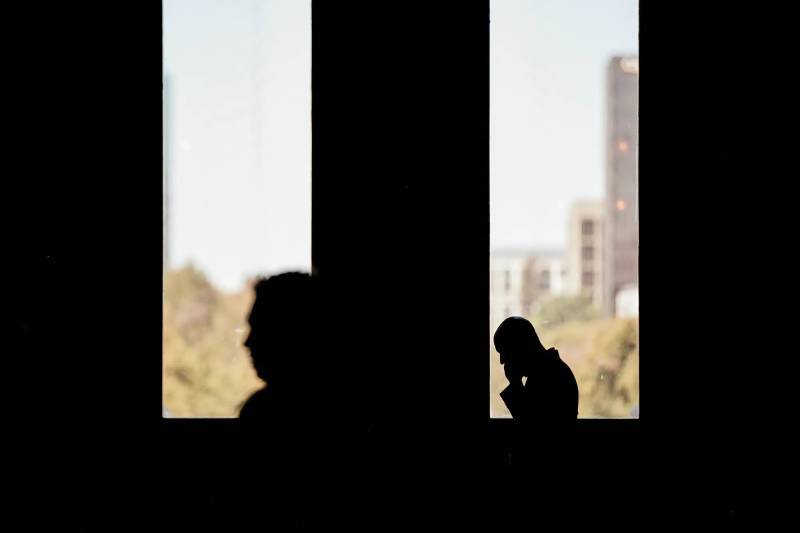
This story was originally published by CalMatters. Sign up for their newsletters.
At town halls across the nation, including in California, residents have confronted their members of Congress face-to-face to voice their fears and frustrations over Trump administration policies, from cuts to overseas aid to Medicare.
Meanwhile, lawmakers in the state Legislature have introduced about a dozen proposals that would make it harder to confront your local officials at public meetings and would shield more information from the public eye, according to an analysis of CalMatters’ Digital Democracy database.
The bills follow a streak of California officials’ attempts to shroud themselves in secrecy.
Gov. Gavin Newsom recently sent burner phones to major California business leaders with his number preprogrammed — paid for by his nonprofit, allowing him to communicate with executives without having to disclose the content publicly. Lawmakers and government employees signed non-disclosure agreements preventing them from sharing details about taxpayer-funded renovations to the state Capitol. The Legislature refused to say whether federal search warrants and subpoenas were served to lawmakers.
The largely Democratic efforts have raised alarms among ethics advocates and an outcry from some Republican lawmakers, such as Assemblymember Carl DeMaio of San Diego, who has introduced two bills to require lawmakers and government agencies to disclose more to the public, not less.
He announced them during National Sunshine Week, an annual campaign to promote government transparency that the Legislature quit observing eight years ago.
“It is the one time throughout the year where we pause and we ask the question: Are decisions in government being made in the public light? Can the people know what’s going on?” DeMaio said.
Looking decision-makers in the eye
Sen. Roger Niello, a Republican from Roseville, has contended that interacting with constituents in-person makes a difference: There’s nothing more thrilling for a local elected official than having constituents exercise their right to yell and scream at you, he said in 2023 opposing a proposal that allows neighborhood councils in Los Angeles to meet remotely until 2026.
“It’s just much more impactful,” he said. “It’s like the difference between a text message and a phone call. Text messages are useful for quick communication of something, but not for something more complicated.”
Nonetheless that proposal was signed into law — one of many over the past few years that have increasingly allowed state and local officials to participate remotely. This year, various legislators are pushing at least six different measures that aim to make them permanent.
Since the pandemic, California has relaxed its once-strict rules that required officials to be physically present at public meetings. Instead they’ve carved out more exceptions so that advisory board members can meet remotely, and public officials can avoid disclosing their whereabouts when they appear virtually.
Supporters of these efforts say they “modernize” the state’s open meetings rules, arguing that allowing members more remote access boosts public participation, cuts costs, protects officials’ privacy and grants more flexibility in emergencies.
Under the relaxed guidelines, 41 state boards reported increased attendance among board members, according to a June 2021 report by the Little Hoover Commission, a state oversight agency that focuses on government efficiency.
But good government advocates argue that it shields officials from their constituents.
“Public officials must be accountable: They should be required to attend in person, ensuring that the public can see them, speak to them directly, hold them responsible for decisions that impact their communities,” Dora Rose, deputy director of the League of Women Voters of California, told legislators at a recent hearing.

One of this year’s pending bills is SB 707 by Sen. María Elena Durazo, a Democrat from Los Angeles who last year opposed an effort to let local advisory boards meet remotely. This year she’s proposing an overarching measure that would include exemptions for different groups.
Durazo told CalMatters she was compelled by testimony from groups who had to cancel meetings because they couldn’t gather enough members in person.
Her bill would also require city and county governments to provide a call-in option to all public meetings. But during a recent hearing, representatives of city officials argued that would hamstring local governments’ ability to manage “Zoom bombing,” where participants disrupt meetings with “hate speech.”
Keeping donors secret
The California Fair Political Practices Commission — the state agency policing ethics and campaign finance violations — is sponsoring AB755 to give officials more time to disclose funds they raised for other groups.
Those funds are called “behested payments,” typically donations to a nonprofit or government agency that come at a politician’s behest. Critics say the donations allow special interests to curry favor with politicians. Since 2011, state officials have reported raising more than $505 million in behested payments, with Newsom single-handedly raising more than $200 million from corporations in 2020.
Current law requires elected officials to disclose these payments within 30 days once they raise more than $5,000 from the same donor within a year. But violations are commonplace: Six out of eight of California’s constitutional officers have reported their payments late, including Newsom, who was fined $13,000 for failing to disclose $14 million on time.
The legislation introduced by Assemblymember Mike Fong, a Democrat from Alhambra, would give lawmakers up to roughly 120 days to disclose the payments, making it harder for voters to know who is influencing their lawmakers in real time. Commission spokesperson Shery Yang told CalMatters the current filing period is too short and extending it “improves efficiency.”
After meeting the initial $5,000 threshold for disclosure, officials would be allowed to receive up to $999 from that same donor without ever disclosing it.
A related bill — SB 760 by Sen. Ben Allen, an El Segundo Democrat — would let elected officials stop reporting funds they raised for nonprofits on TV or radio, or even in speeches like private fundraisers, if they don’t benefit financially from those payments or don’t know their efforts led to the contribution. Allen said the change is needed so officials aren’t afraid to name specific groups to donate to, especially after a disaster like the Los Angeles fires.
Also seeking to relax the state’s campaign ethics rules is SB 300 by Sen. Steve Padilla, a Chula Vista Democrat. Public officials wouldn’t have to recuse themselves if they are making policies that would boost the membership of organizations they’re part of, such as unions or chambers of commerce.
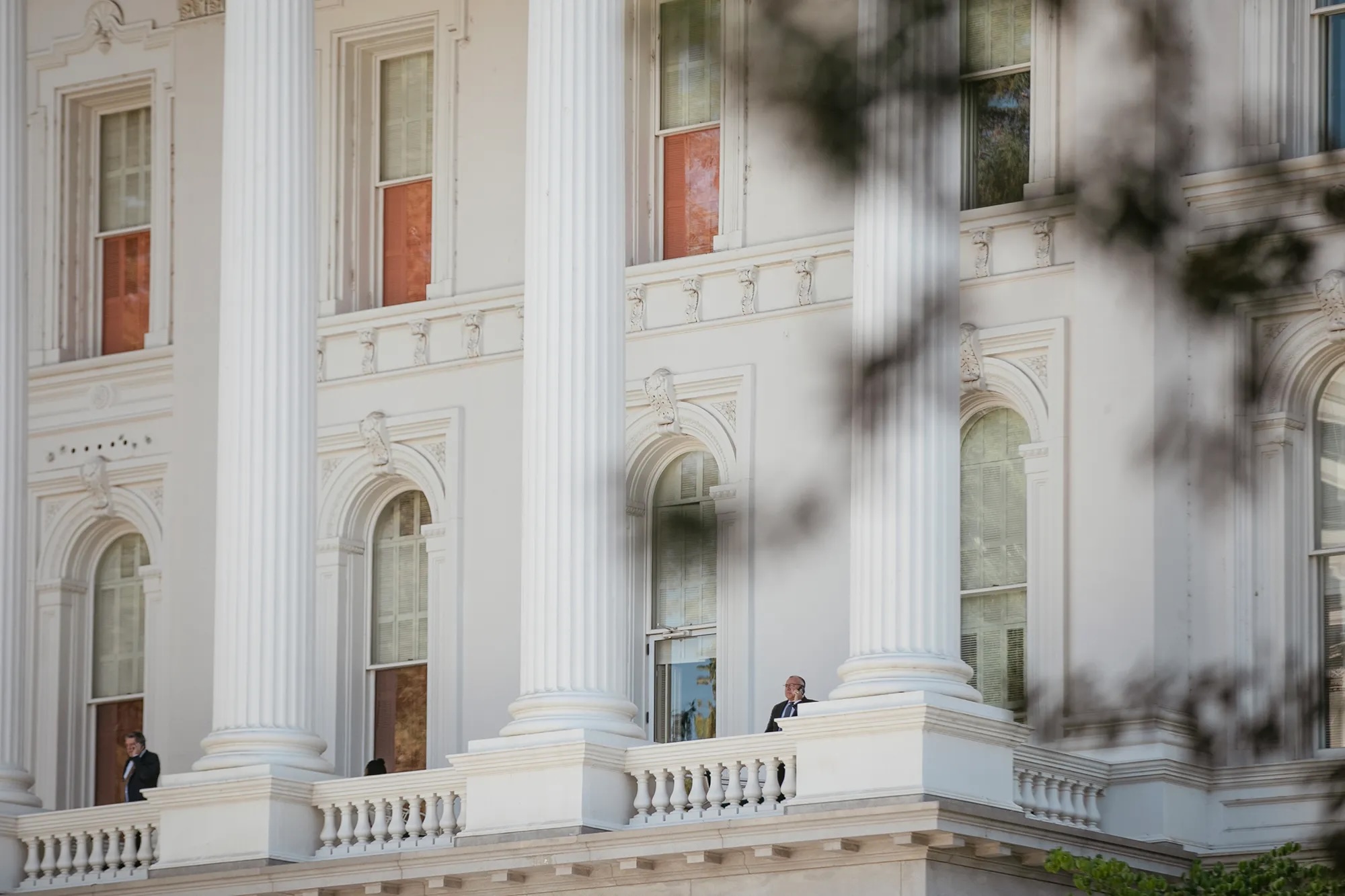
Other proposed legislation would also reduce the amount of information disclosed to the public.
- AB 950 by Lakewood Democrat José Solache would allow campaigns to stop disclosing their top funders on printed ads and refer to a website instead.
- AB 359 by San Bernardino Democrat James Ramos would allow the state campaign finance commission to stop reporting on its enforcement of local ethics rules.
‘What they want is carte blanche authority to police in secret’
While the state’s public records laws already are riddled with exemptions, politicians are still trying to create more.
Perhaps the biggest exception the Legislature created is for itself. In 1975, it wrote its own rules that vastly restrict what it must release to the public, shielding notes to members or staff, records of complaints or investigations, and anything else it deems not in the public’s interest to know.
This year — after a 2018 law forced police agencies to be more transparent about their records — Downey Democratic Assemblymember Blanca Pacheco wants to roll some of that back. Her bill would give law enforcement agencies more leeway to keep some information private, such as the ranks, names and photos of officers who work undercover, are part of a state or federal task force, or who received death threats in the last decade due to their work.
“I just want to protect these undercover officers so that they can continue doing their work and keeping our communities safe,” she told CalMatters.
Tiffany Bailey, a staff attorney for the American Civil Liberties Union of Southern California, said the legislation undermines the progress made on police transparency. Police agencies already have ways to redact information, she said, but law enforcement agencies must explain why.
“What they want is carte blanche authority to police in secret, to shield from the public eye really egregious police misconduct, like sexually assaulting civilians and serious uses of force,” Bailey said.
David Loy, legal director of the First Amendment Coalition, said California already lags behind other, more conservative states in what is released.
“There’s all kinds of qualifications and exemptions and opportunities to put sand in the gears and delay disclosure, and it’s still a pretty limited set of documents you get,” he said.
Often, local and state agencies have only released records when a court forced them to do so.
Loy’s group is also concerned about a proposal from Long Beach Democrat Josh Lowenthal that would make it a misdemeanor for someone to “knowingly” post an elected or appointed official’s home address or telephone number, if they intend the posting to cause harm.
Lowenthal declined an interview with CalMatters, but said in a statement that elected and appointed officials have faced harassment or violence in recent years and this would “allow them to limit the proliferation of their information.”
Loy countered that the bill, while still in its early stages, is overly broad.
“There are controversies over whether someone is a resident of the jurisdiction that they are elected to represent, and the press and public have a right to know the relevant information,” he said.
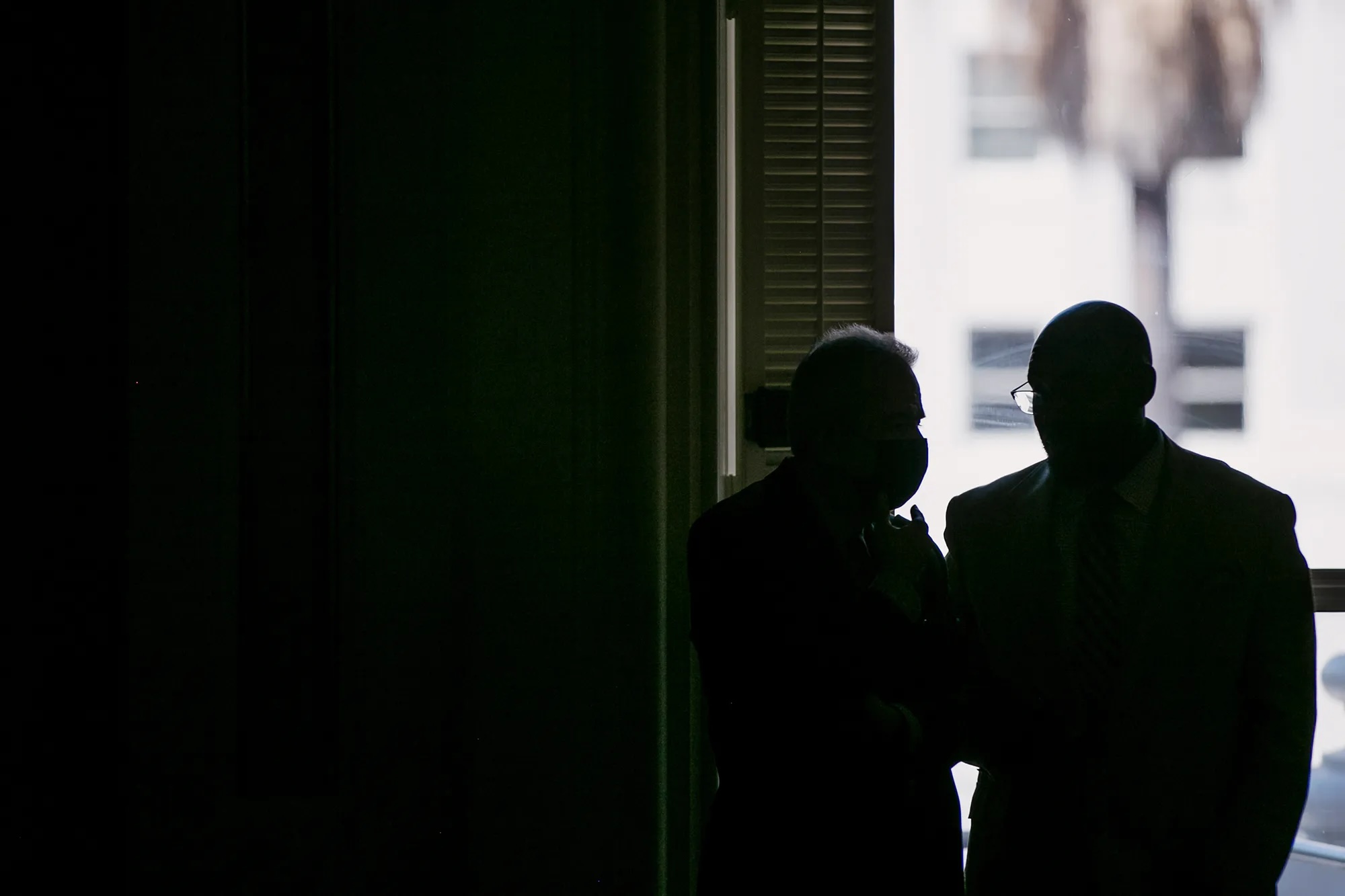
Let the sunshine peek in?
There are a few glimmers of hope for public access, though.
Under Democratic Assemblymember Avelino Valencia’s proposed AB 1029, elected officials would have to report if they own cryptocurrency.
DeMaio, the San Diego Republican, is also reintroducing an idea to create an independent office to help people fight public records denials. Newsom vetoed a similar bill in 2023, saying it was unnecessary and costly.
Currently, the only way to appeal a rejected Public Records Act request is to sue — something not everyone can afford to do.
“Let a neutral third party determine whether a document is so sensitive that the public interest would be benefited by keeping it a secret,” DeMaio said.
He also introduced a bill to make the Legislature follow the same California records act as other public agencies and touted his Rocklin Republican colleague Joe Patterson’s AB 1370, which would prohibit state lawmakers from entering into most non-disclosure agreements related to their decision-making, such as the Capitol renovation project.
“There is no justification for an elected official signing an NDA with a special interest, full stop,” he said.
This article was originally published on CalMatters and was republished under the Creative Commons Attribution-NonCommercial-NoDerivatives license.
Late Storms Boost California’s Snowpack, Hitting a 3-Year Streak Not Seen in Decades 1 Apr 2:16 PM (2 days ago)

After a boost from late-season storms, the California snowpack is coming into April at nearly 100% of average for the third year in a row — a streak that hasn’t happened since the end of the 1990s, according to state climatologist Mike Anderson.
Farmers and cities across the state rely on this frozen reservoir for water supplies as the snowpack melts in spring and summer.
Across the northern Sierra Nevada and southern Cascade peaks, the snowpack is at 118% of the historical April 1 average; it’s 91% and 84% in the central and southern Sierra, respectively. Statewide, it sits at 96% of average.
“Snow-wise, we’re in pretty good shape,” said Andy Reising, manager of snow surveys and water supply forecasting for the California Department of Water Resources. “There were some indicators that we might have a dry year, but fortunately, the storm windows have stayed open and given us a good boost in February and March.”
The last three years of wet winters might have something to do with human-caused climate change, Anderson said, because “in a warmer world, the atmosphere has more energy to work with. We see these weather patterns kind of having a little more kick.”
Reservoir levels statewide, meanwhile, are mostly above average. Lake Shasta, the state’s largest reservoir and part of the federal Central Valley Project, is at 113% of its average capacity for April 1. Lake Oroville, the biggest reservoir within the State Water Project, is at 121% of average.
“The reservoirs are functioning as intended to kind of have a little bit of a buffer and then work with what Mother Nature provides each year,” Anderson said.
Over the next two weeks, the federal Climate Prediction Center forecasts below-average precipitation across California. Anderson’s larger worry is that the snow could melt quickly during potentially warm to extremely warm periods forecasted for later this spring and early summer. In turn, that rapid snowmelt could cause grasses to grow quickly, leading to fuel for early season grass fires.
Cooler temperatures, on the other hand, would allow for a more moderate rate of snowmelt that would feed reservoirs without overwhelming them or leading to overgrowth of grasses.
“As we have longer days, that means more opportunity for more energy to move into the pack, getting it ready to melt,” Anderson said. “The longer we stay above freezing, the more opportunity for that water to start moving through the watershed.”
Andrew Schwartz, director of the UC Berkeley Central Sierra Snow Lab, said all the snow over the last week has created the perfect conditions for winter sports enthusiasts in the Lake Tahoe area.
“If you’re a skier or snowboarder, I encourage you to get up here because conditions are fantastic,” Schwartz said.
He expects the snowpack to grow even more in the coming days as a storm continues to pelt the Sierra with as much as another foot of snow.
“We’re sitting pretty good without a huge amount of deficiency; warm temperatures are the big concern now,” Schwartz said.






